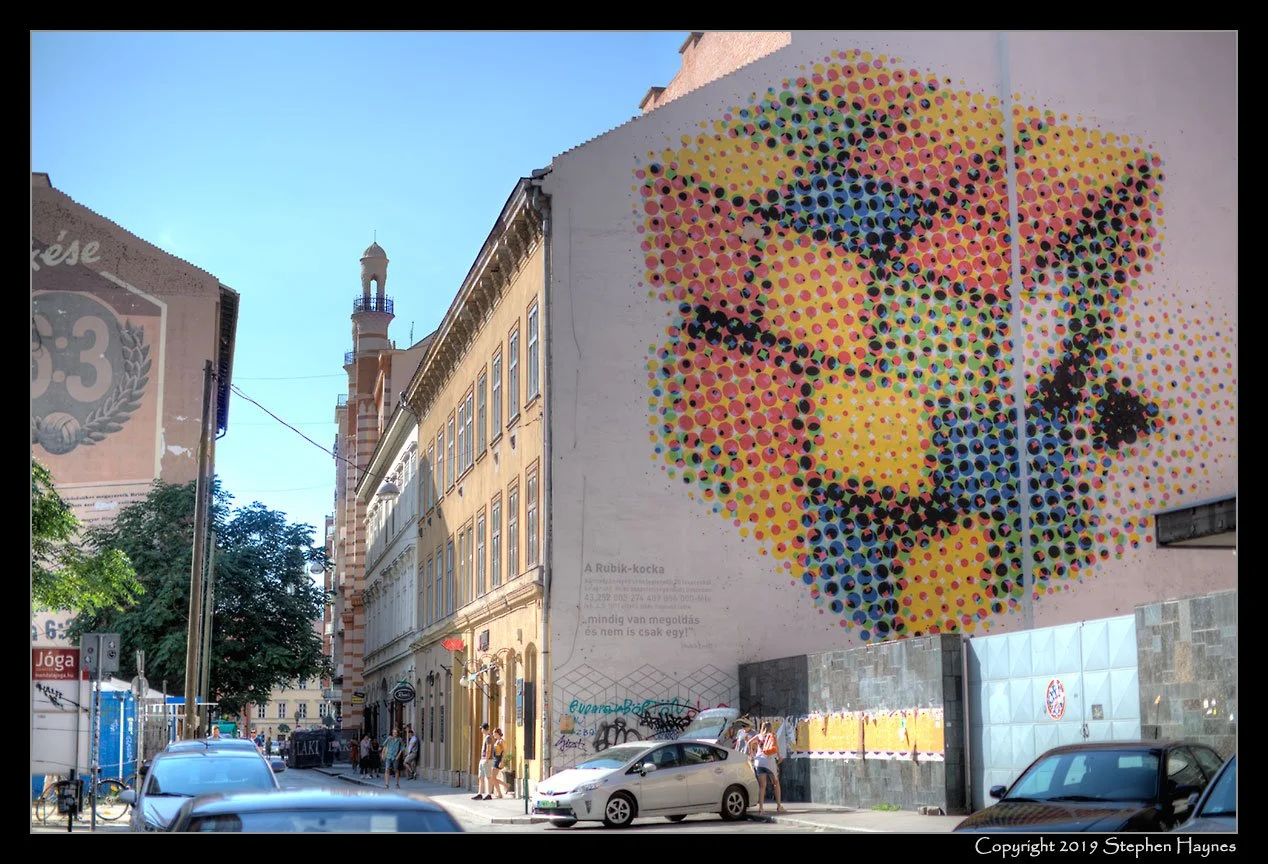Viking Grand European Cruise - June-July 2019
My wife and I took a Viking "long ship" cruise from Budapest to Amsterdam, with an initial three nights in Prague and an extended stay in Amsterdam. All told, three weeks in Europe.
Fifteen hundred photos taken, which is a fairly modest number given the length of the trip. After culling photos not meeting my standards for quality, about 800 photos remained, of which these are a relatively small selection. Rather than offer a "travelogue" presentation, I've divided photos into four groups: 1) Best Photos (often including people); 2) Castles and ruins thereof seen along waterways we traversed; 3) Cathedrals, churches and synagogues visited, often with high dynamic range photos of interiors; and 4) Villages and their associated vineyards.
Each category yields its own rewards, and I consider a very small number of the photos to be outstanding, although I'll leave to your own judgment which (if any) those might be.
Best Photos.

Prague - Castle Security

Prague - Musician on Charles Bridge
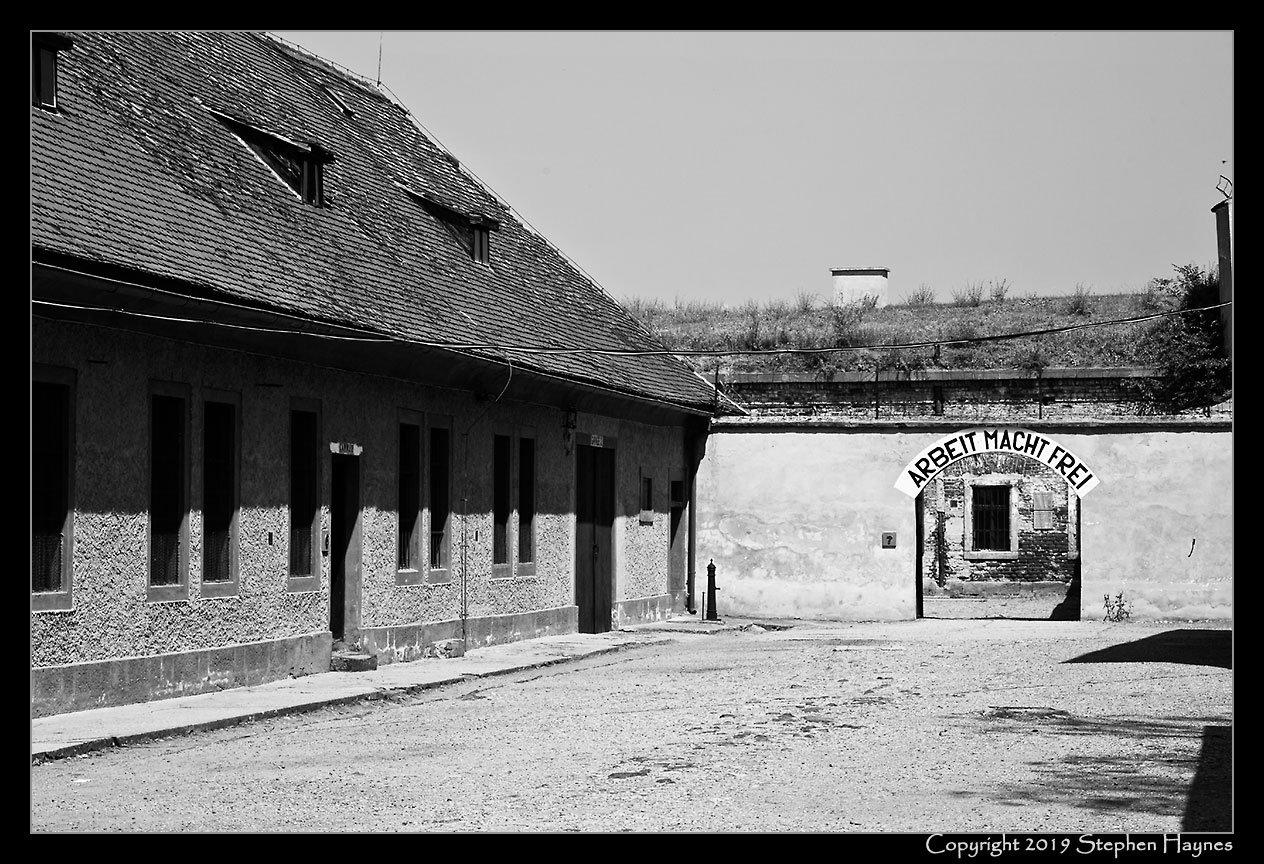
Terezin (AKA Theresienstadt Concentration Camp) - "Arbeit Macht Frei" -- I was frankly taken aback when seeing "Arbeit Macht Frei" (German: "Work will make you free") over this archway. Previously I had thought it uniquely associated with Auschwitz.

Terezin - I'm Brought to Tears -- A barracks room, where hundreds slept in the tiered bunks at right, ate in shifts at the table, and stored meager possessions in the cubbies at left. Malnutrition and disease were rampant, and corpses were not unusually found among the living each morning.
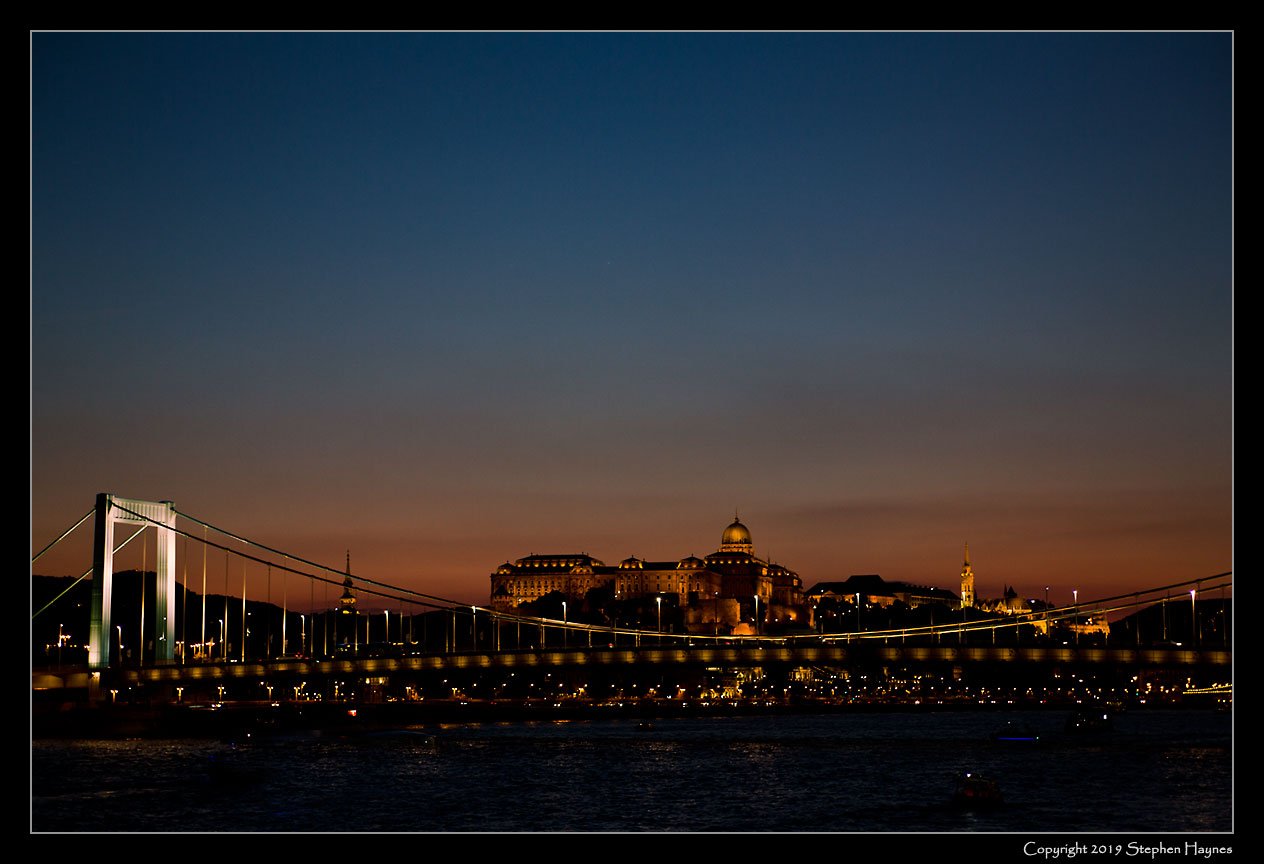
Budapest - 1st Night -- The castle and cathedral atop Buda's hill. We had spent June 27 traveling Prague to Budapest by bus, then had our first dinner aboard. I took this from the boat's top deck after dinner, using the tripod I'd brought for opportunities like this.
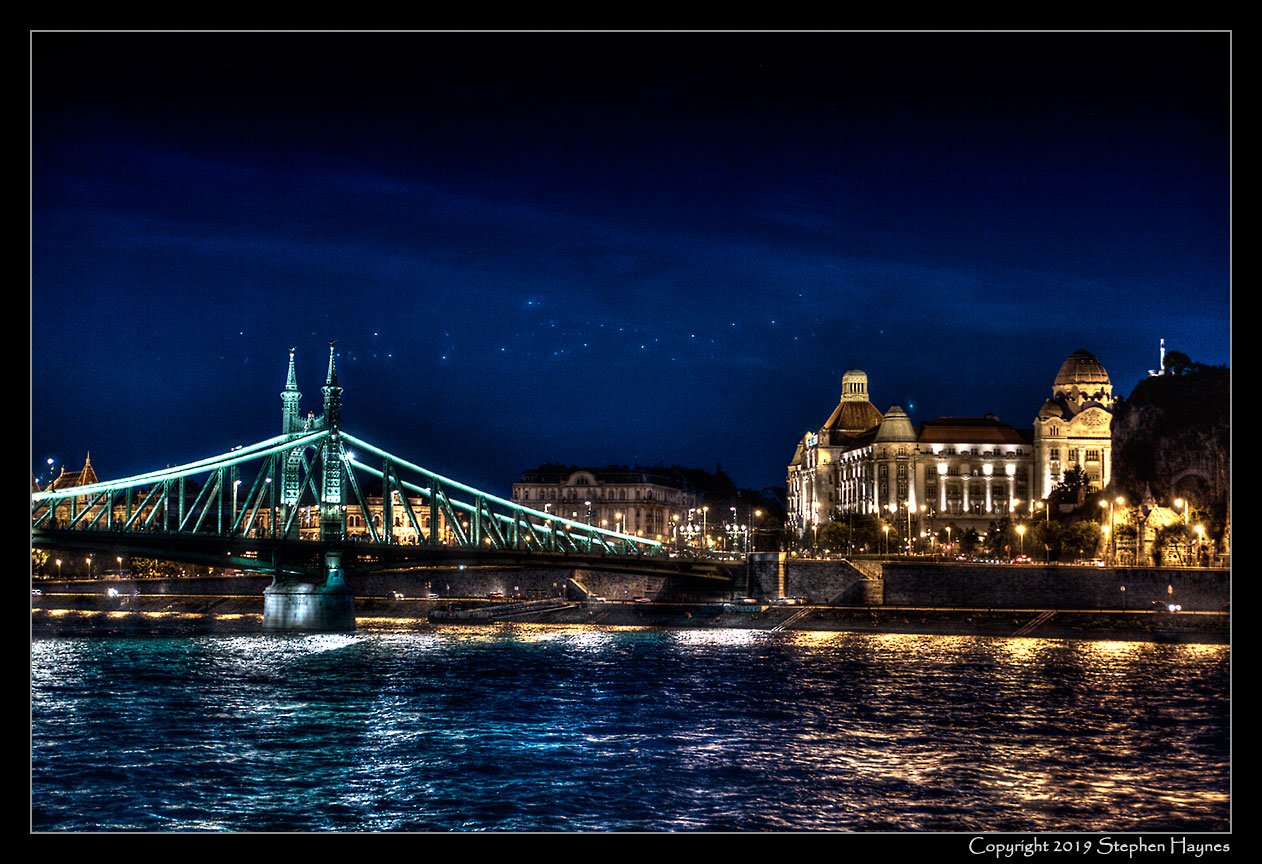
Budapest - 1st Night (an HDR image)

Budapest - Panorama from the Buda hills
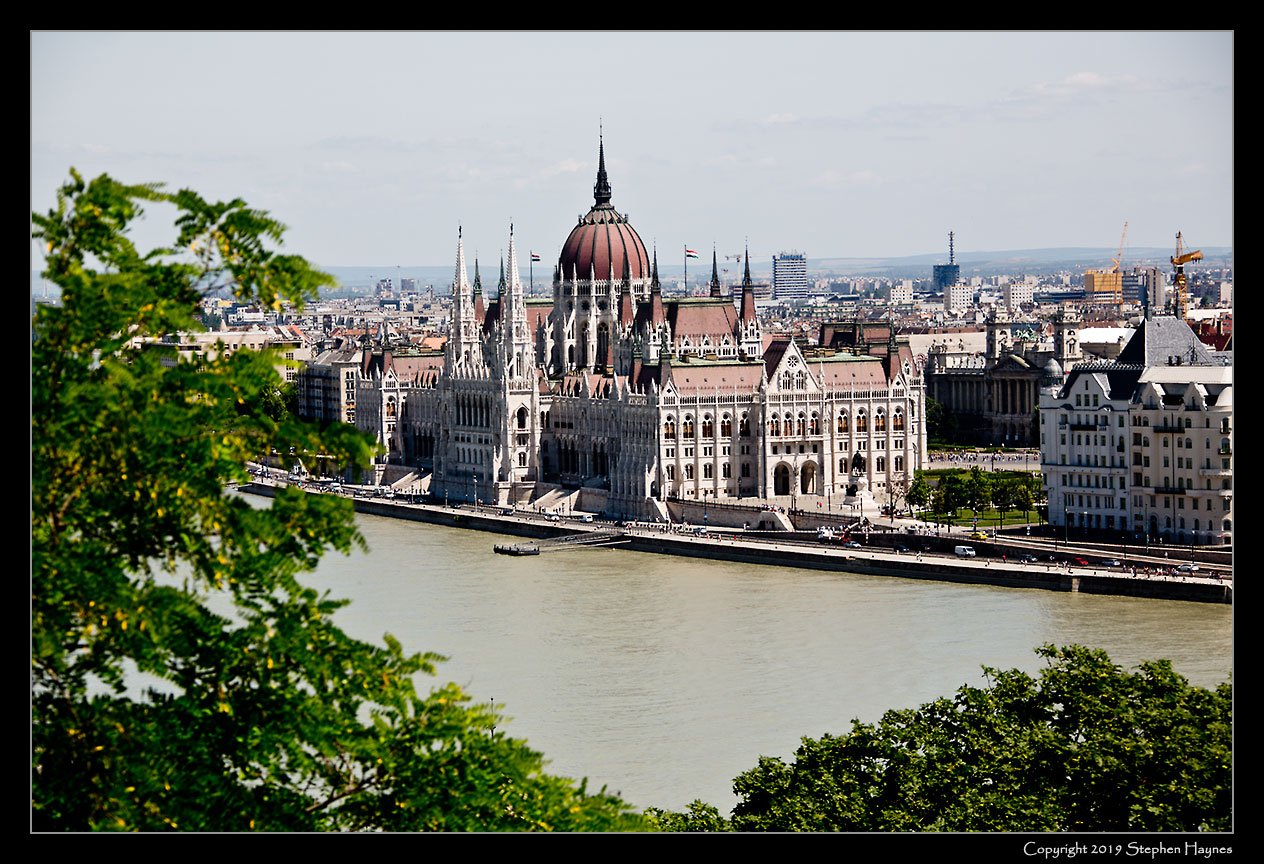
Budapest - Houses of Parliament
Budapest - Rubik's Cube -- Rubik's Cube was invented in Budapest in 1974 by Hungarian sculptor and professor of architecture Ernö Rubik. See https://en.wikipedia.org/wiki/Rubik%27s_Cube
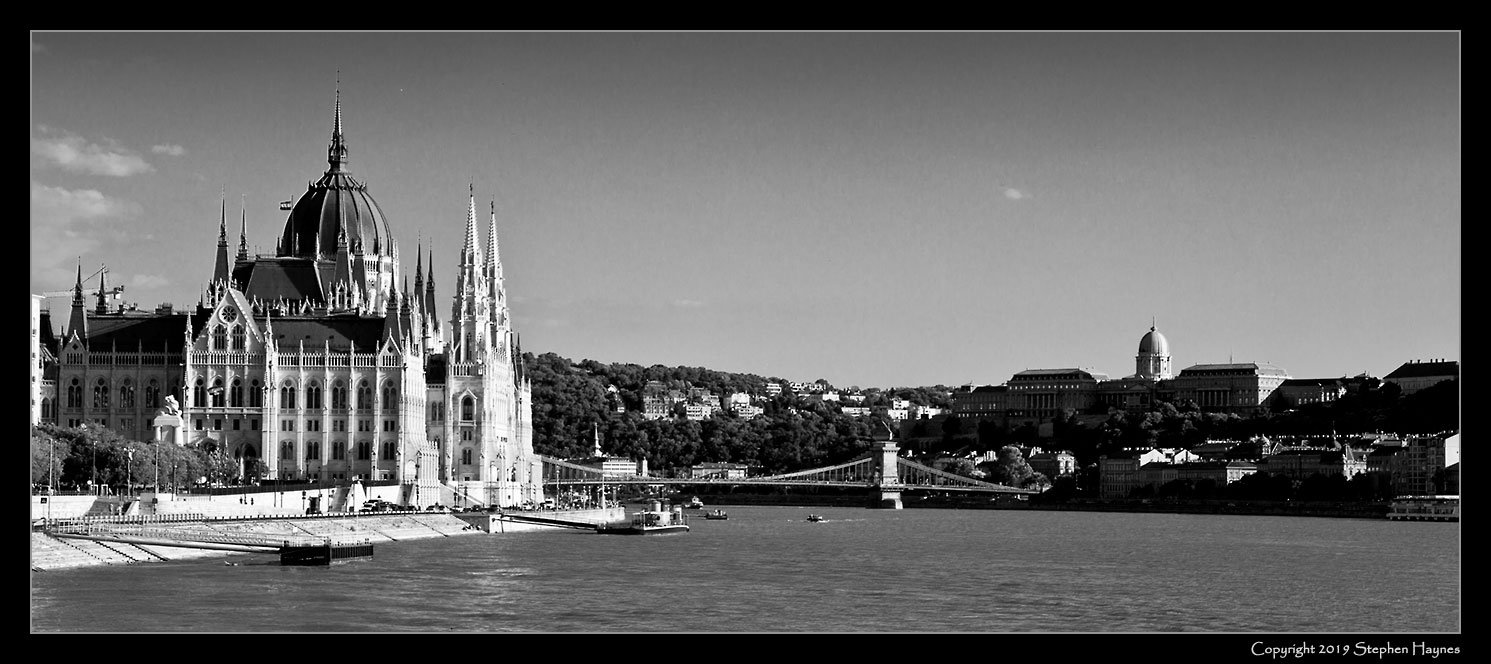
Budapest - Departing -- I had hoped for a departure after dark, when the Houses of Parliament are brightly lit. Being close to the summer solstice, however, our departure at approximately 6 p.m. was in bright sunshine, although shadows from the low sun provided this dramatic photo.
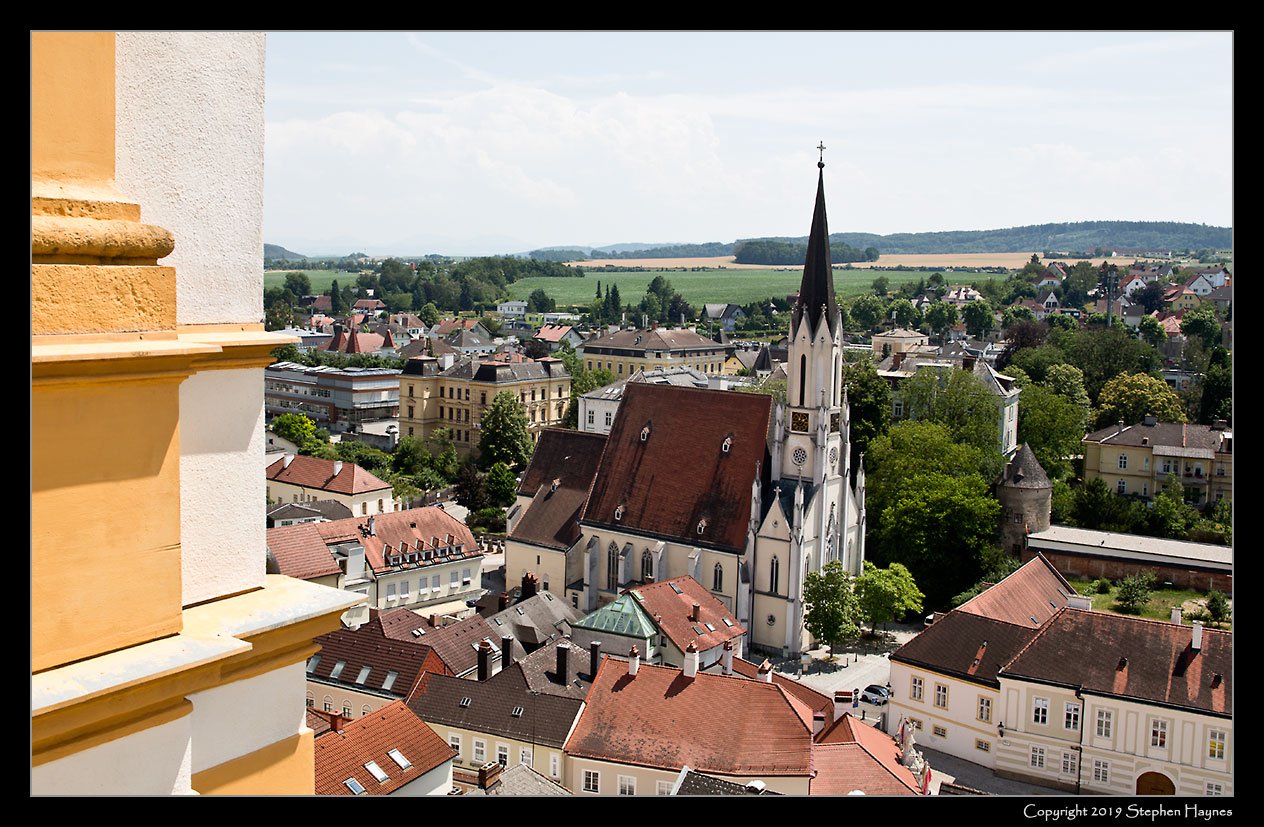
Melk -- We visited the huge, imposing Melk Benedictine Abbey. Here is the town of Melk as seen from the Abbey. Imagine being the parish priest of that small church with the Abbey looming above you.

Passau - Danube Panorama
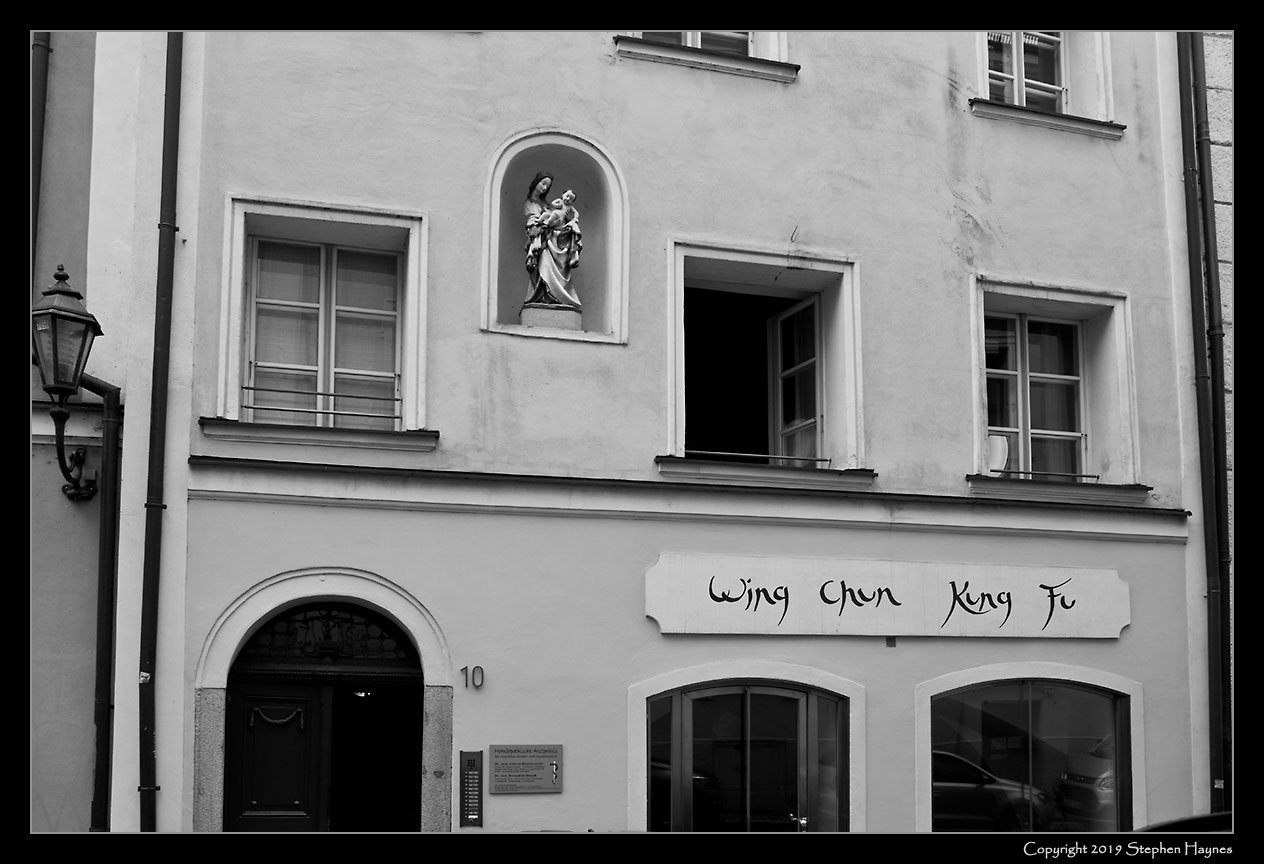
Passau - Culture Clash -- Mary and infant Jesus adorning the residence of a martial arts academy.
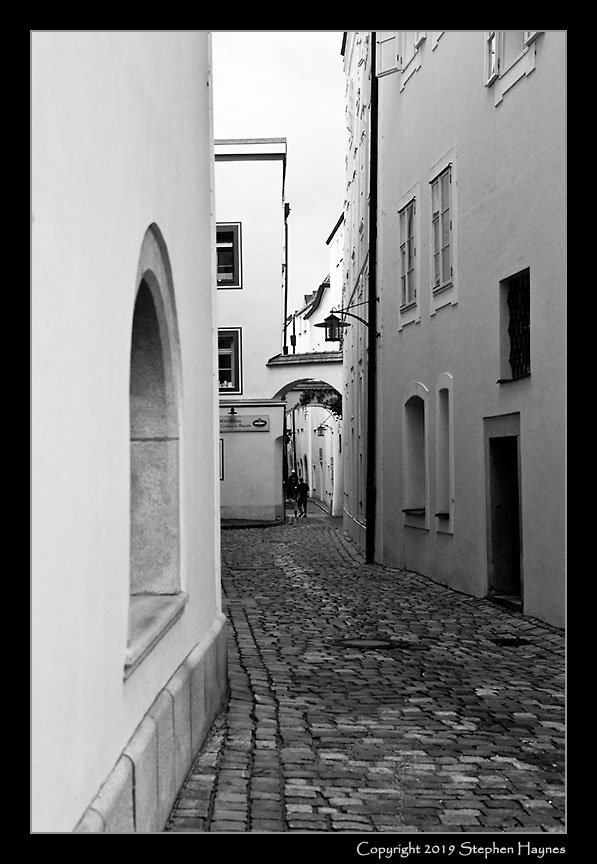
Passau - Angles and Cobblestones

Scharding - Flood Wall -- The wall is not decorative. Rather, it protects these houses from periodic floods of the Inn River.
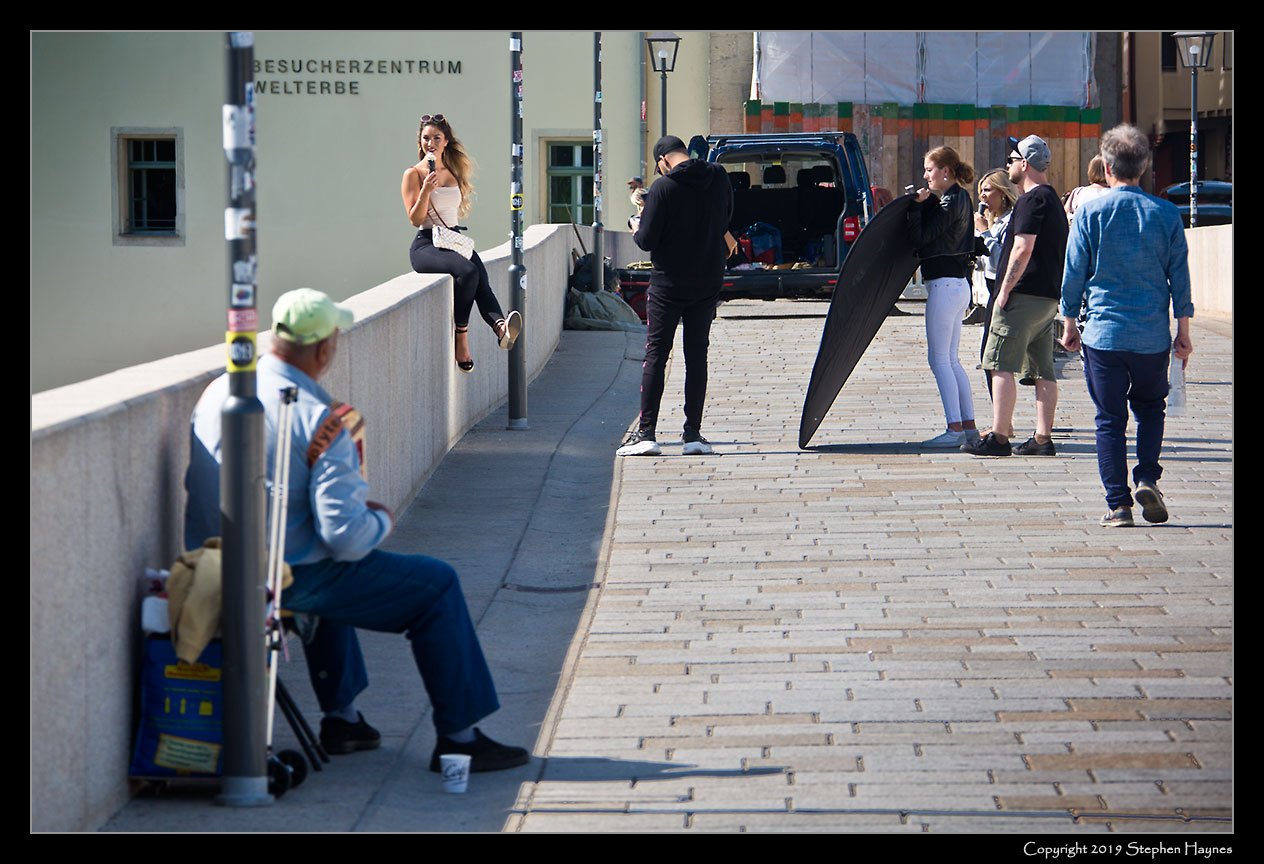
Regensburg - Ice Cream -- Some kind of video involving a pretty girl eating ice cream, atop Regensburg's Stone Bridge. Even the accordian-playing busker was distracted.
Regensburg - 1541 Religious Accord -- Legend on this house's facade, noting the accord that was reached here, historically called the Colloquy of Ratisbon, a conference held at Regensburg (Ratisbon) in Bavaria in 1541, during the Protestant Reformation, which marks the culmination of attempts to restore religious unity in the Holy Roman Empire by means of theological debate between the Protestants and the Catholics. Wikipedia: https://en.wikipedia.org/wiki/Diet_of_Regensburg_(1541)

Regensburg - Still Life (an HDR image)

Regensburg - Color Beyond (an HDR image)
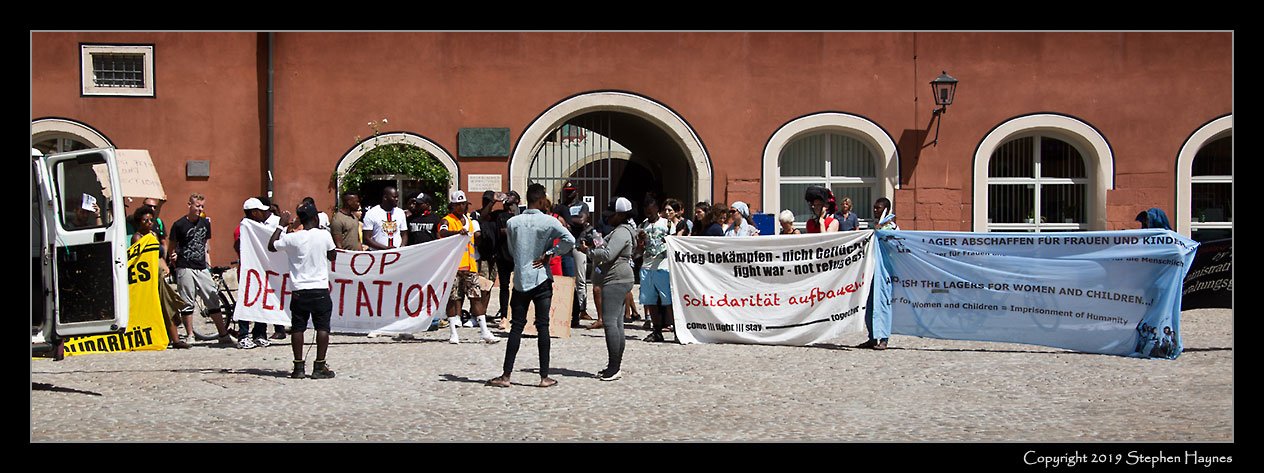
Regensburg - Protest -- Protest against deportation of immigrants and refugees, with Polizei parked in an alley nearby, just in case (next photo).


Nuremberg - Panorama -- All buildings seen here have been rebuilt in the past seventy-three years or so, as Nuremberg was essentially destroyed by bombing during WWII. See https://www.scrapbookpages.com/Nurnberg/Nurnberg01.html and https://en.wikipedia.org/wiki/Bombing_of_Nuremberg_in_World_War_II
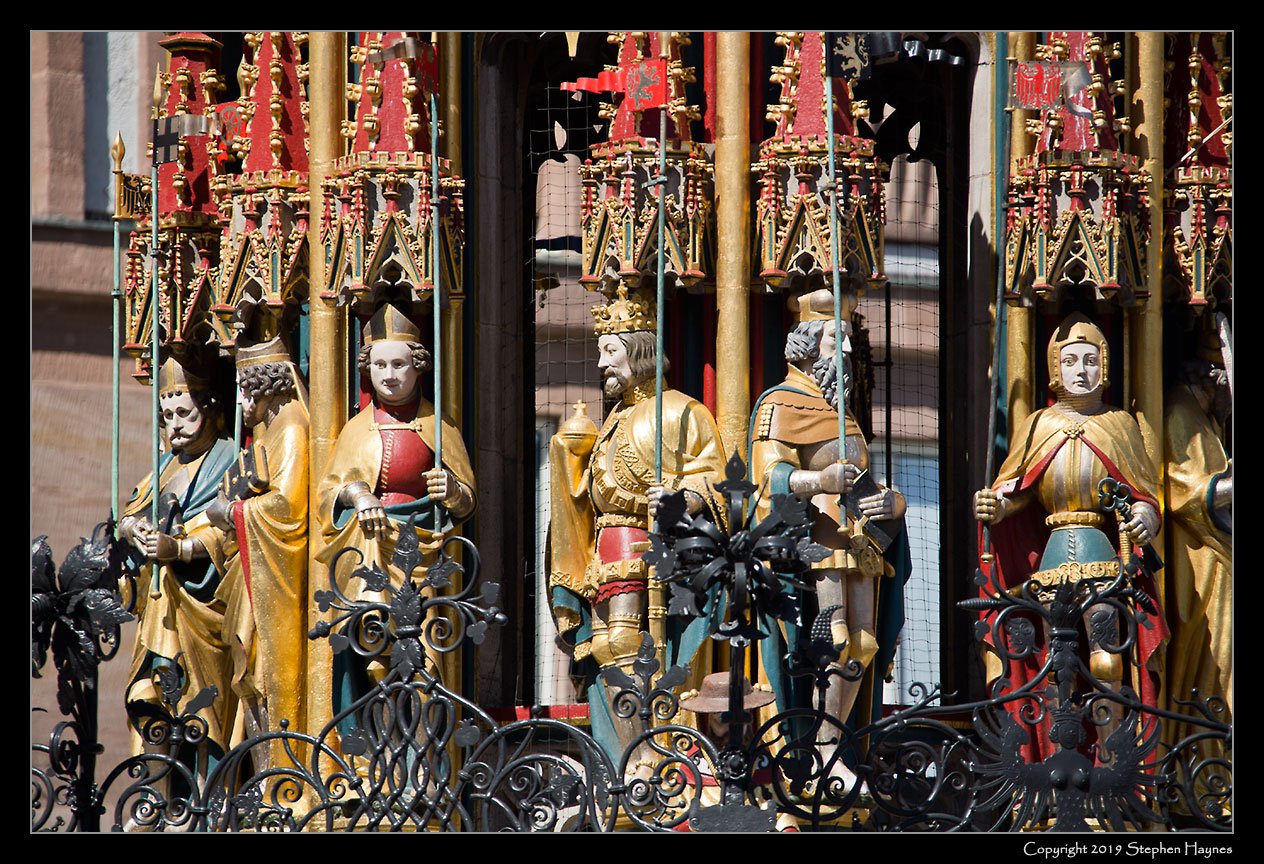
Nuremberg - Fountain -- Wikipedia: "Schöner Brunnen (English: 'beautiful fountain') is a 14th-century fountain located on Nuremberg's main market next to the town hall and is considered one of the main attractions of the city's Historical Mile. The fountain is approximately 19 meters high and has the shape of a Gothic spire."

Nuremberg - Fountain

Bamberg - Industrial Dock
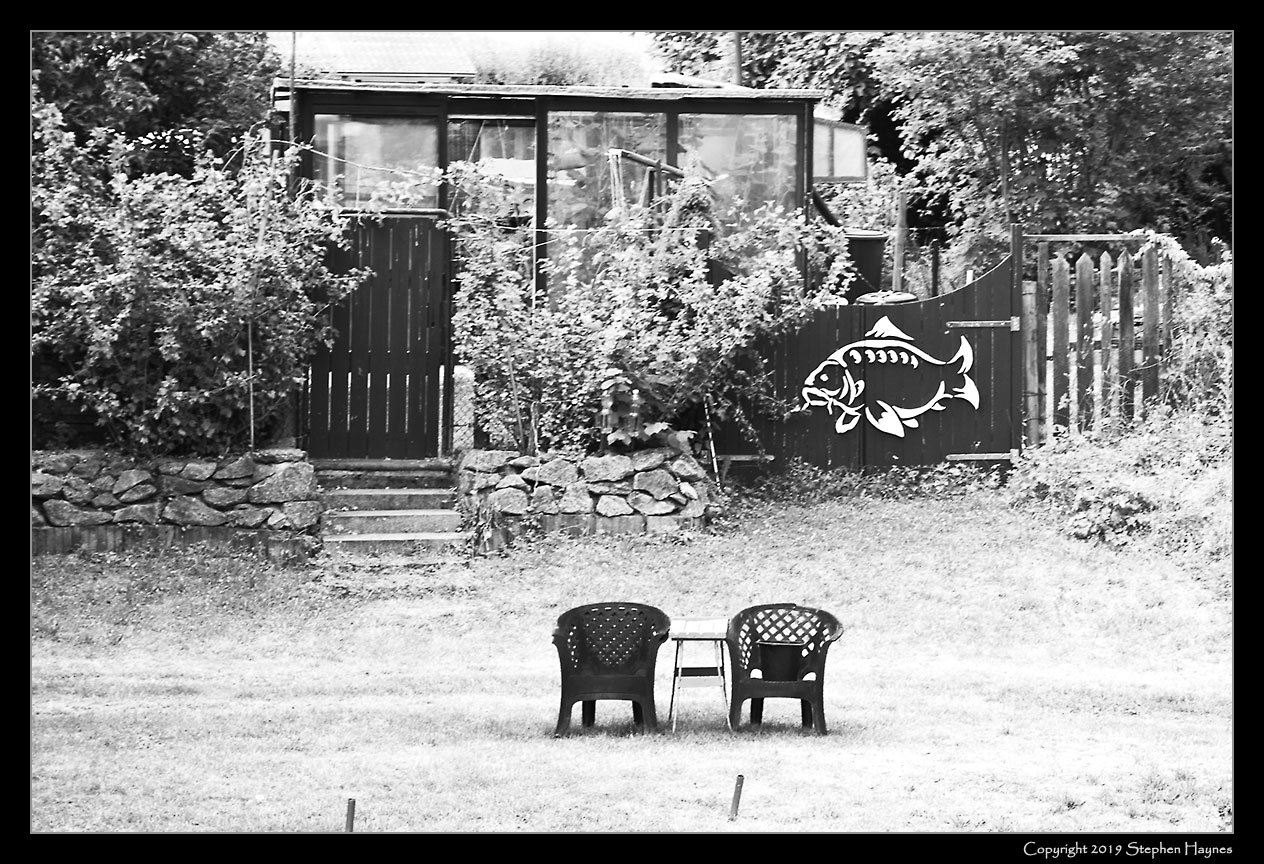
Main River - Watch the World Go By
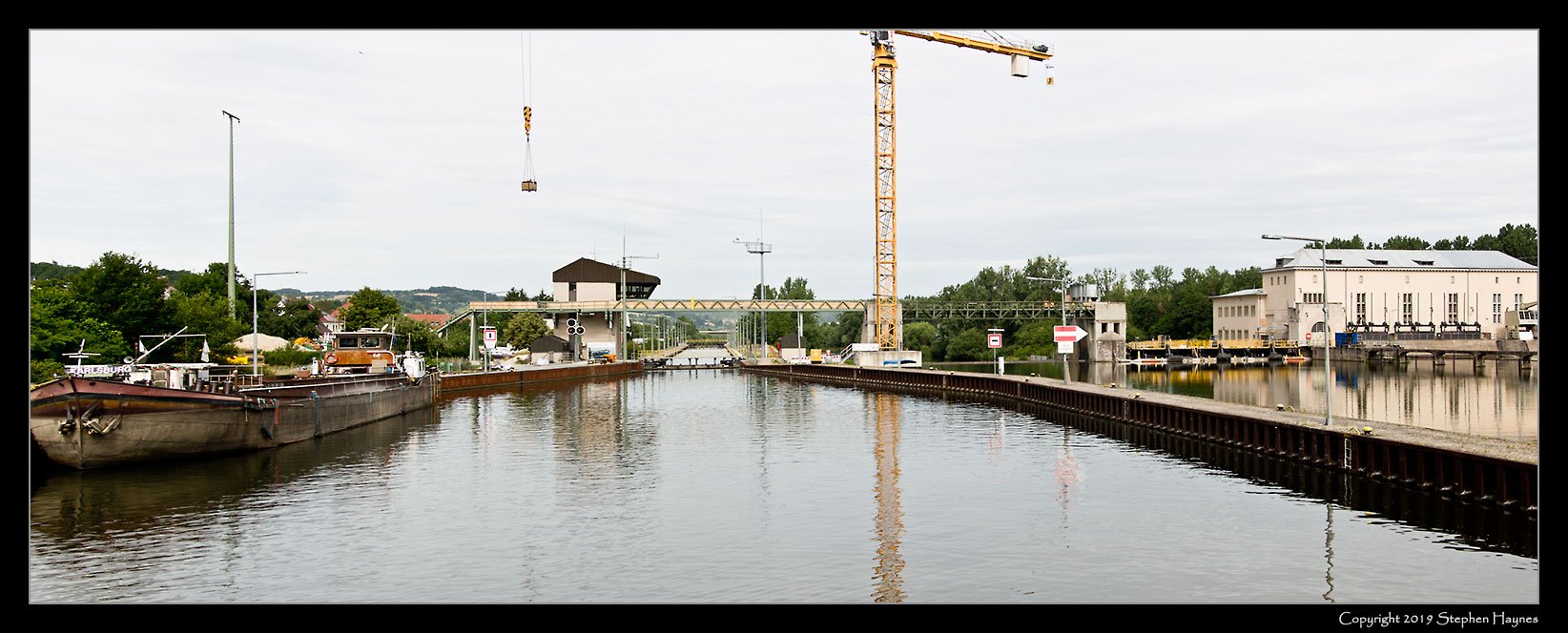
Main River - Lock
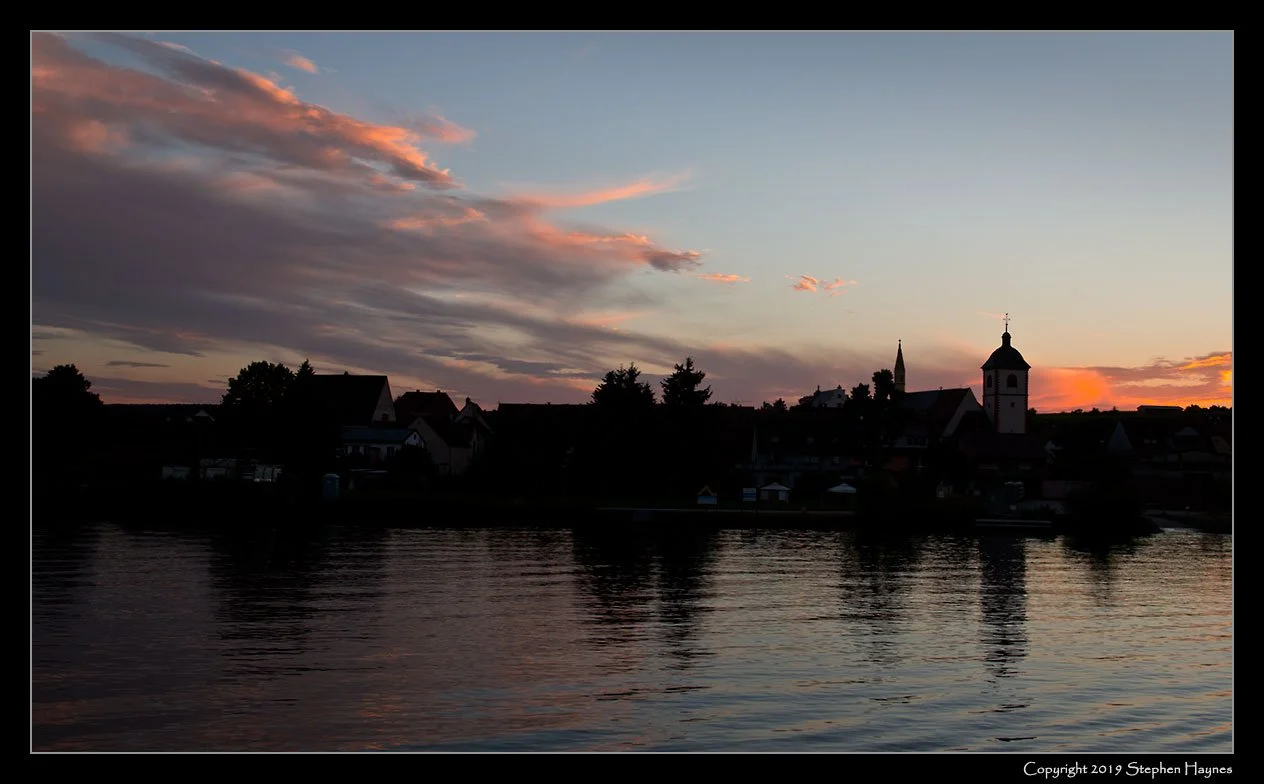
Main River - Tranquil Evening
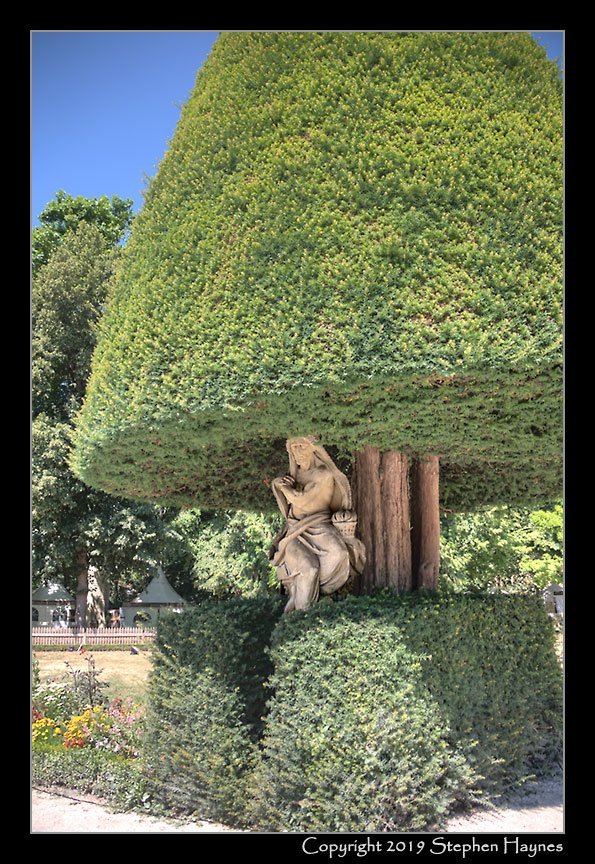
Würzburg - Residenz Topiary -- The Würzburg Residenz, formerly home to the city's Prince Bishop (a curious and unusual joining of secular and religous authority), is now a major tourist attraction. Very reminiscent of Versailles, unfortunately photographs within the building are prohibited. I photographed a bit in the adjacent gardens. See https://en.wikipedia.org/wiki/W%C3%BCrzburg_Residence. (An HDR photo.)

Würzburg - Merchant Downtime
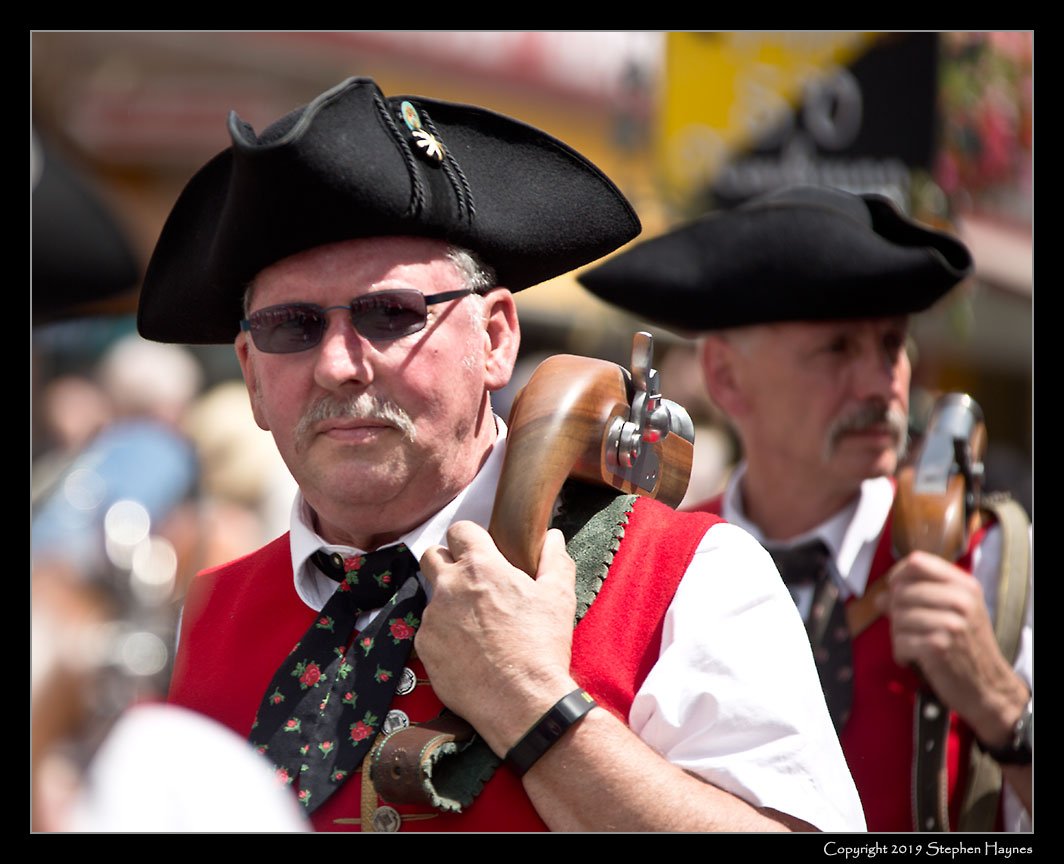
Würzburg - Kiliani Parade 1 - Our walking tour of Würzburg ended on the street down which was already coming the Kiliani Parade. See https://www.bavaria.by/experiences/city-country-culture/traditions-customs/folk-festivals-in-bavaria/kiliani-fair-in-wuerzburg/. “Kiliani” has a historic background: the missionary activity in Franconia by the Irish missionary bishop Kilian in around 686 AD. St. Kilian brought Christianity to Lower Franconia with his companions Colman and Totnan – in around 689 AD, they died the martyr's death. St. Kilian's Day is celebrated on 8th July. The so-called Kiliani octave is celebrated for eight days with various activities, services of worship and pilgrimages.

Würzburg - Kiliani Parade 2

Würzburg - Kiliani Parade 3

Würzburg - Kiliani Parade 4
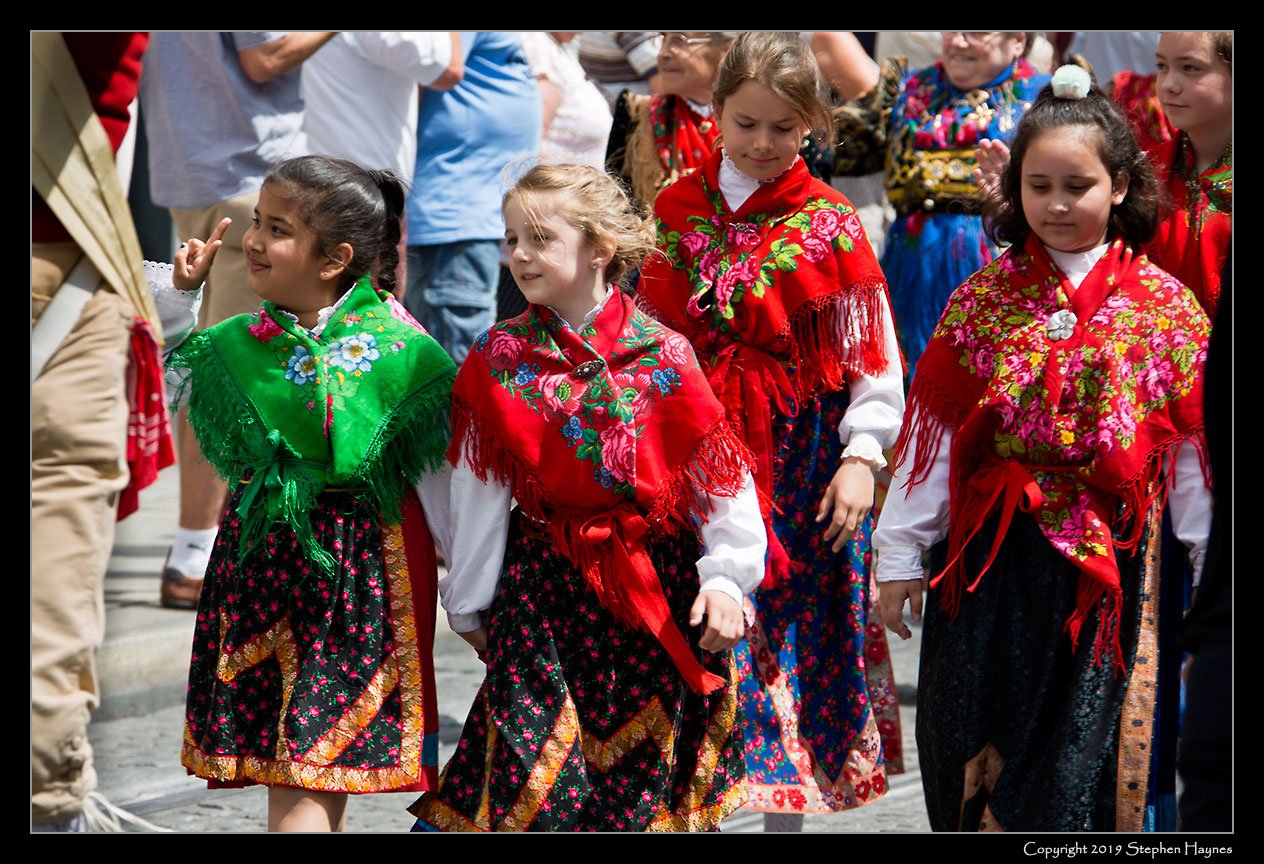
Würzburg - Kiliani Parade 5
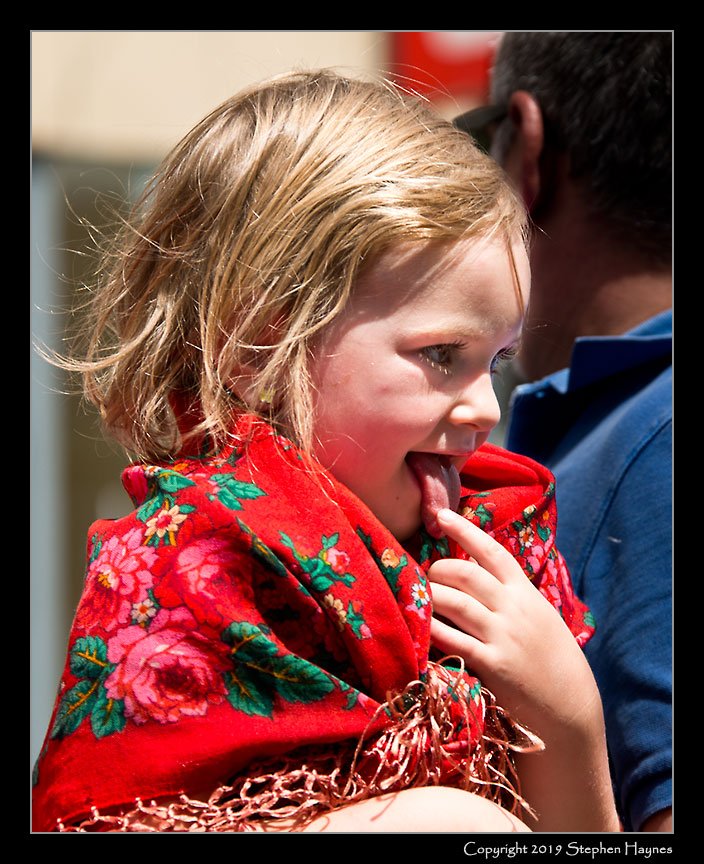
Würzburg - Kiliani Parade 6
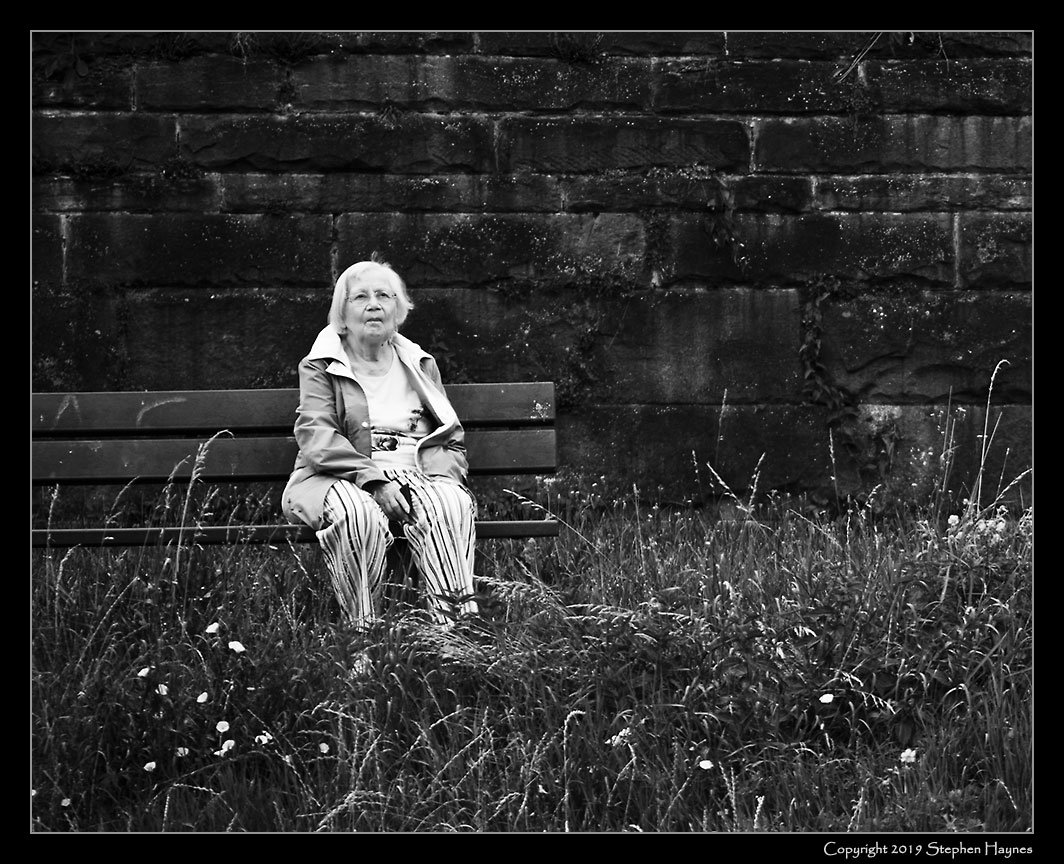
Wertheim - Pensioner Rest
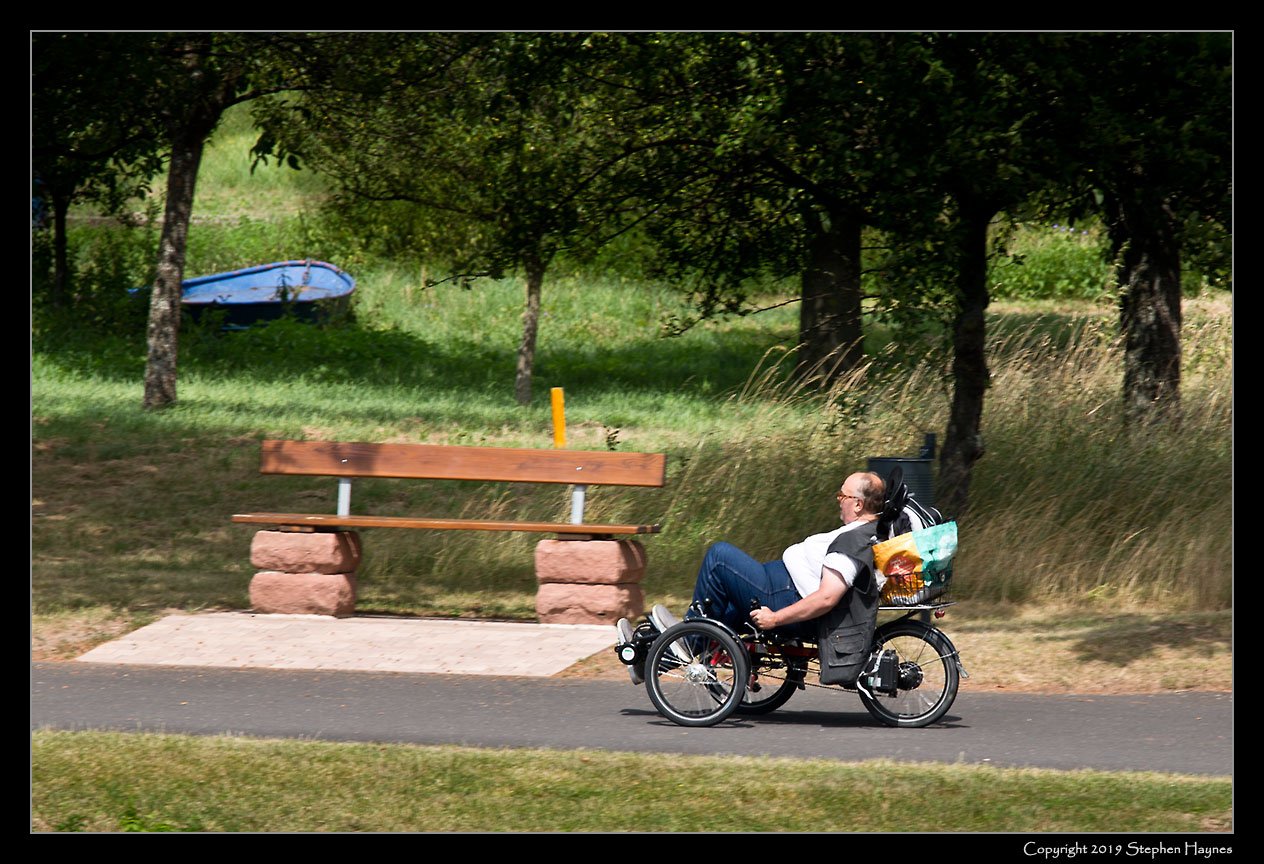
Main River - Exercise
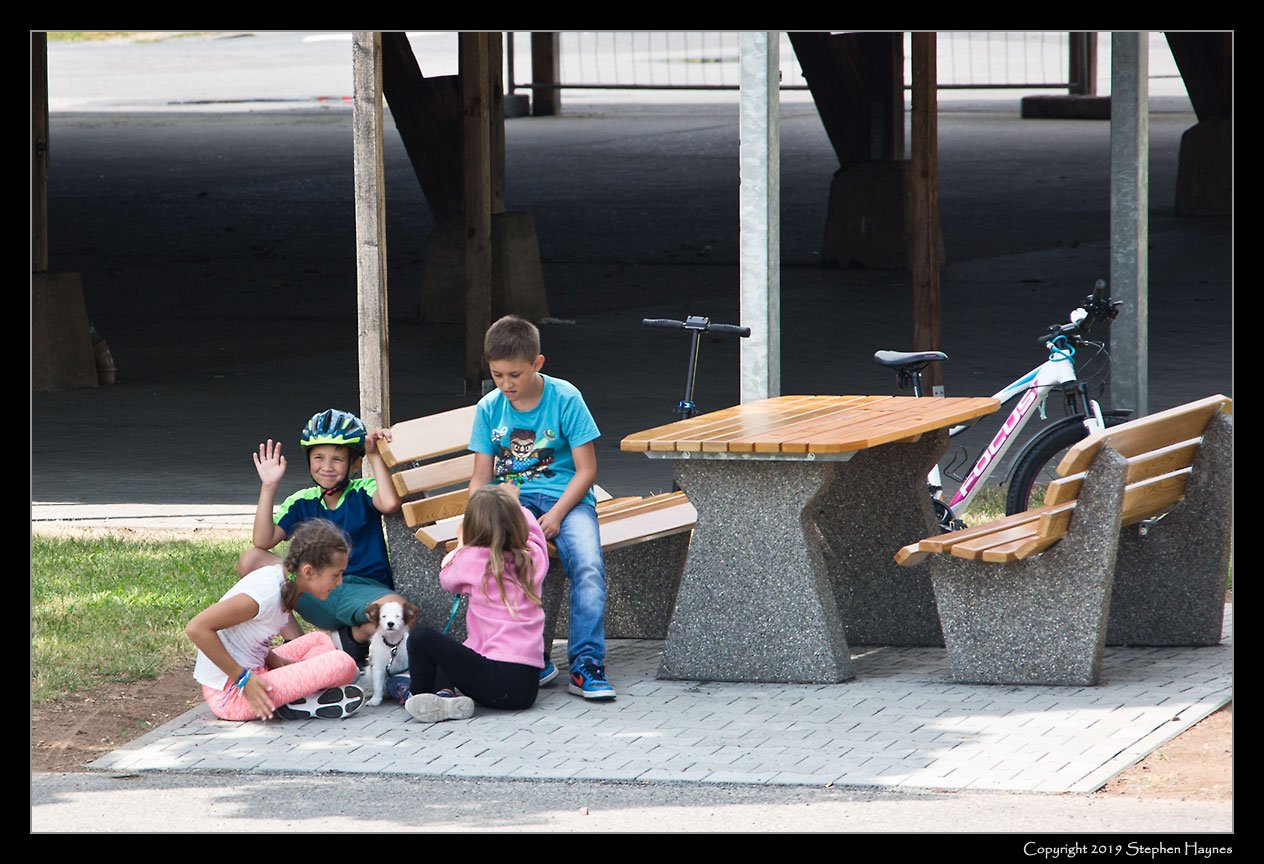
Main River - Jaded -- Multiple river boats passing each day are far less interesting than a small puppy.
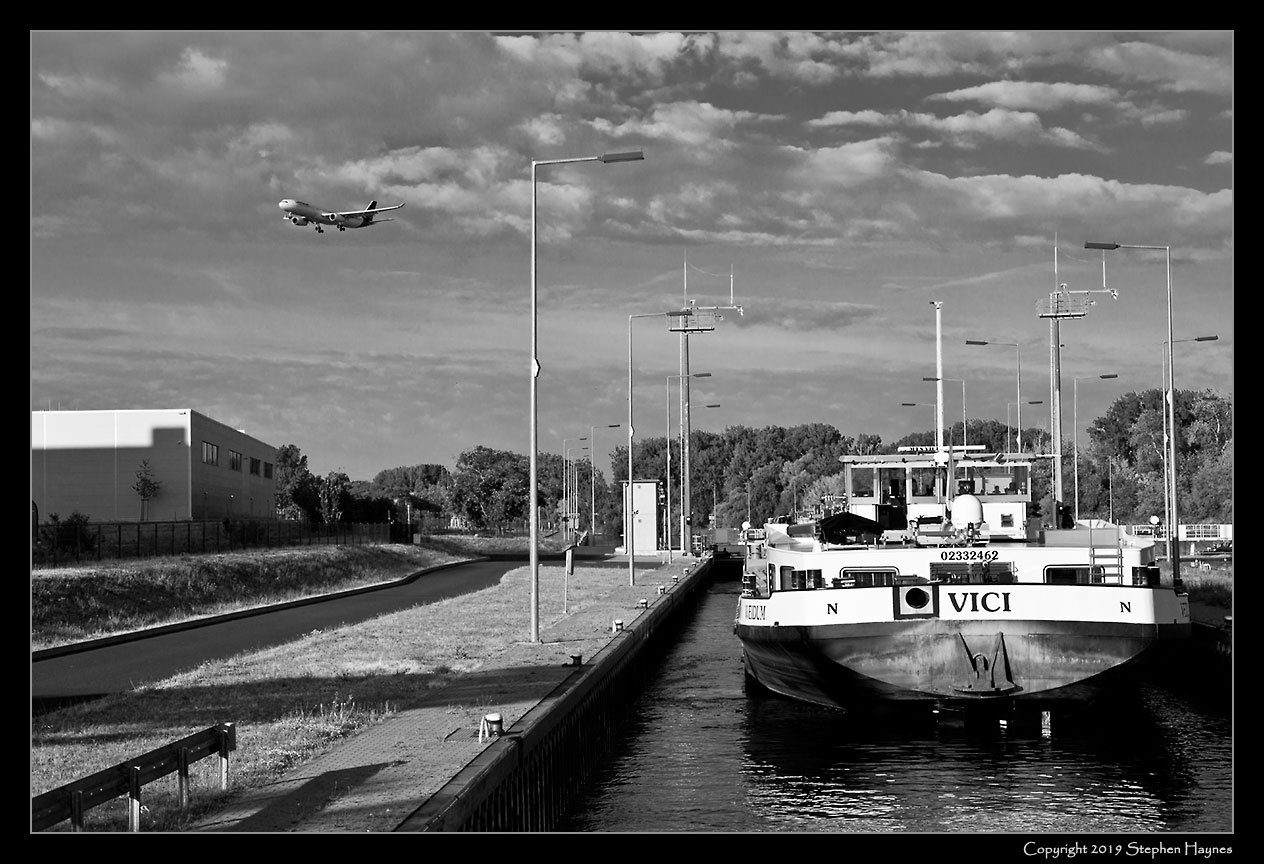
Main River - There Are Faster Ways .... -- Early on the morning the Main River joined the Rhine, as we sat in a lock, near Frankfurt's airport.
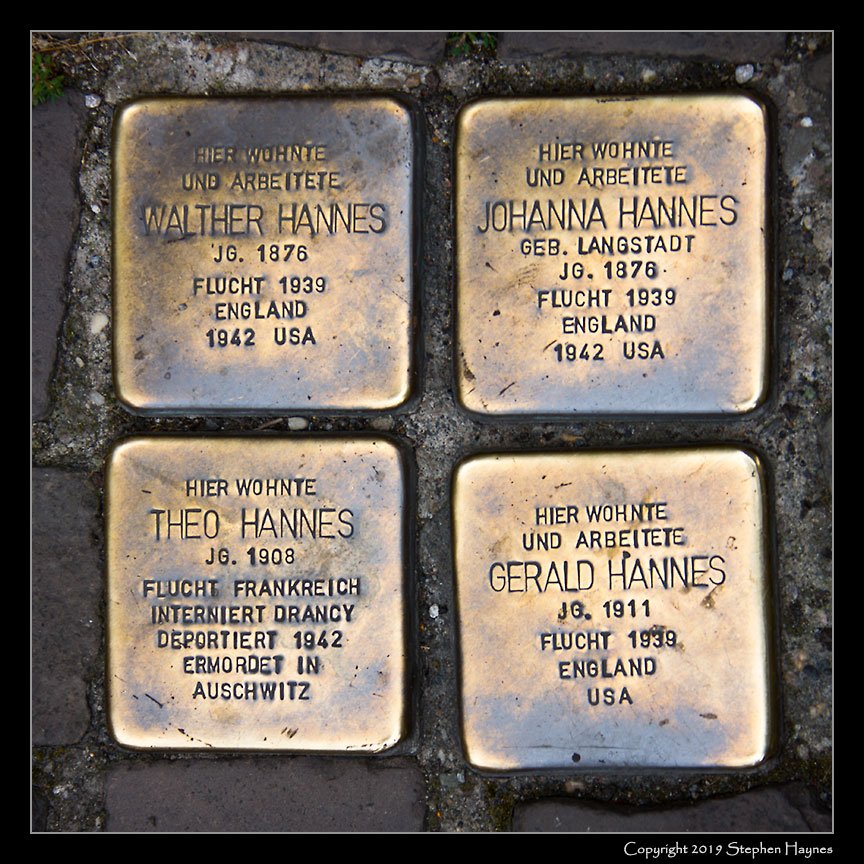
Cologne - Stolperstein -- Of the four individuals who lived in a house at this location, three successfully escaped to England, and thence to the U.S. The fourth, however, died at Auschwitz. Wikipedia: "A Stolperstein, literally "stumbling stone", metaphorically a "stumbling block") is a sett-size, 10 by 10 centimetres (3.9 in × 3.9 in) concrete cube bearing a brass plate inscribed with the name and life dates of victims of Nazi extermination or persecution. The Stolpersteine project, initiated by the German artist Gunter Demnig in 1992, aims to commemorate individuals at exactly the last place of residency—or, sometimes, work—which was freely chosen by the person before he or she fell victim to Nazi terror, euthanasia, eugenics, was deported to a concentration or extermination camp, or escaped persecution by emigration or suicide. As of 23 October 2018, 70,000 Stolpersteine have been laid making the Stolpersteine project the world's largest decentralized memorial." See https://en.wikipedia.org/wiki/Stolperstein
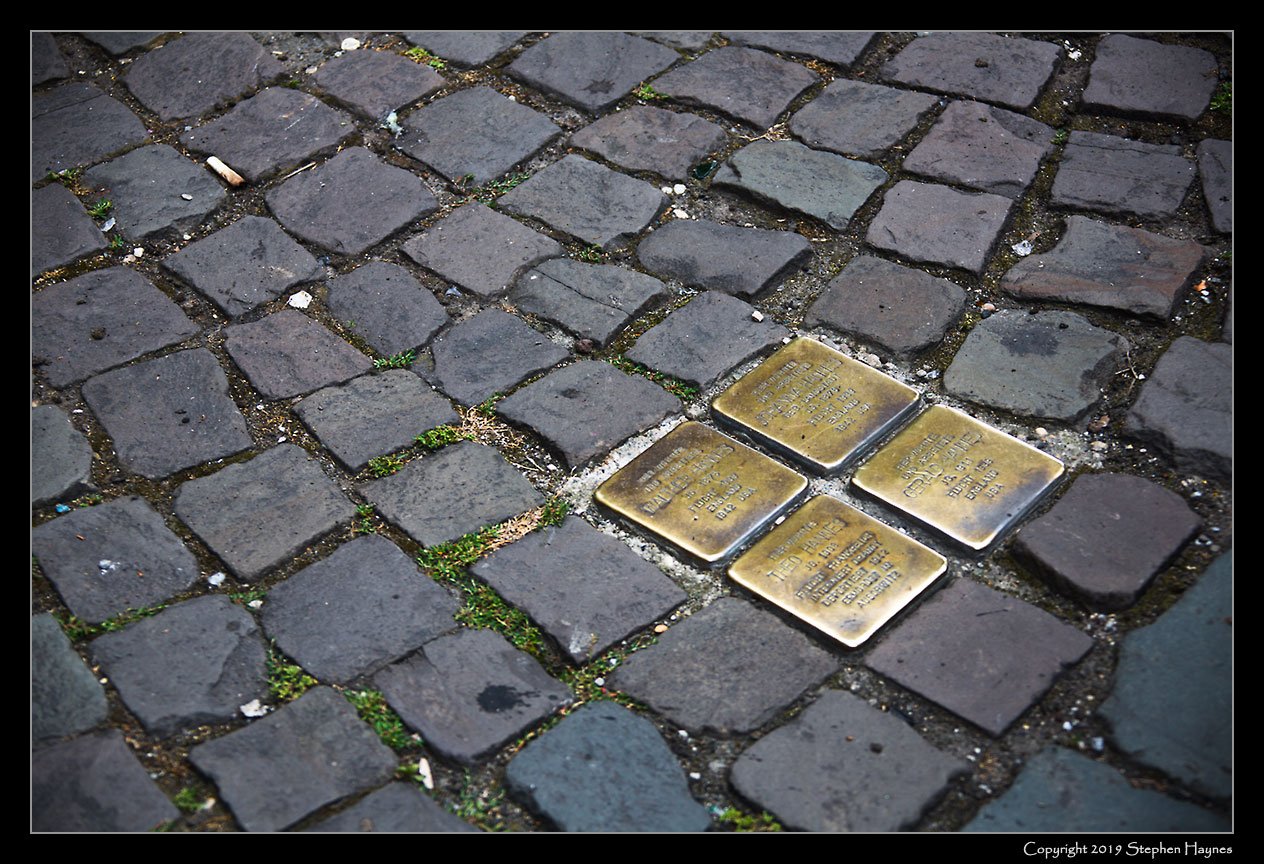
Cologne - Stolperstein

Cologne - Stolperstein
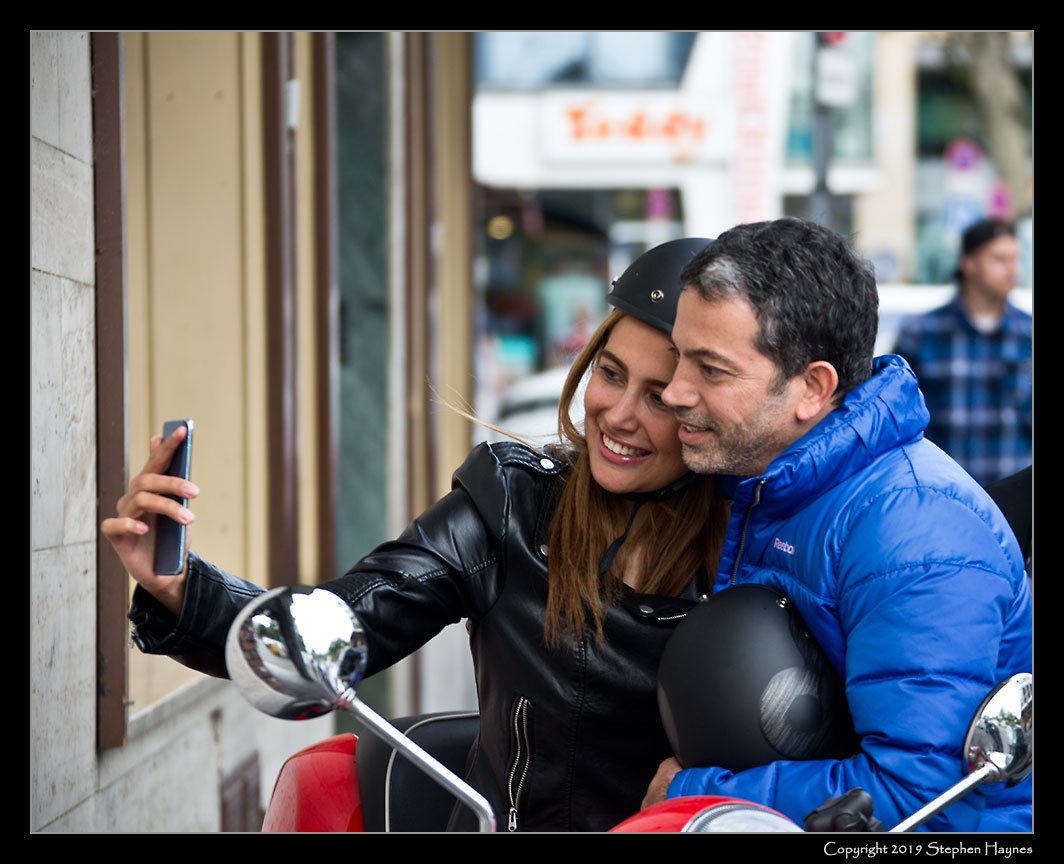
Cologne - Oblivious -- You'd think they would notice the 18-inch long lens pointed at them, but apparently not.
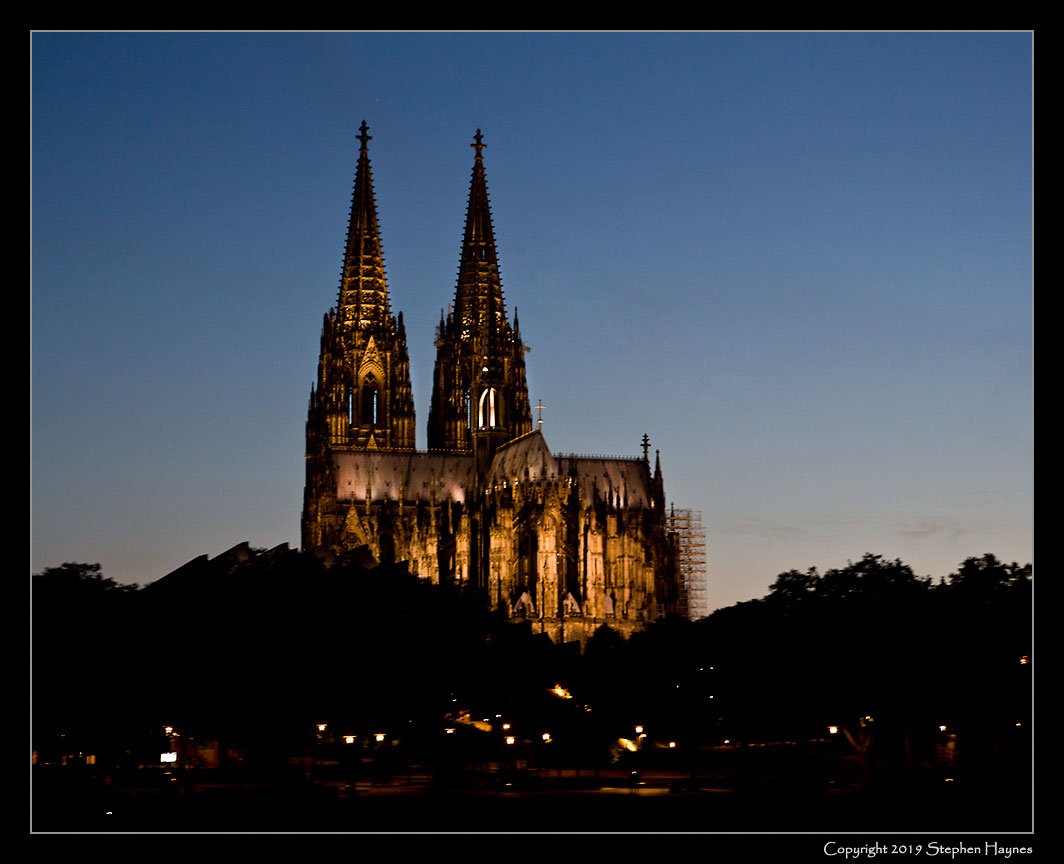
Cologne - Cathedral As We Depart

Kinderdijk -- A wet and dreary day among the Dutch windmills of Kinderdijk.

Kinderdijk
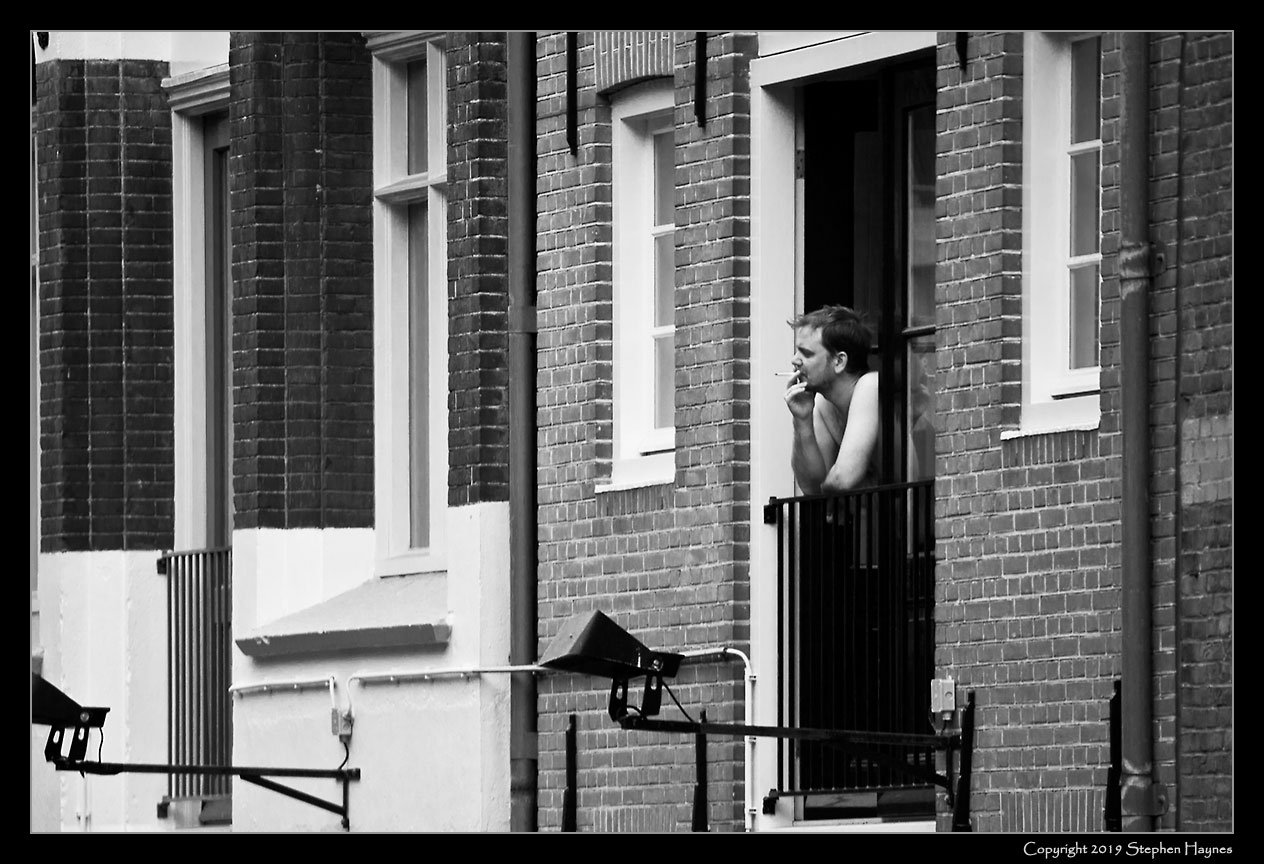
Amsterdam - First Cig

Amsterdam - A Spot of Color
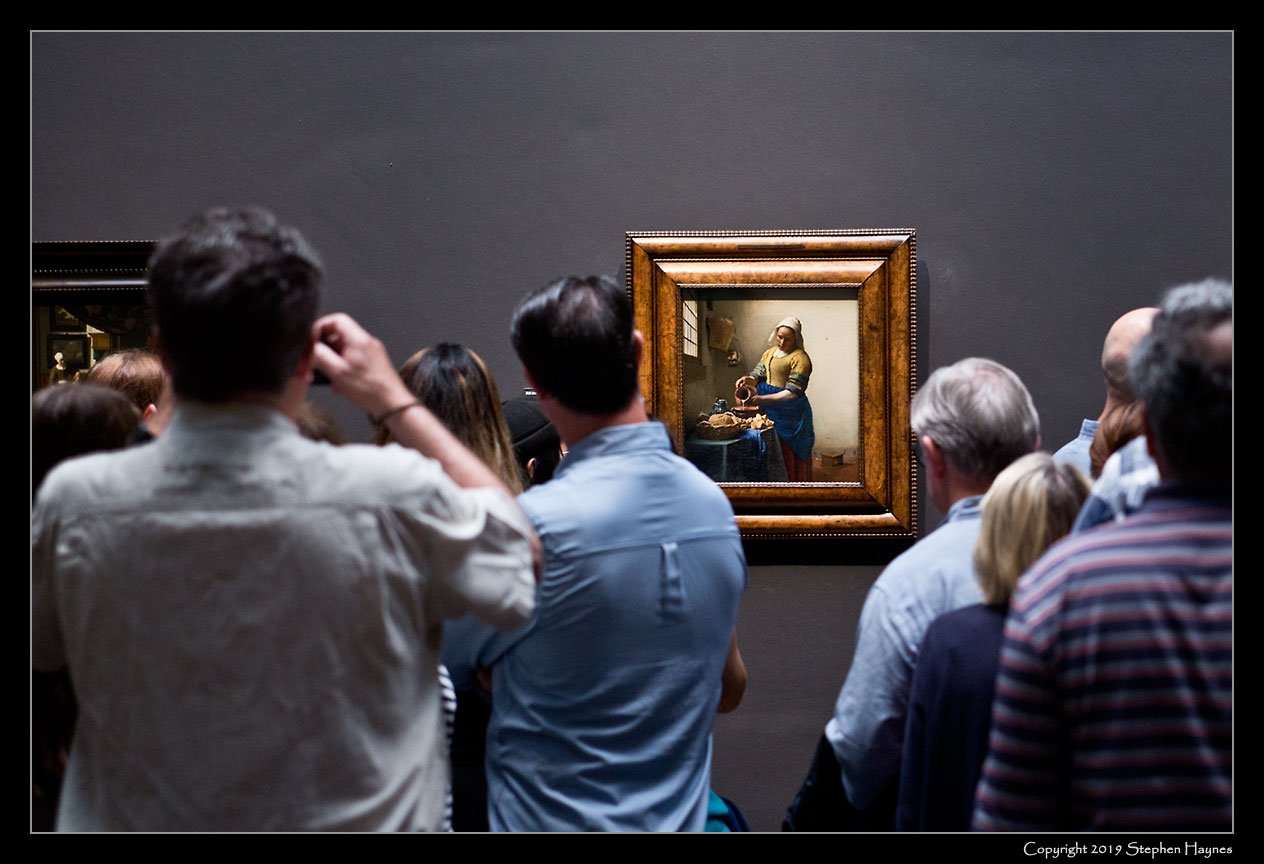
Amsterdam - Vermeer, Still Popular
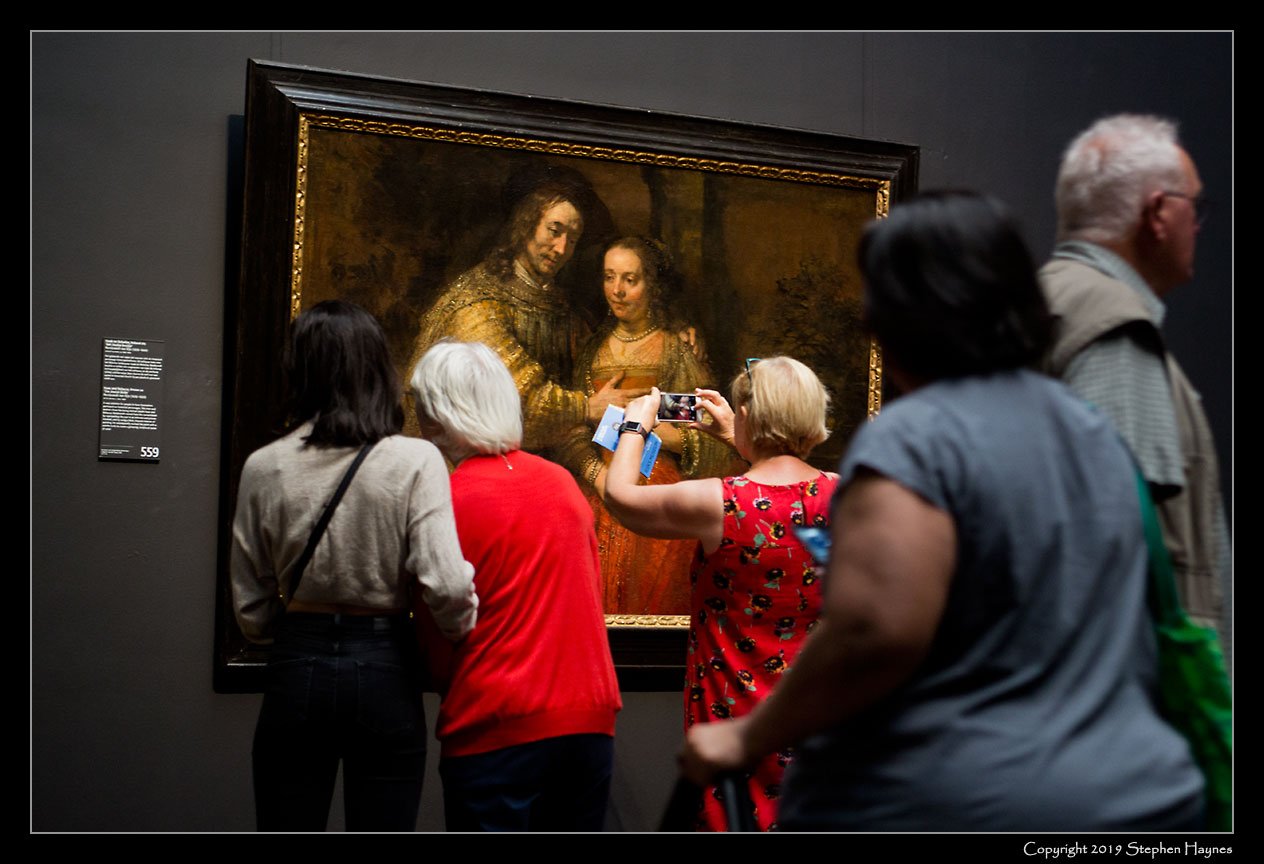
Amsterdam - Likewise Rembrandt
Castles (and Castle Ruins).
Castles seen along the Danube, Main and Rhine Rivers, with a large number photographed along the Middle Rhine (sometimes called the "Rhine Gorge"). Those Middle Rhine castles and castle ruins have been photographed thousands of times before, so -- other than quality -- I fear these photos add nothing to the wealth of images already on the Internet.
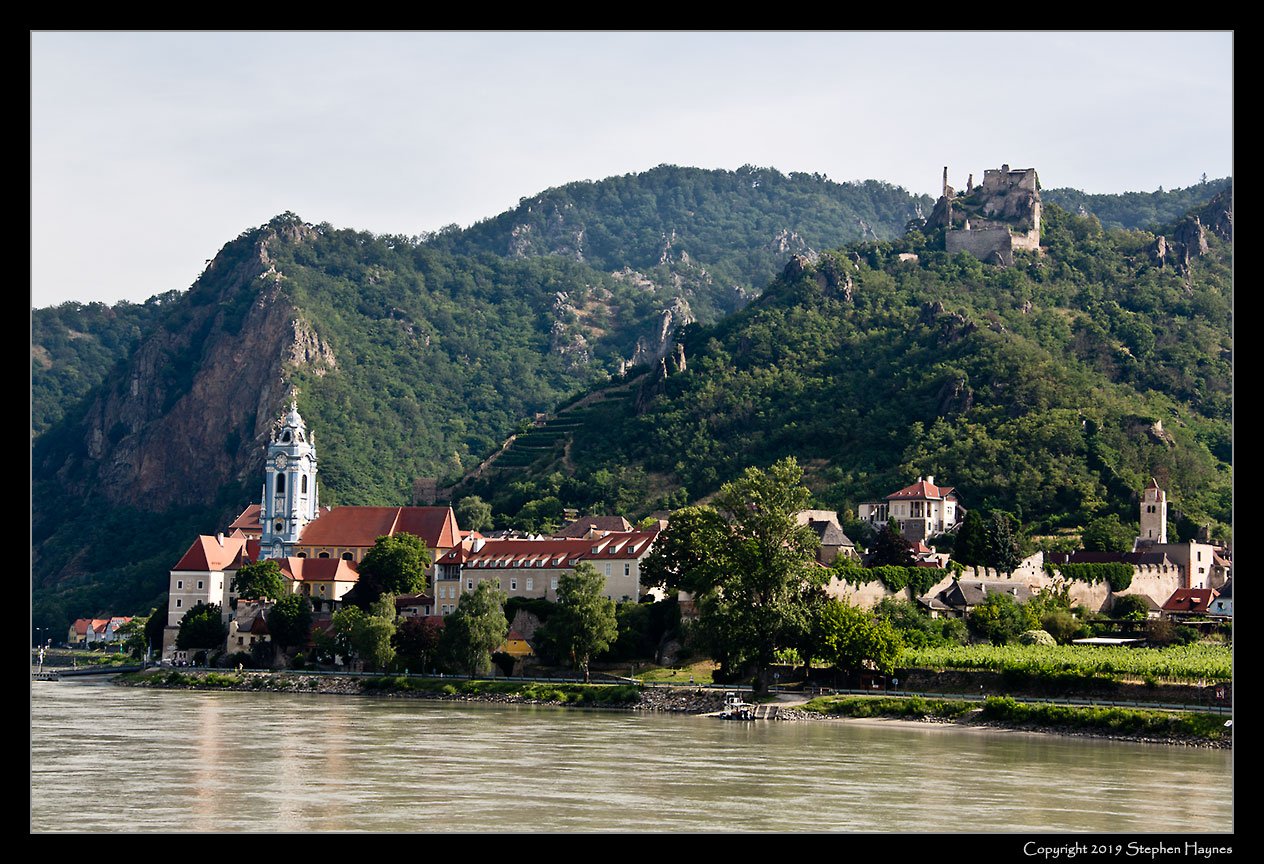
Burgruine Dürnstein (Danube)
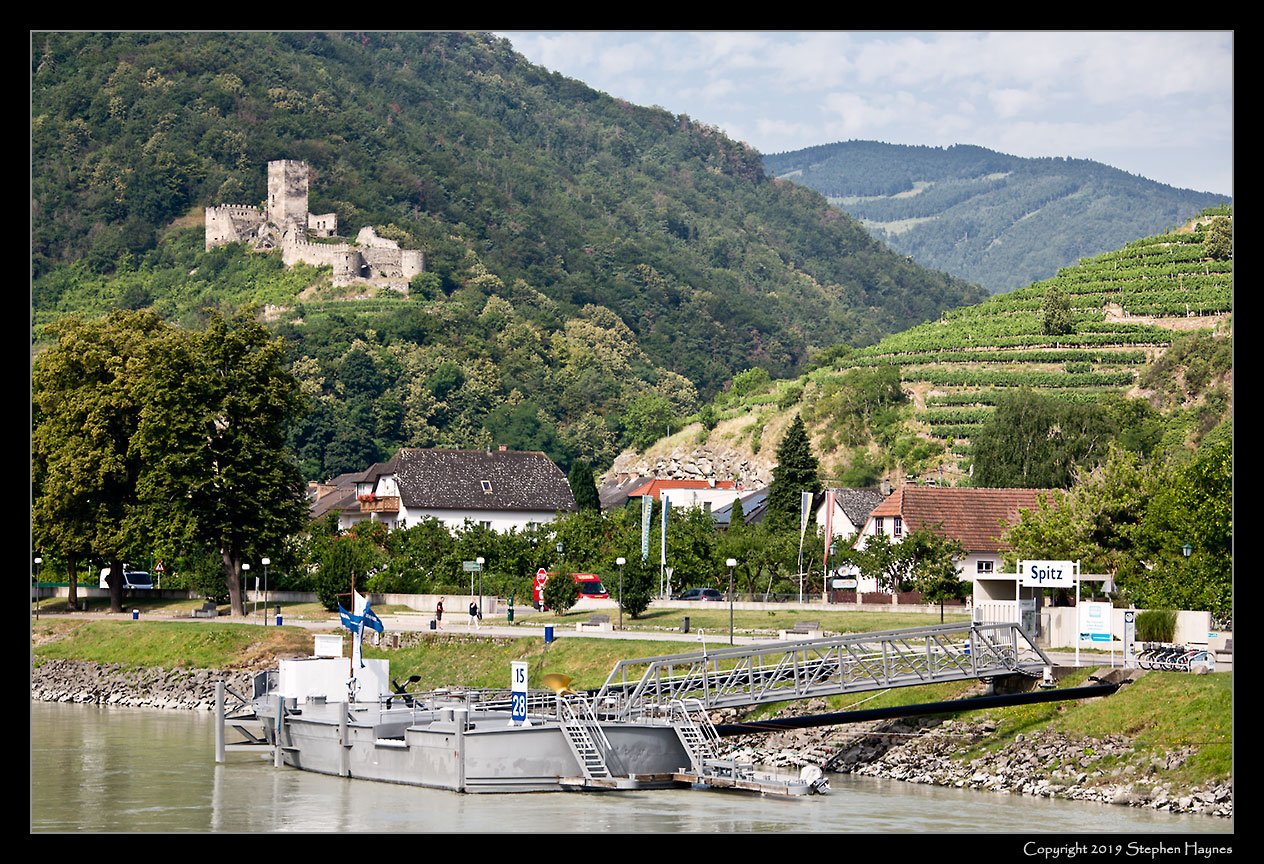
Hinterhaus Castle - Spitz (Danube) -- Castle Spitz. Wiki Voyage: “Named after the Knights of Spitz, who maintained the castle looming over the town, evidence of human settlement here dates back 4000 years. From 812 to 1504 CE it was owned by the Niederaltaich Abbey, and was a Bavarian enclave within Austria. Today its primary economic activity is wine production and tourism.”
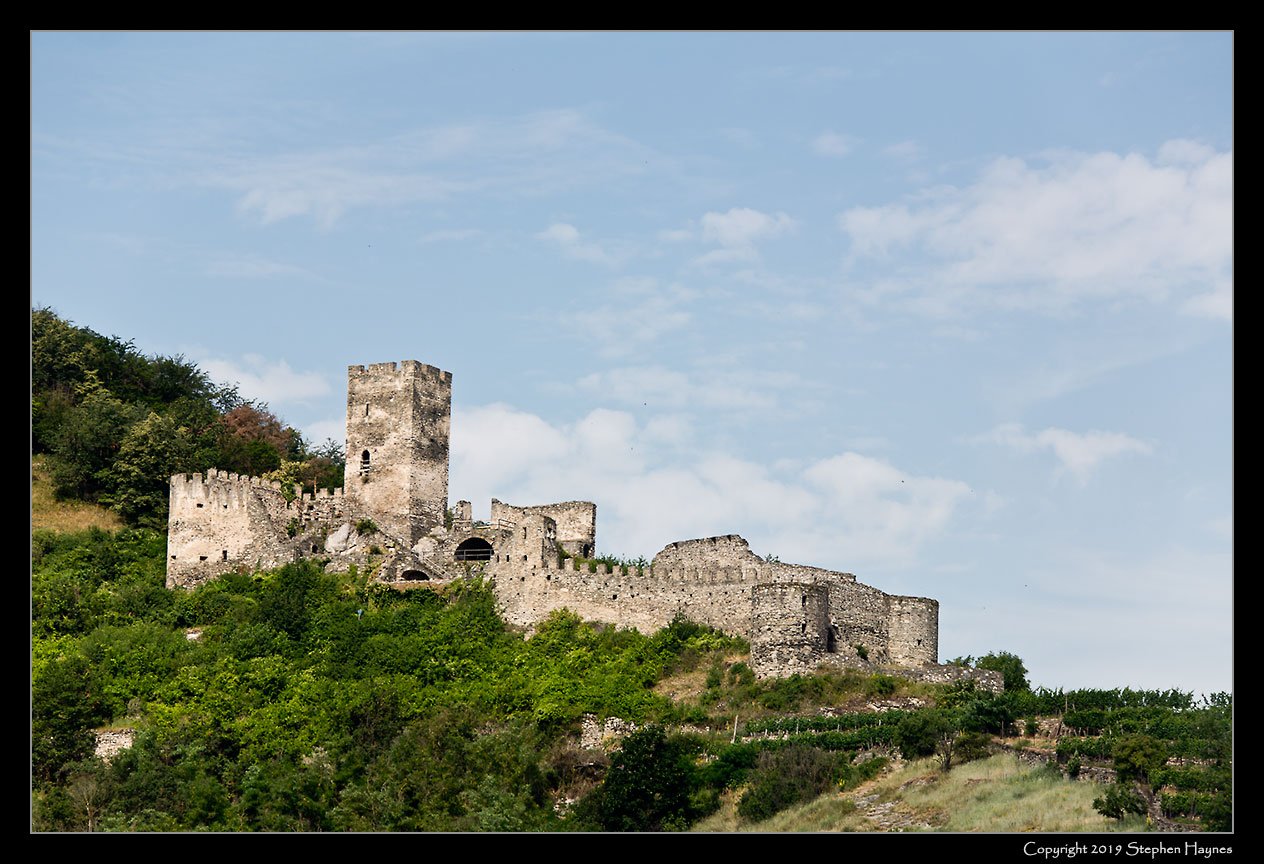
Hinterhaus Castle - Spitz (Danube)

Wertheim Castle (Main)
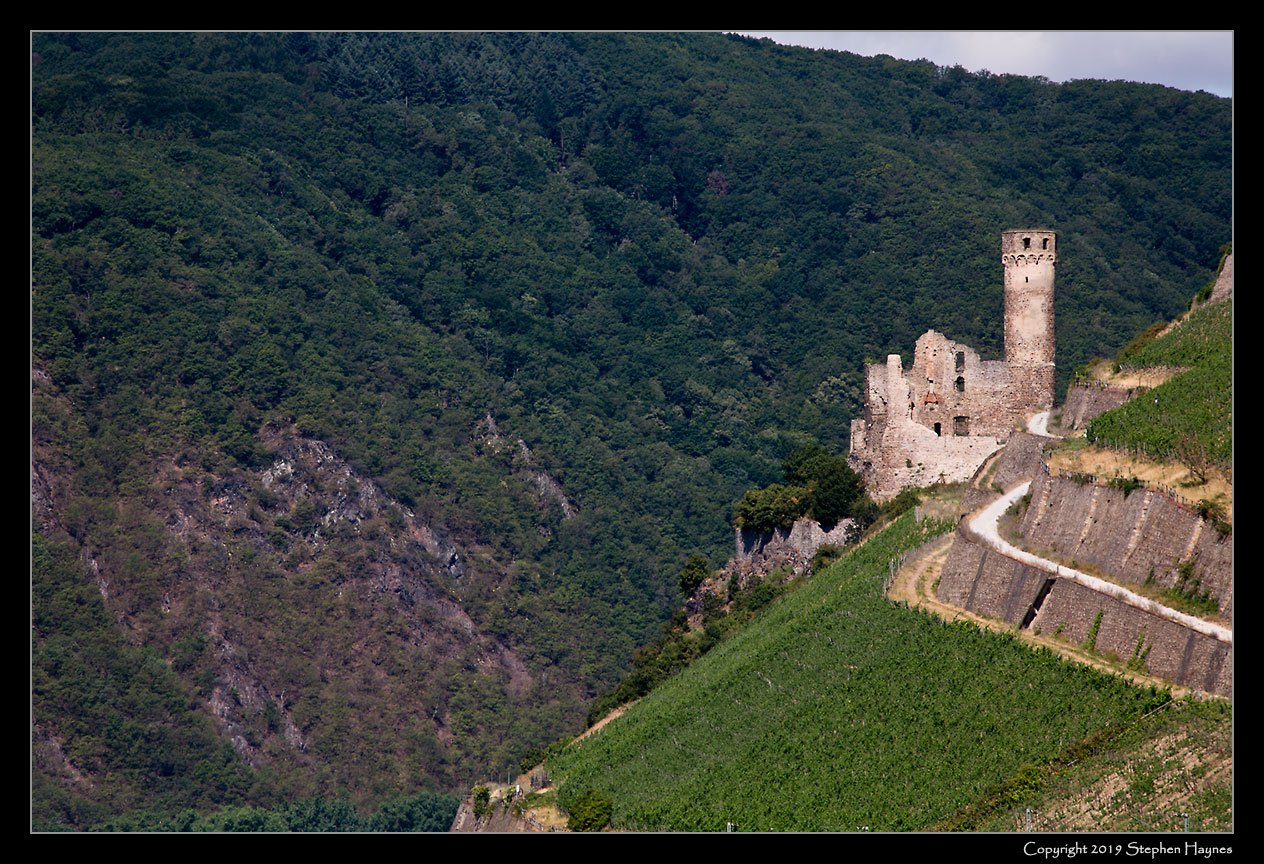
Castle Ruins Near Rudesheim (Rhine)
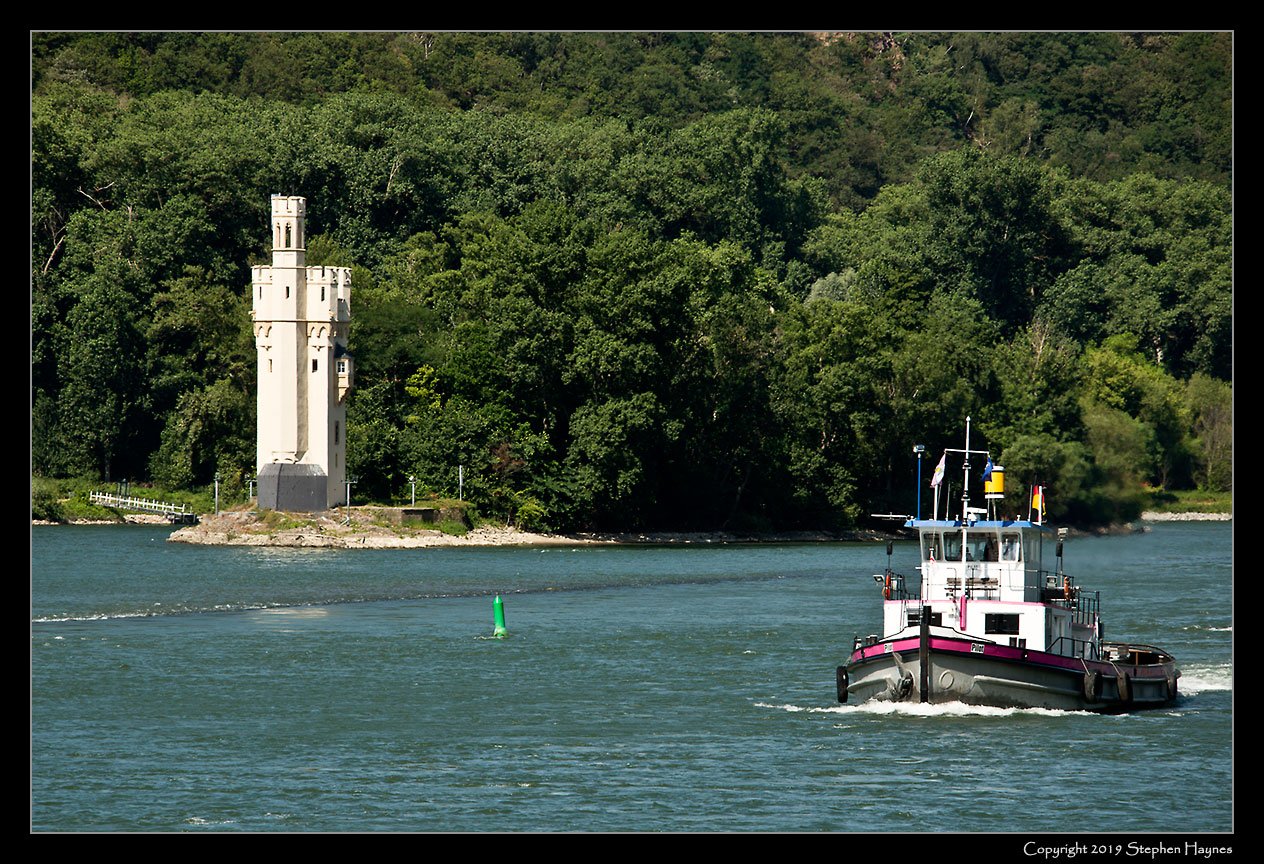
Mouse Tower (Rhine)
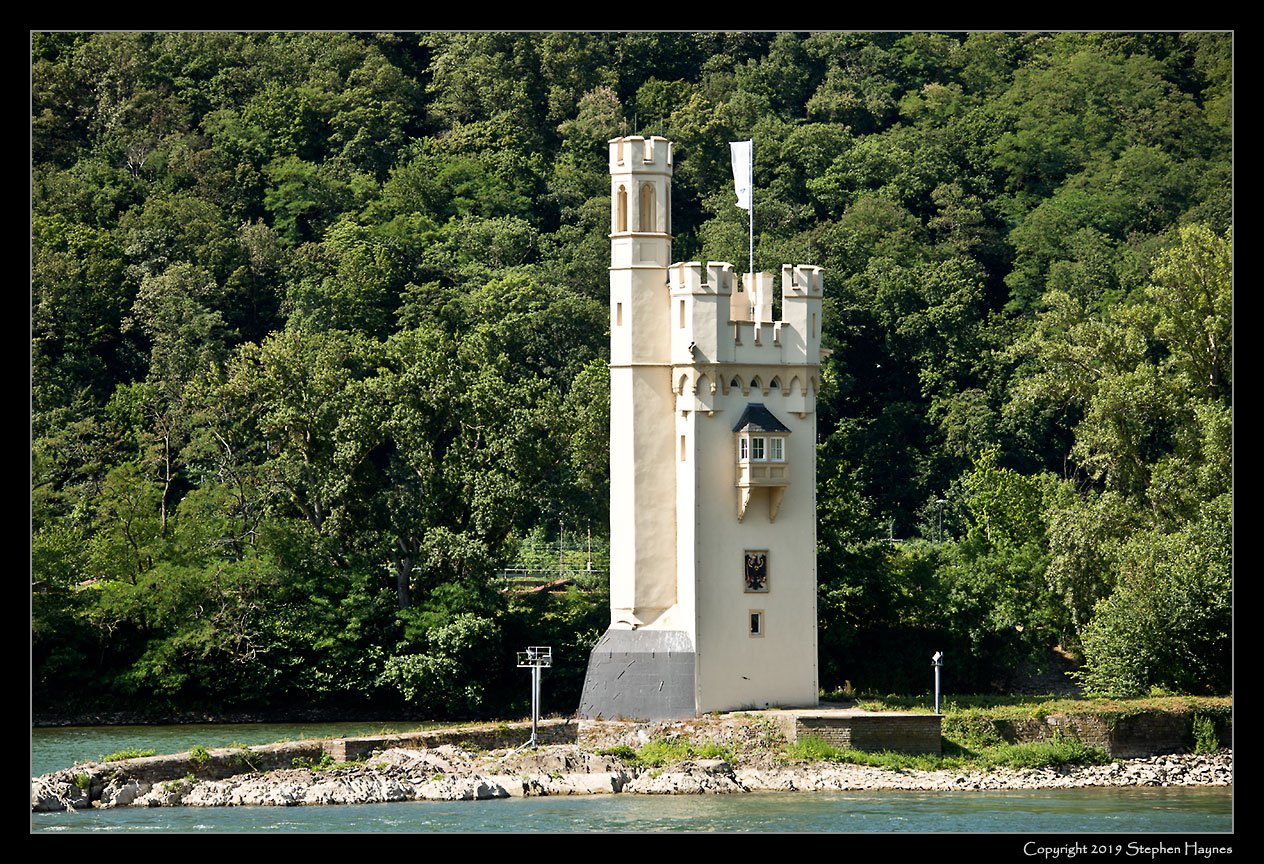
Mouse Tower (Rhine)
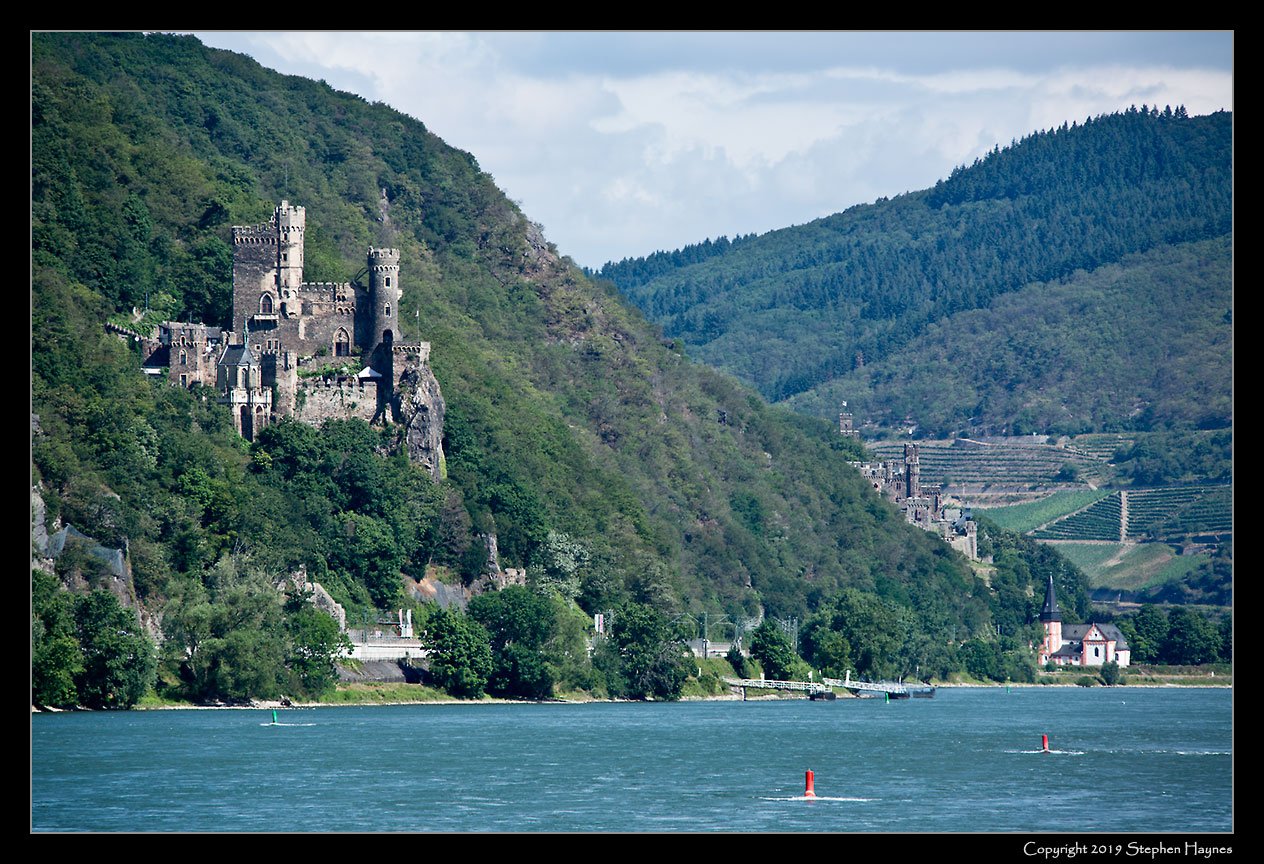
Rheinstein Castle (Middle Rhine)
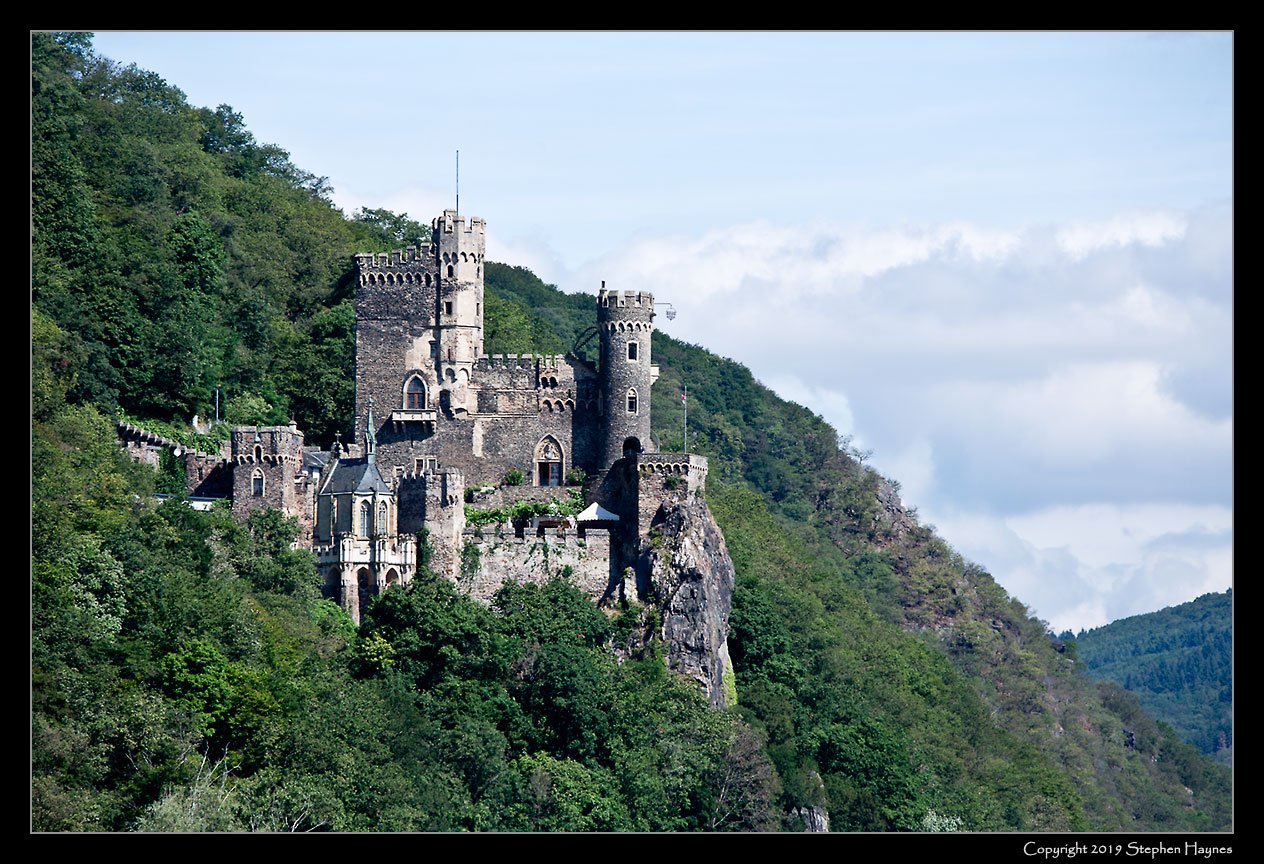
Rheinstein Castle (Middle Rhine)

Reichenstein Castle (Middle Rhine)
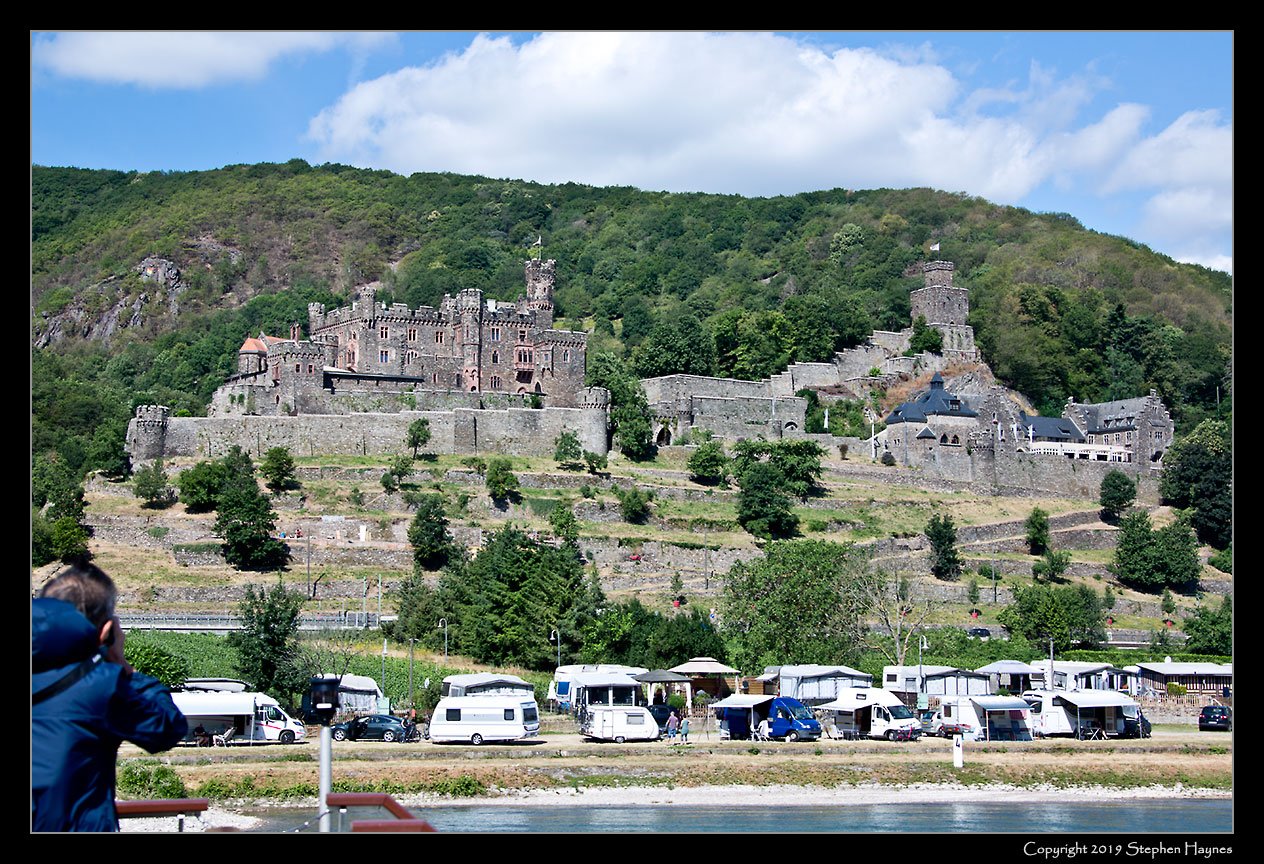
Reichenstein Castle (Middle Rhine)
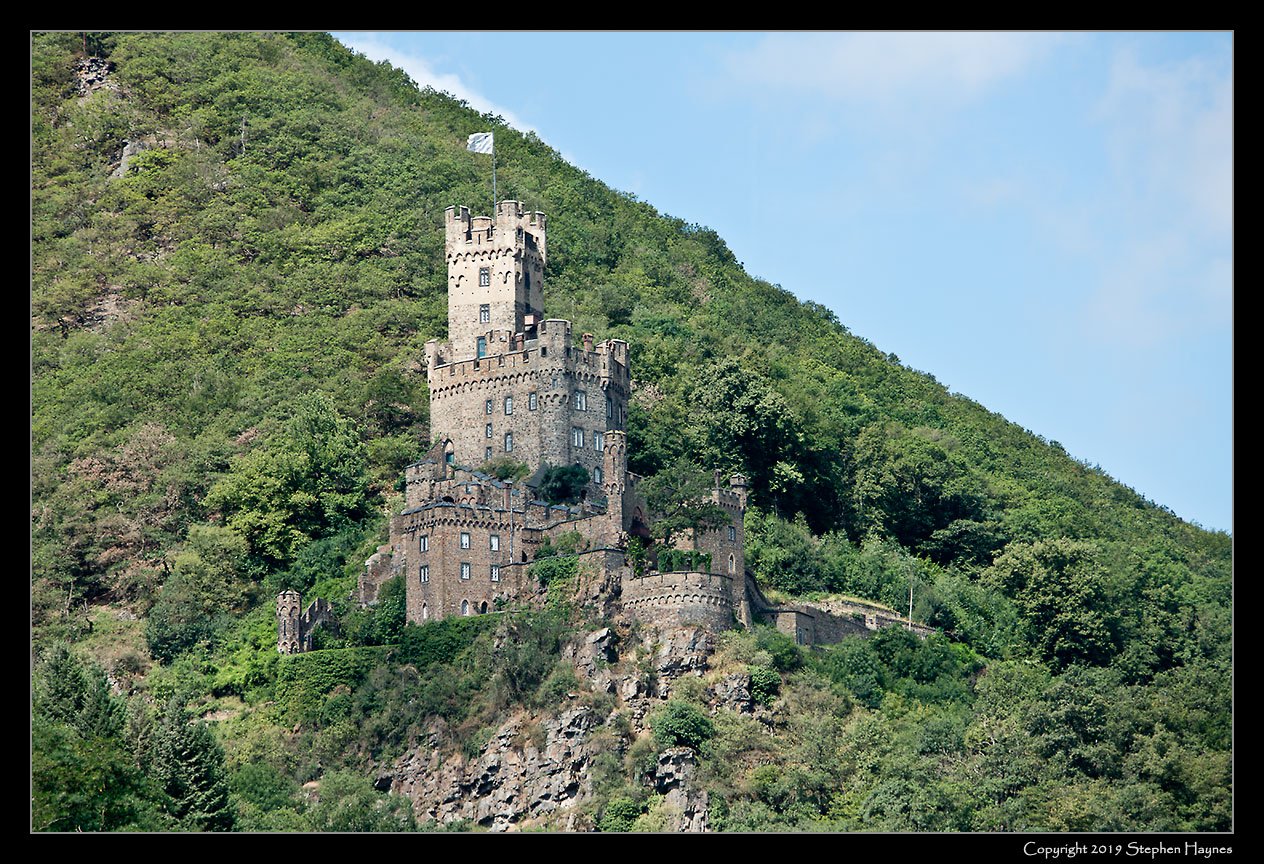
Sooneck Castle (Middle Rhine)
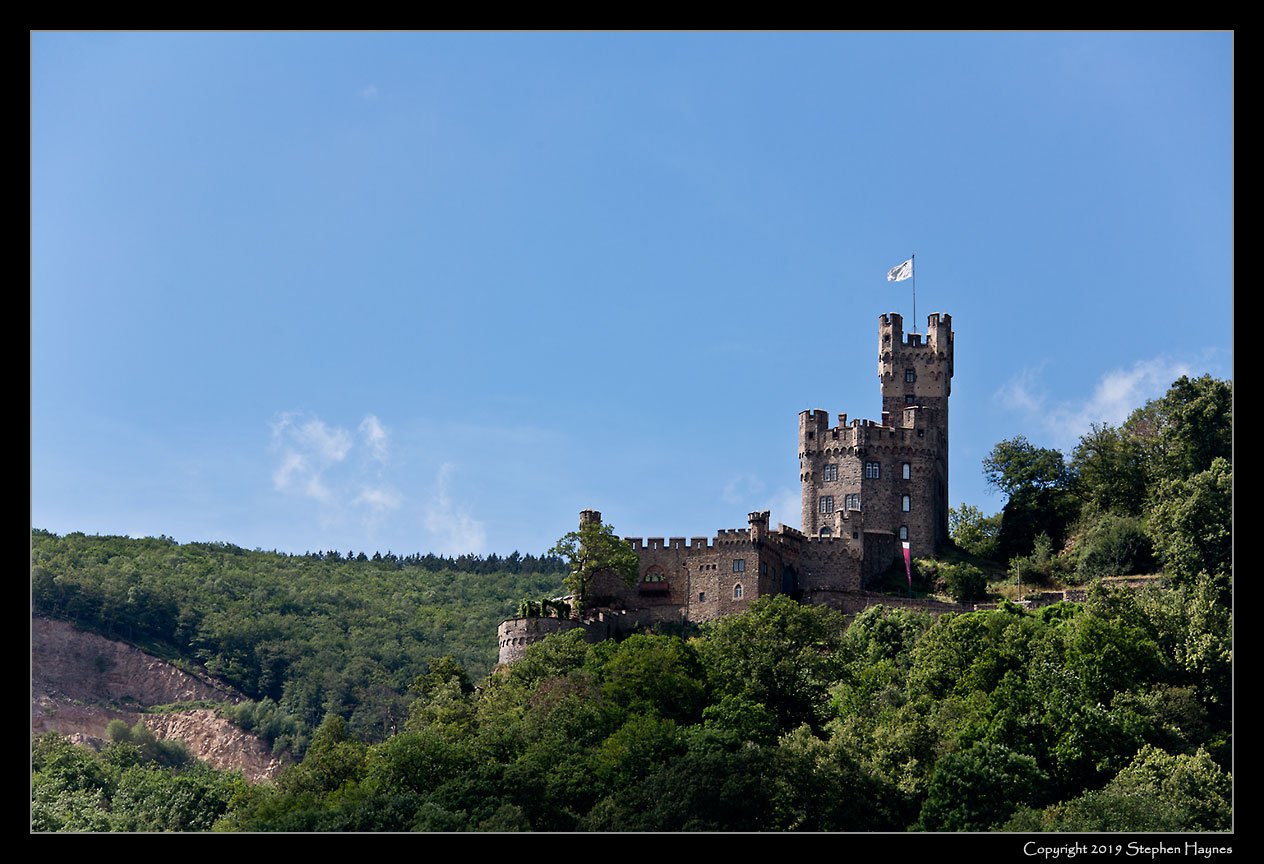
Sooneck Castle (Middle Rhine)
![[Youth] Hostel Burg Stahleck Bacharach (Middle Rhine)](https://images.squarespace-cdn.com/content/v1/619bd2877e4ad11ef537db29/1f36ba41-7ced-44ec-bc86-a0da08c69d7d/Viking_Europe_Cruise_-_June-July_2019_605_Rhine_Gorge.jpg)
[Youth] Hostel Burg Stahleck Bacharach (Middle Rhine)
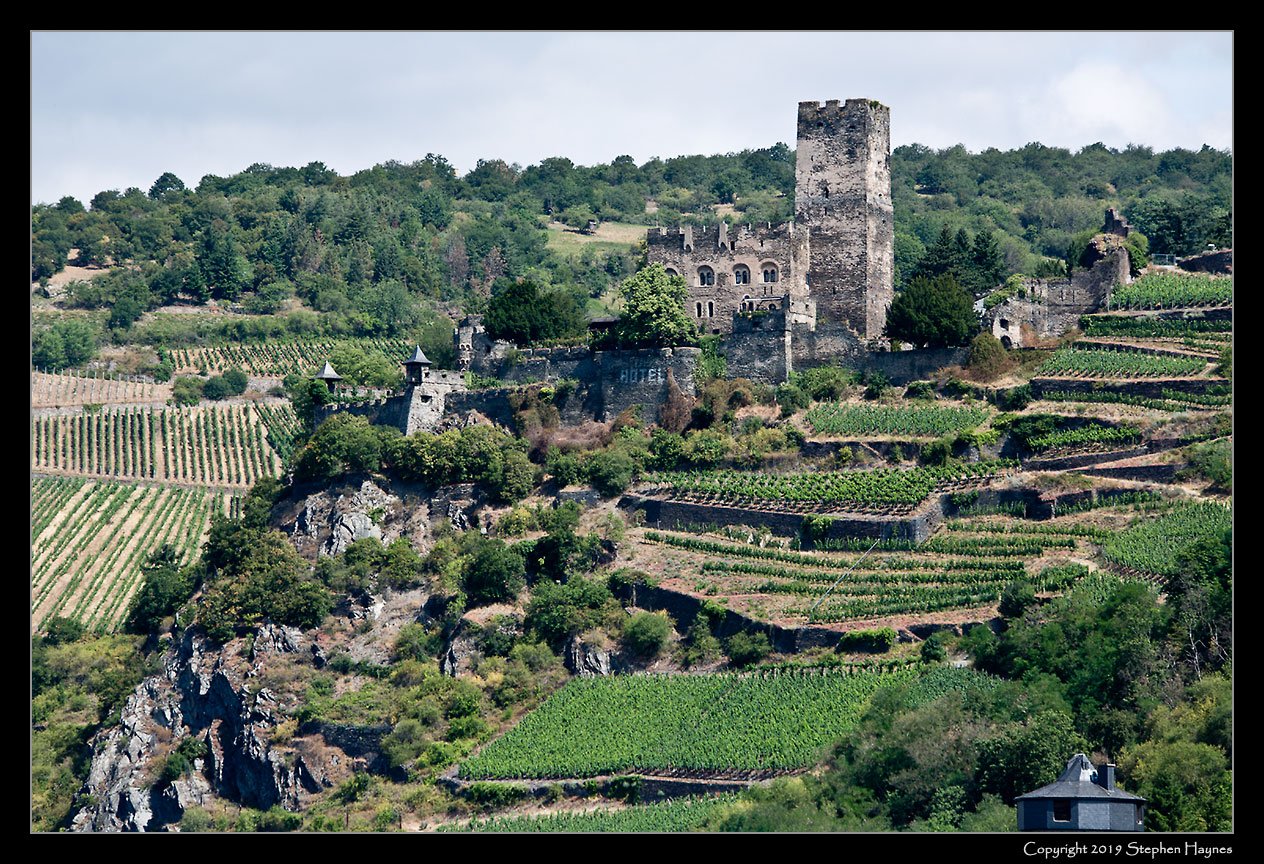
Gutenfels Castle (and Hotel) (Middle Rhine)
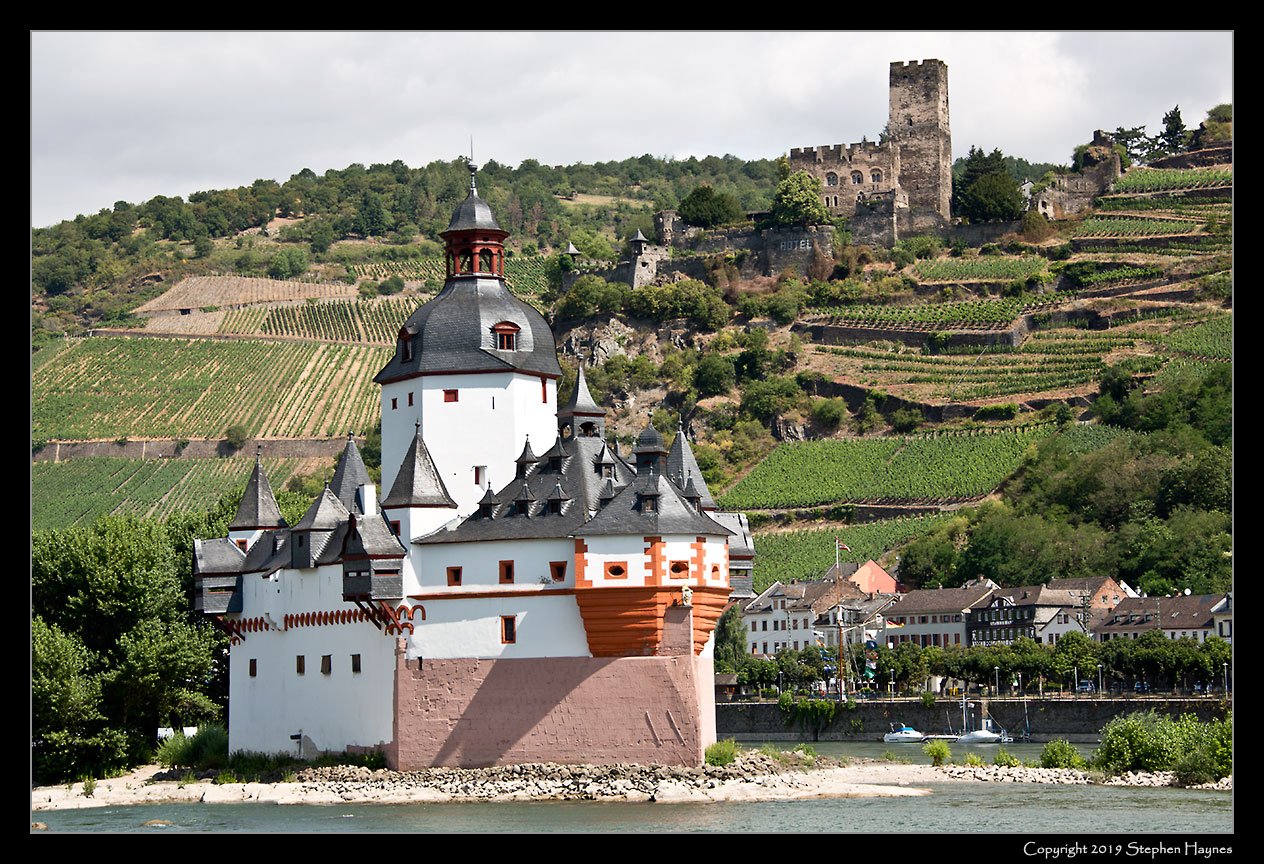
Pfalzgrafenstein Castle (Middle Rhine)
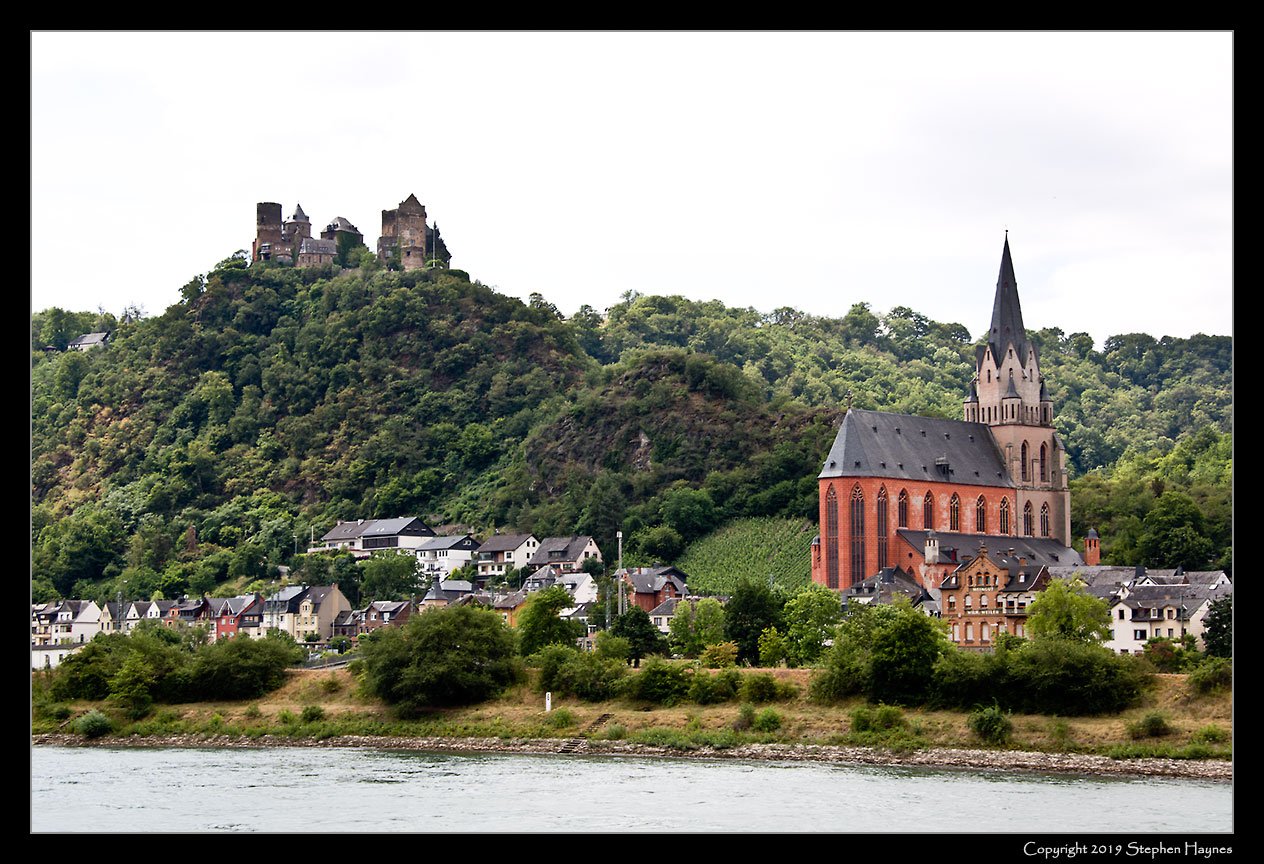
Schönburg (Castle/Hotel) (Middle Rhine)
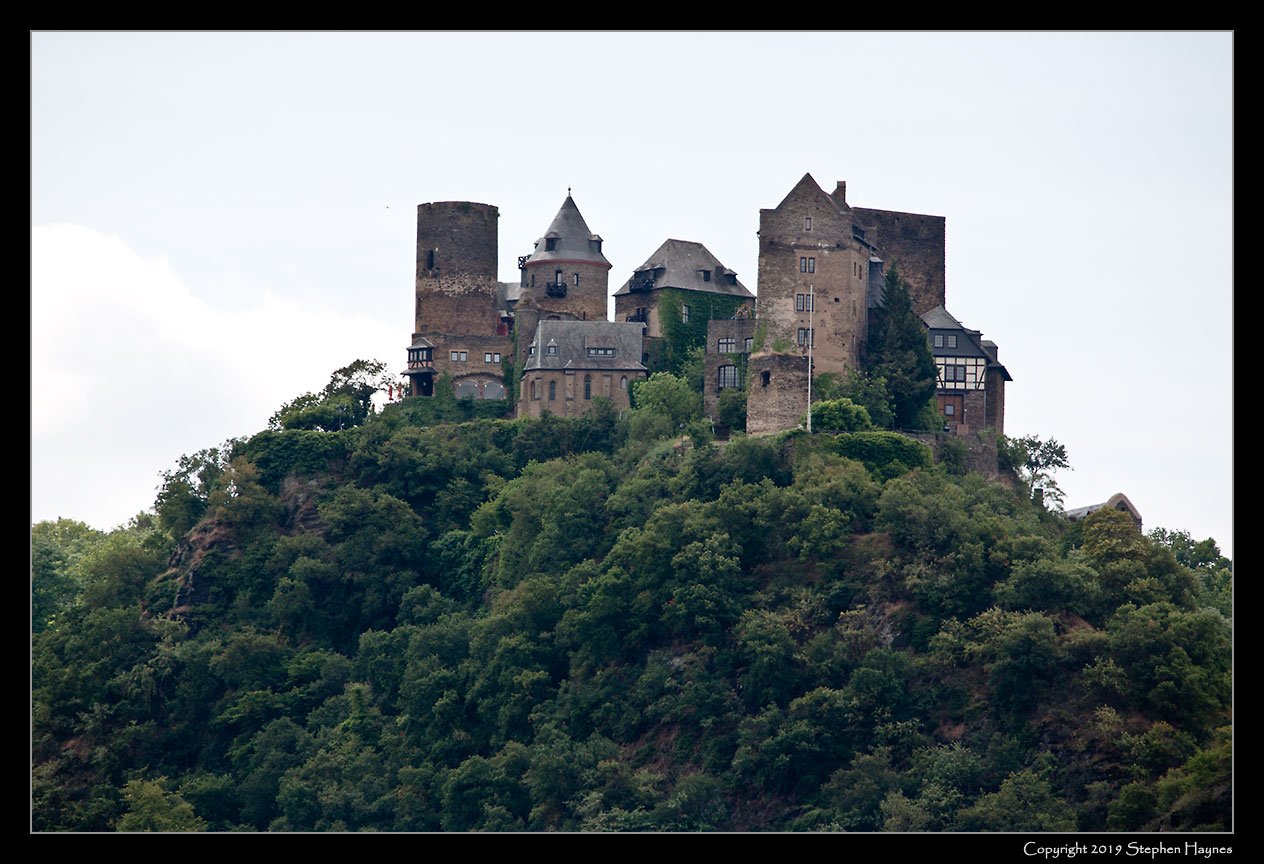
Schönburg (Castle/Hotel) (Middle Rhine)

Rheinfels Castle and Fortress (Middle Rhine)
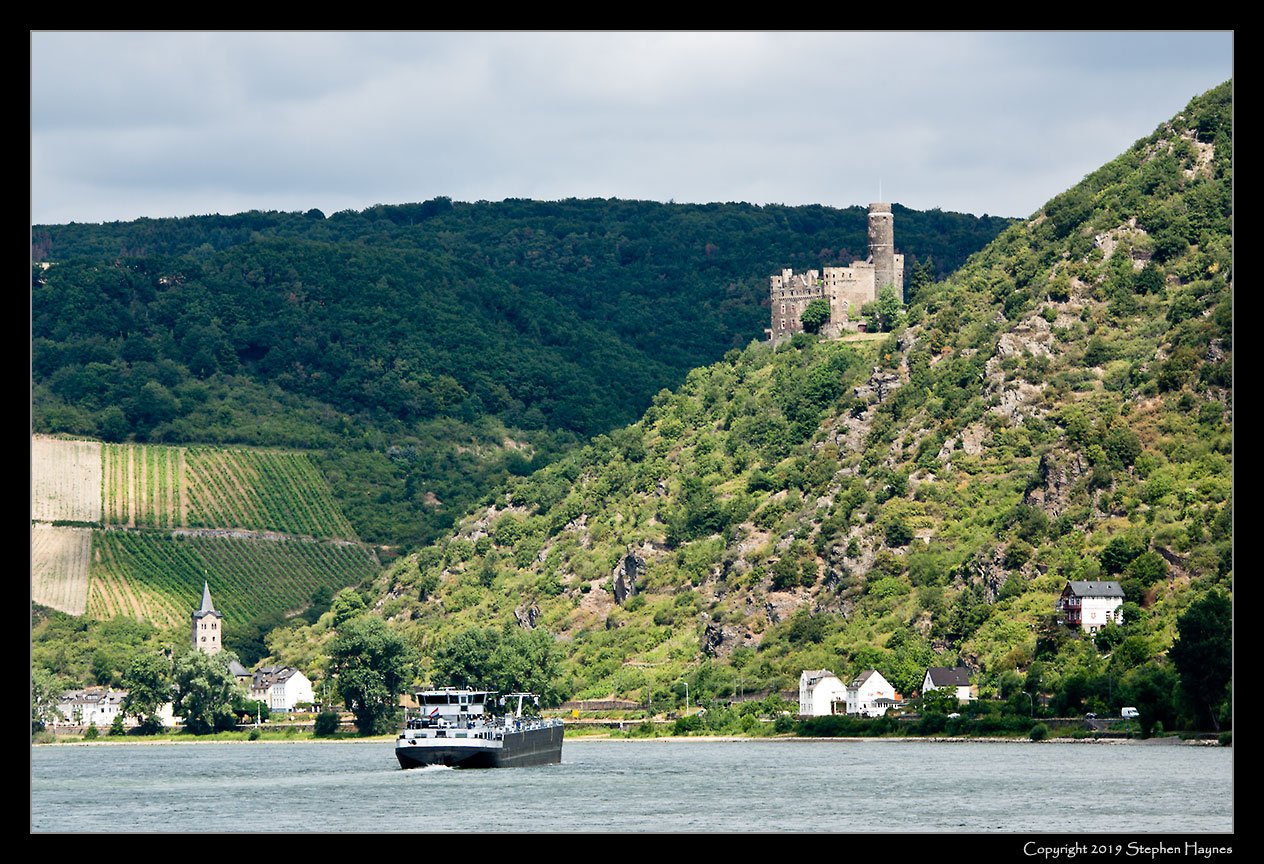
Maus Castle (Middle Rhine)
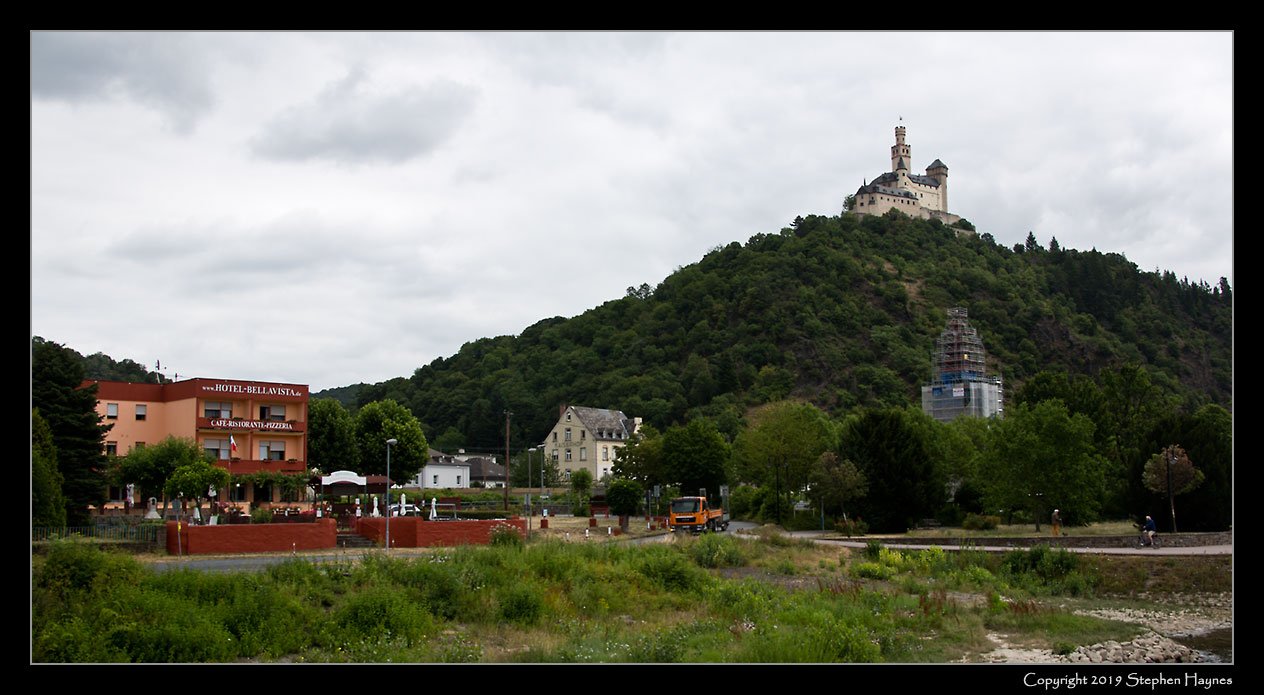
Marksburg Castle (Middle Rhine)

Marksburg Castle (Middle Rhine)
Cathedrals, Churches & Synagogues.
We visited several prominent houses of worship, and my photographs are of exteriors and interiors both. As to the latter, most of the photos were taken using High Dynamic Range technology. Those who have tried photographing stained glass windows will know that if you achieve proper exposure for the windows, you'll often lose most if not all details of the surrounding church structure. By extending the range of light captured by four stops, HDR permits retaining detail of the windows but also showing interior detail (although the photos will often contain color noise due to the high ISO required for natural light photographs). I will note, incidentally, that all these HDR photos were taken hand-held, a feature enabled by my Canon 5D Mark III camera.
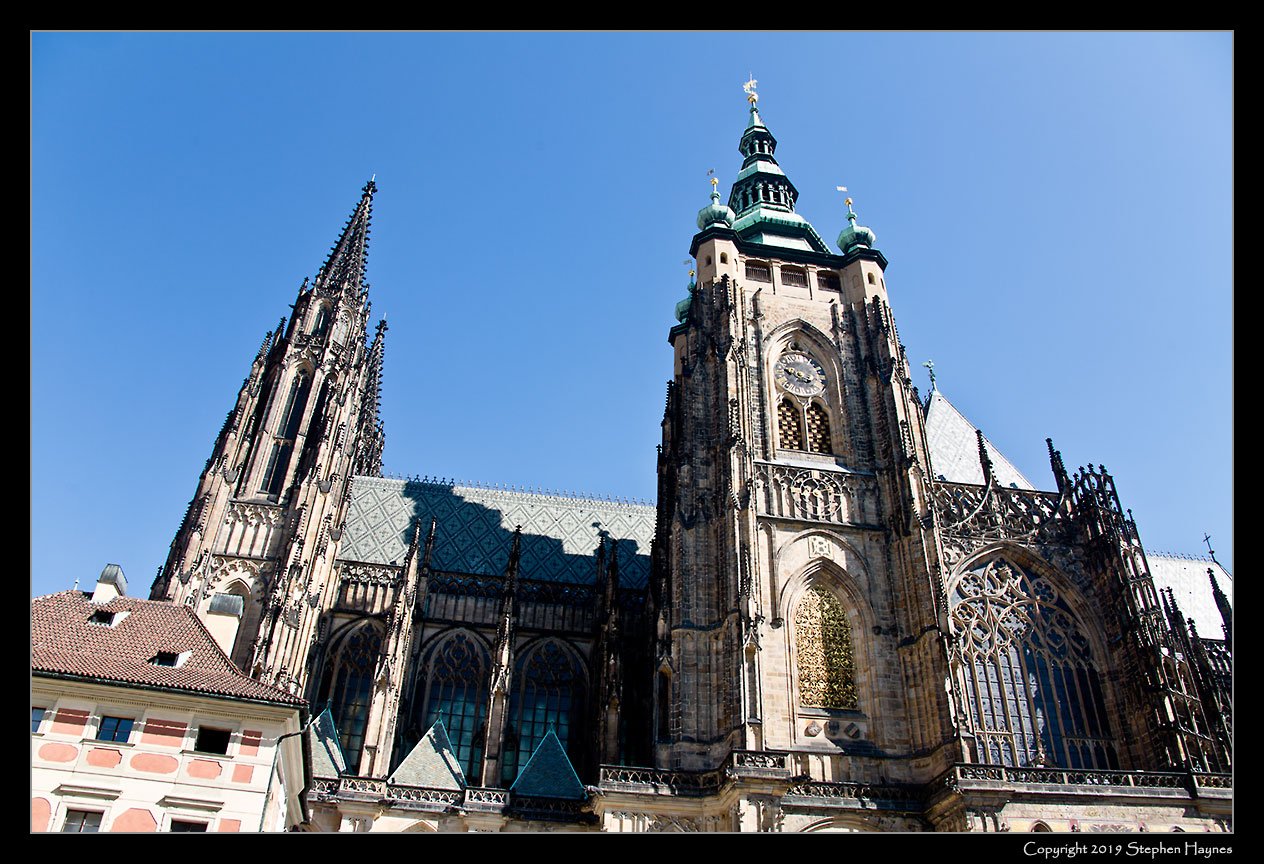
St. Vitus Cathedral - Prague

St. Vitus Cathedral - Prague -- Wikipedia: "The Metropolitan Cathedral of Saints Vitus, Wenceslaus and Adalbert is a Roman Catholic metropolitan cathedral in Prague, the seat of the Archbishop of Prague. Until 1997, the cathedral was dedicated only to Saint Vitus, and is still commonly named only as St. Vitus Cathedral. This cathedral is a prominent example of Gothic architecture and is the largest and most important church in the country. Located within Prague Castle and containing the tombs of many Bohemian kings and Holy Roman Emperors, the cathedral is under the ownership of the Czech government as part of the Prague Castle complex."

St. Vitus Cathedral - Prague
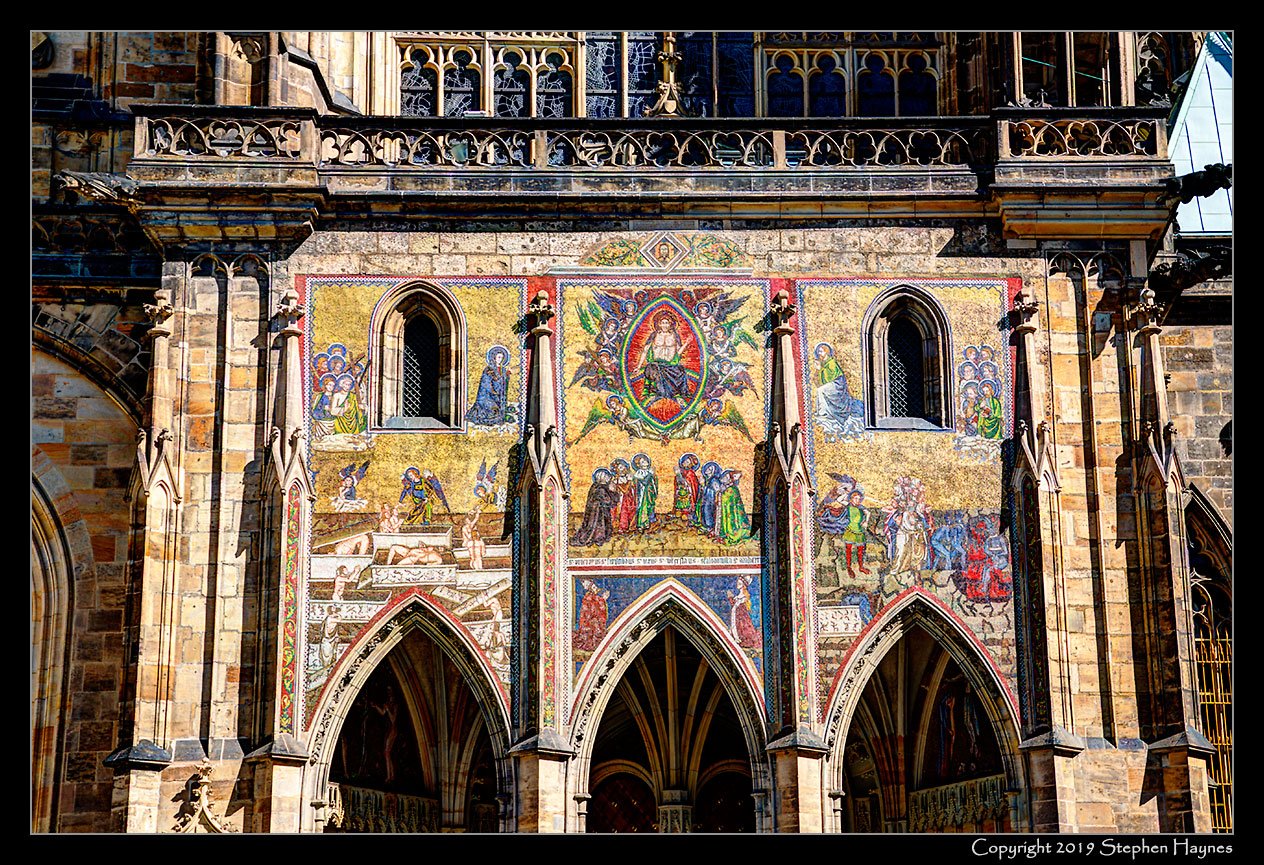
St. Vitus Cathedral - Prague -- A gold-dominated mosaic of the Last Judgment, with resurrection of the dead at the left, judgment being decreed in the center panel, and sinners consigned to Hell at the right. (An HDR image.)
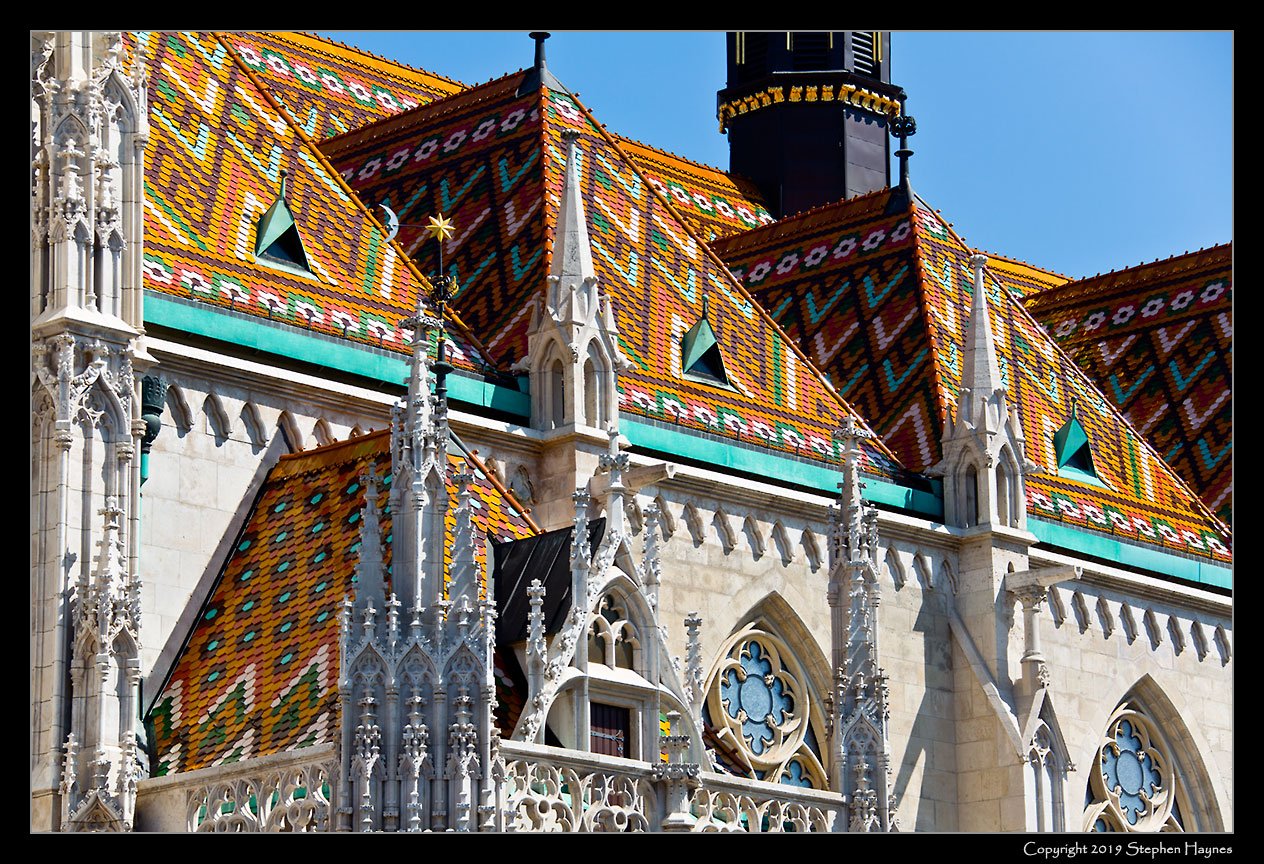
Matthias Church - Budapest -- Wikipedia: "Matthias Church is a Roman Catholic church located in Budapest, Hungary, in front of the Fisherman's Bastion at the heart of Buda's Castle District. According to church tradition, it was originally built in Romanesque style in 1015, although no archaeological remains exist. The current building was constructed in the florid late Gothic style in the second half of the 14th century and was extensively restored in the late 19th century. It was the second largest church of medieval Buda and the seventh largest church of the medieval Hungarian Kingdom."
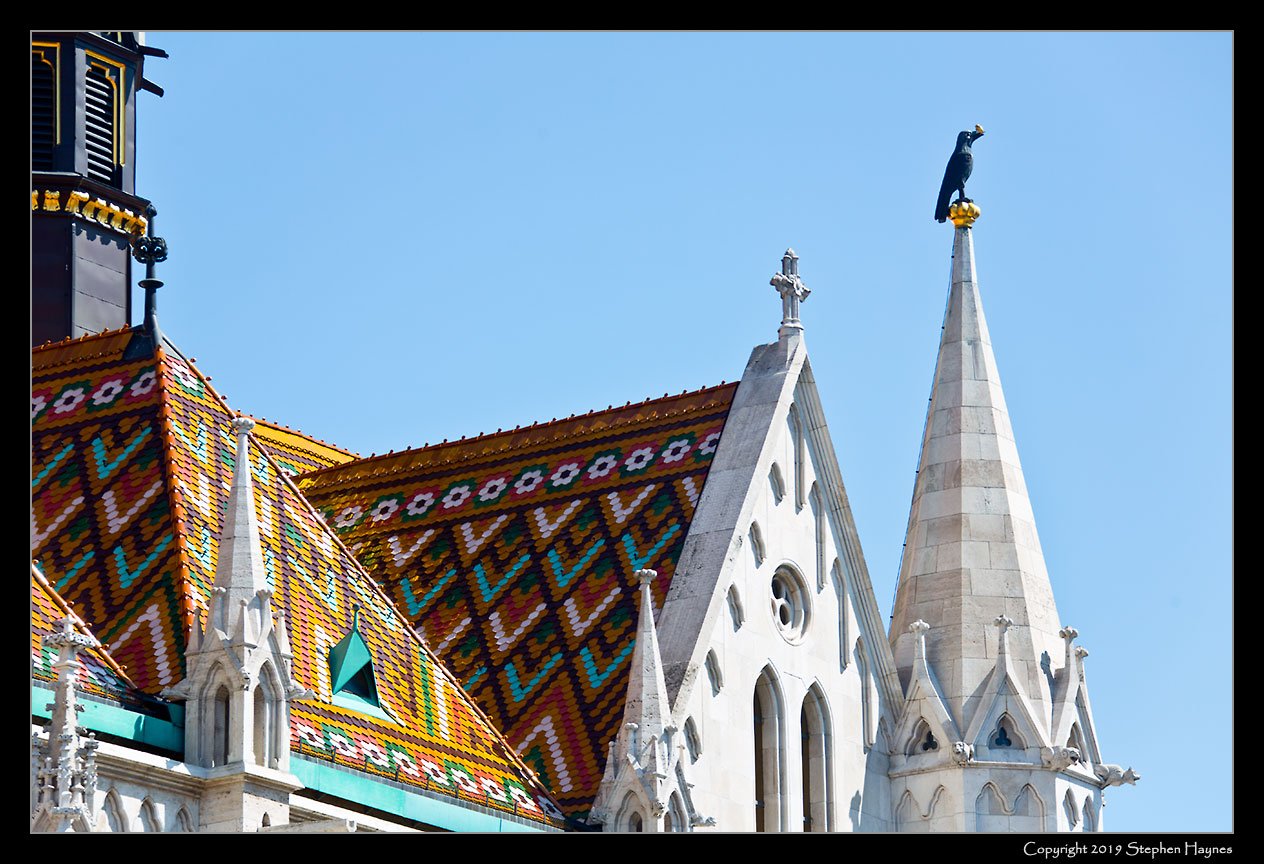
Matthias Church - Budapest
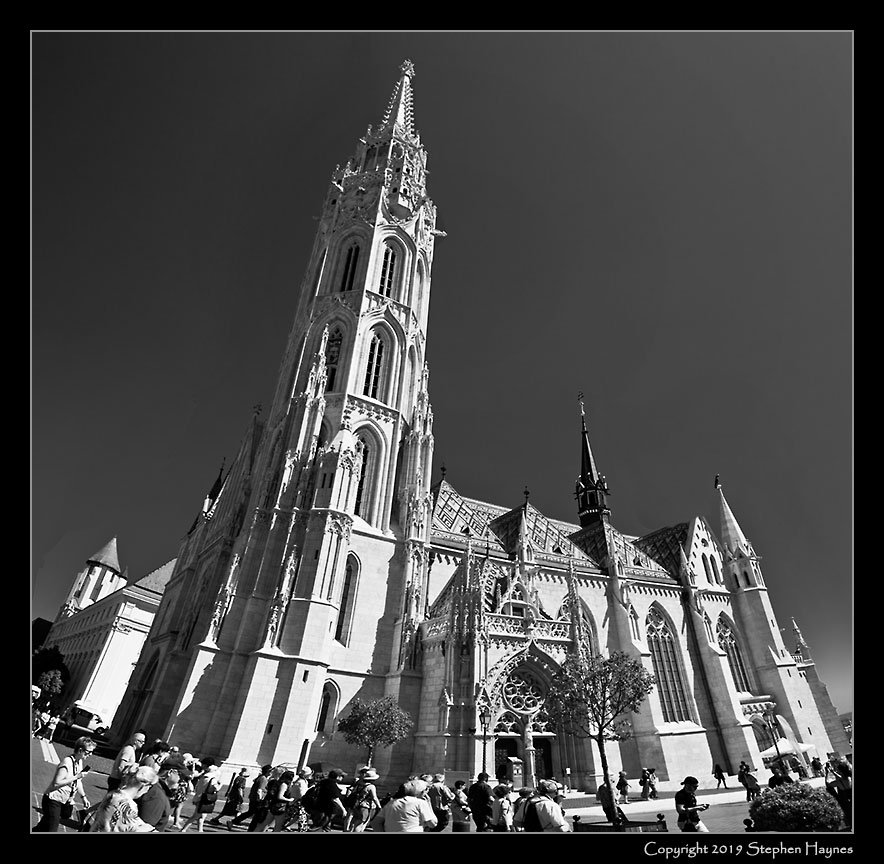
Matthias Church - Budapest

Matthias Church - Budapest -- Beginning with this image: Matthias Church interior details.
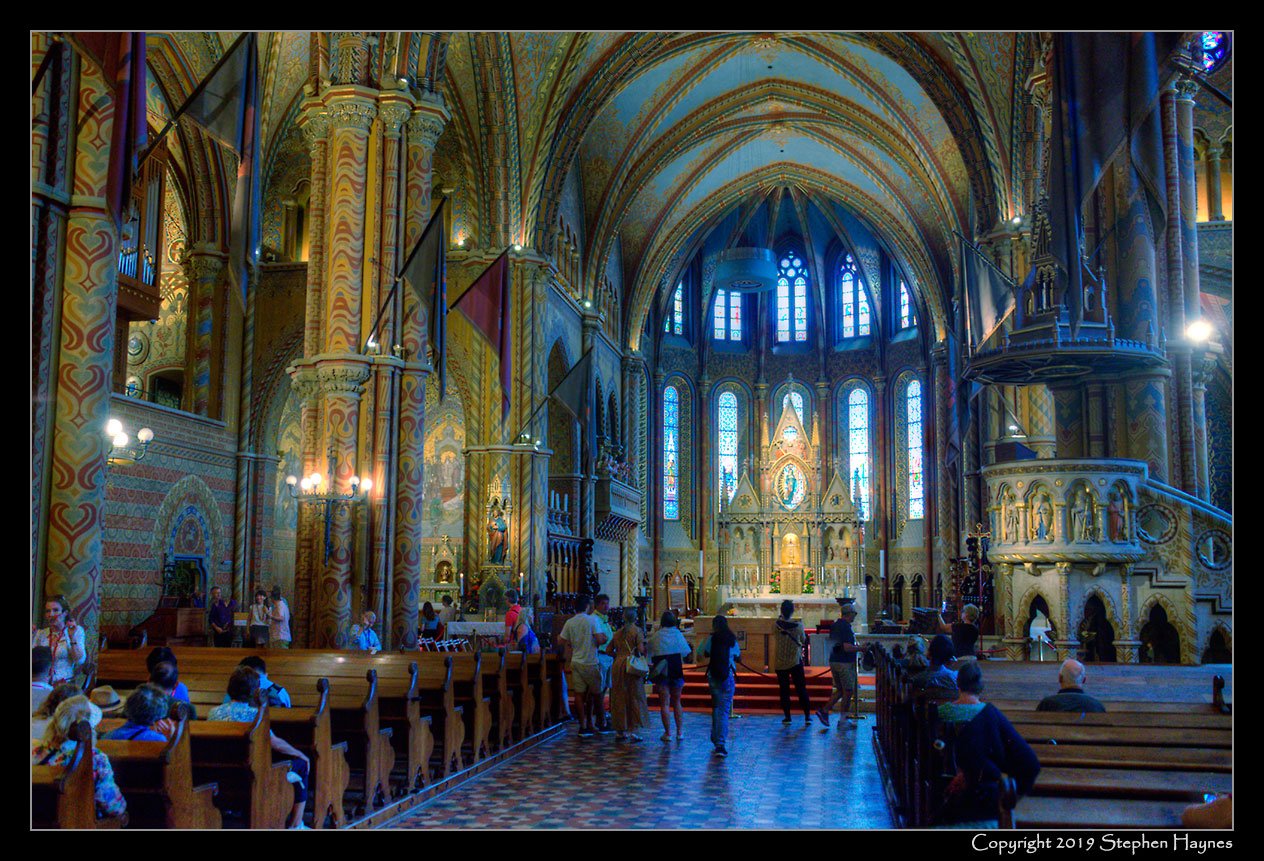
Matthias Church - Budapest
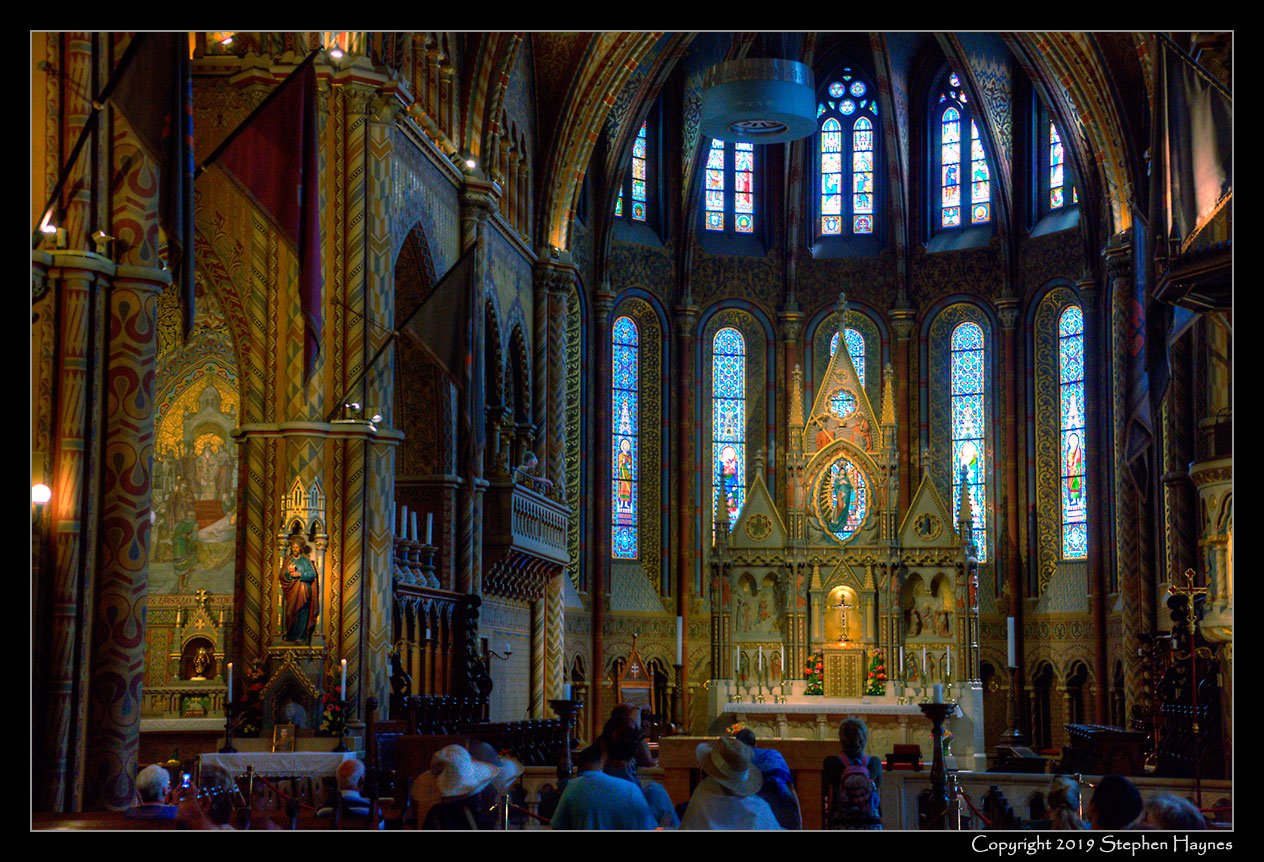
Matthias Church - Budapest

Matthias Church - Budapest
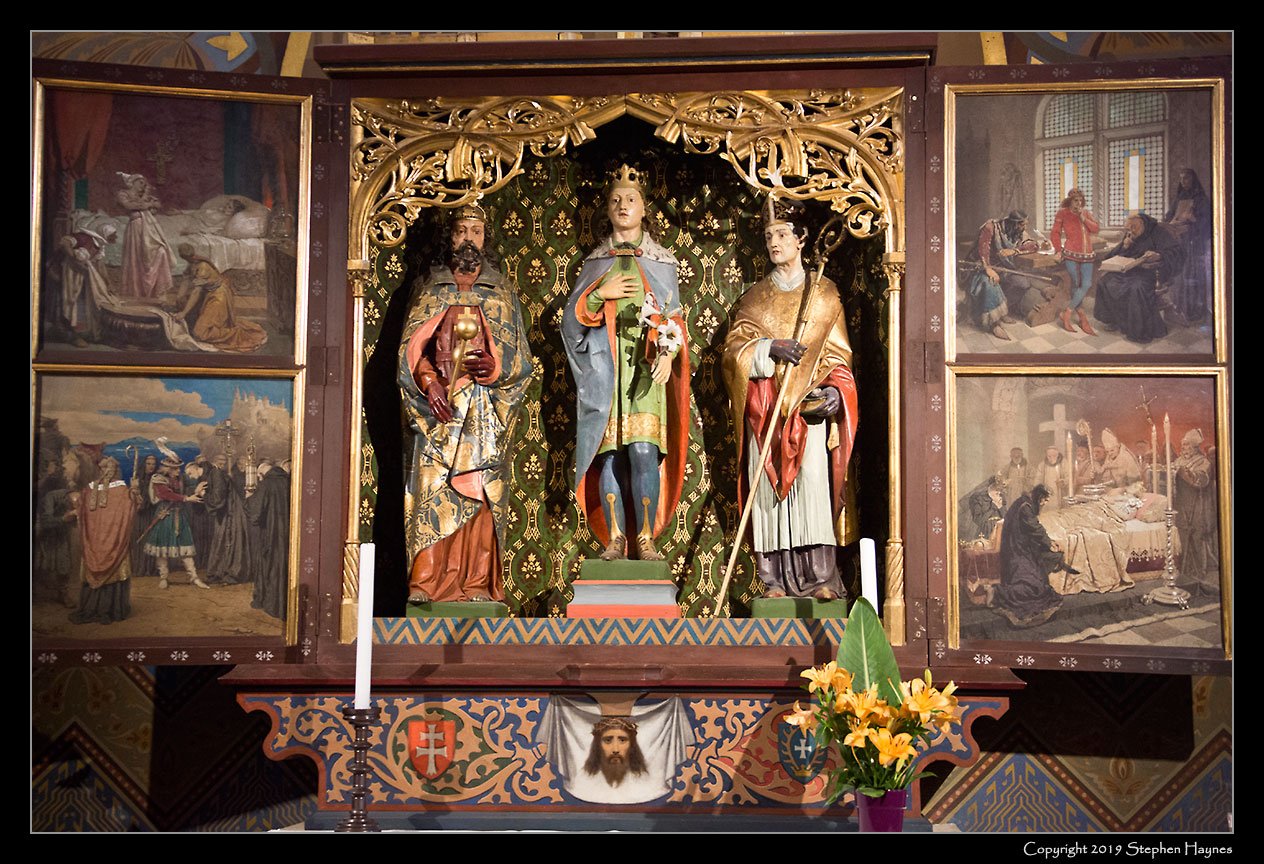
Matthias Church - Budapest
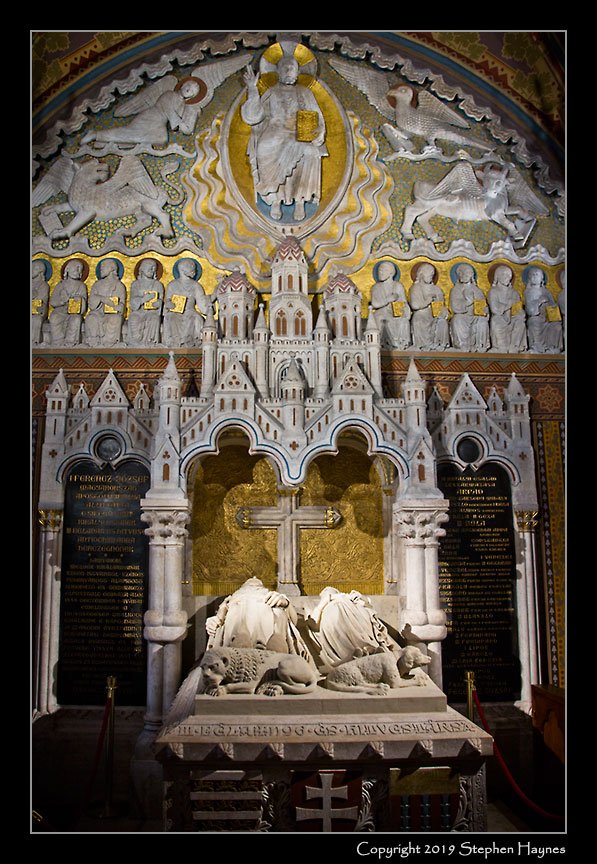
Matthias Church - Budapest -- Tomb of Béla III (Hungarian: c. 1148 – 23 April 1196), King of Hungary and Croatia between 1172 and 1196, and his wife.

Matthias Church - Budapest
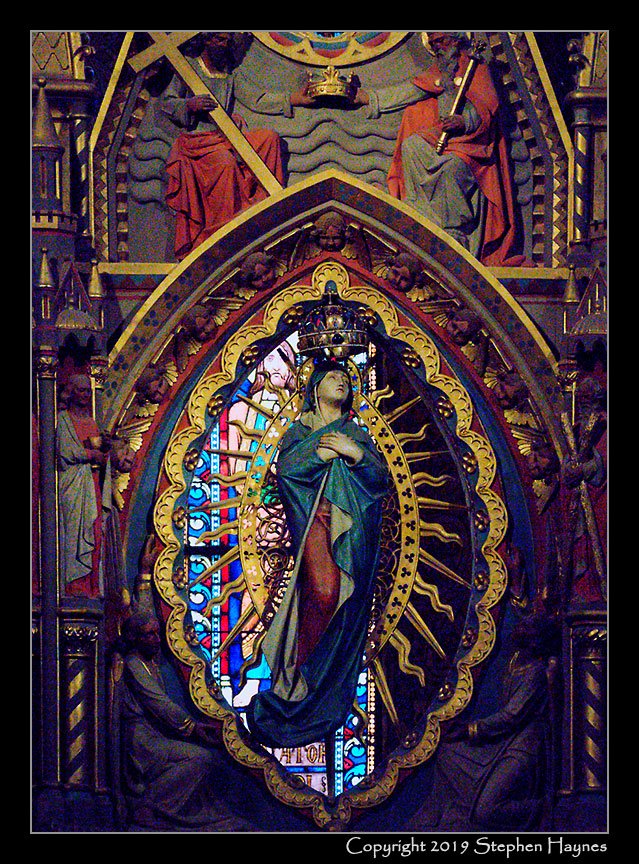
Matthias Church - Budapest

Matthias Church - Budapest

Matthias Church - Budapest

Matthias Church - Budapest
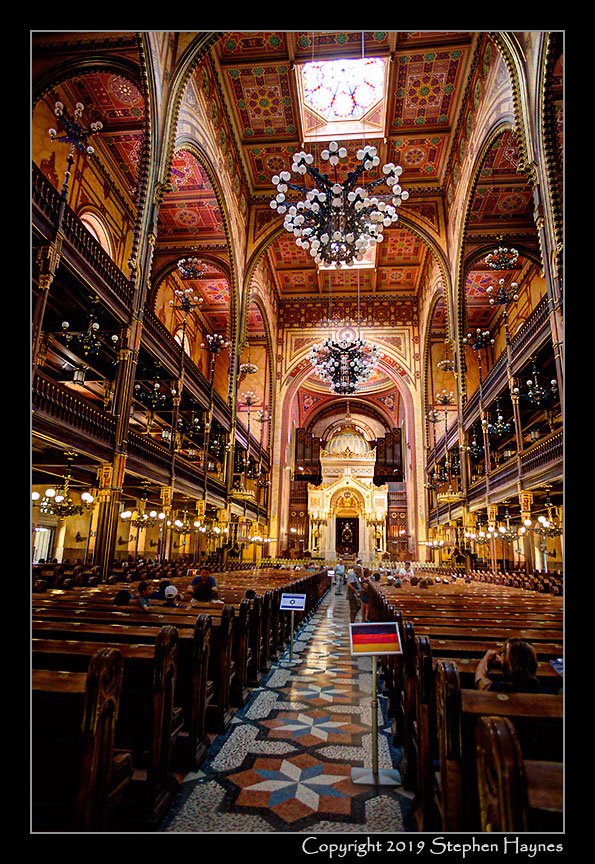
Dohány Street Synagogue - Budapest -- Wikipedia: "The Dohány Street Synagogue, also known as the Great Synagogue or Tabakgasse Synagogue, is a historical building in Erzsébetváros, the 7th district of Budapest, Hungary. It is the largest synagogue in Europe, seating 3,000 people and is a centre of Neolog Judaism. "The synagogue was built between 1854 and 1859 in the Moorish Revival style, with the decoration based chiefly on Islamic models from North Africa and medieval Spain (the Alhambra). The synagogue's Viennese architect, Ludwig Förster, believed that no distinctively Jewish architecture could be identified, and thus chose 'architectural forms that have been used by oriental ethnic groups that are related to the Israelite people, and in particular the Arabs'. The interior design is partly by Frigyes Feszl. "The Dohány Street Synagogue complex consists of the Great Synagogue, the Heroes' Temple, the graveyard, the Memorial and the Jewish Museum, which was built on the site on which Theodor Herzl's house of birth stood. Dohány Street itself, a leafy street in the city center, carries strong Holocaust connotations as it constituted the border of the Budapest Ghetto."

Dohány Street Synagogue - Budapest
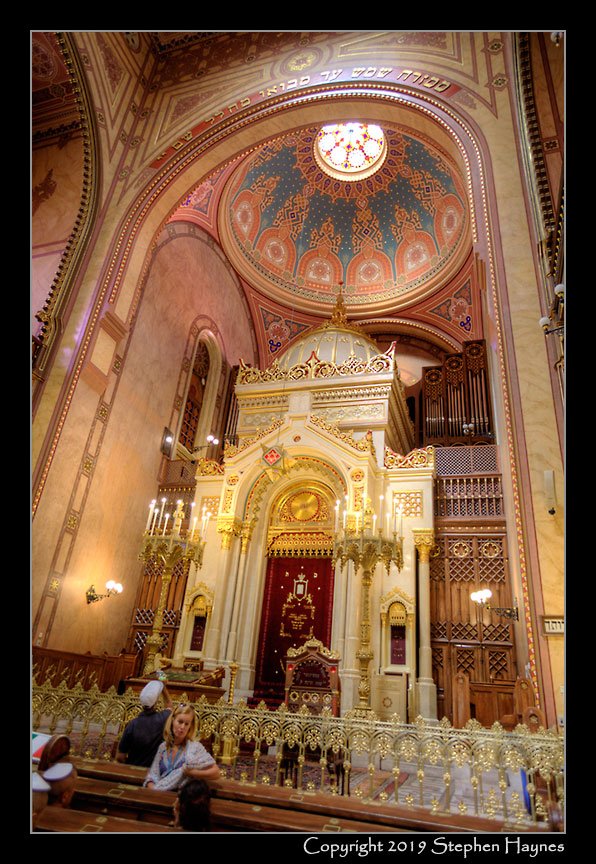
Dohány Street Synagogue - Budapest

Dohány Street Synagogue - Budapest

Dohány Street Synagogue - Budapest
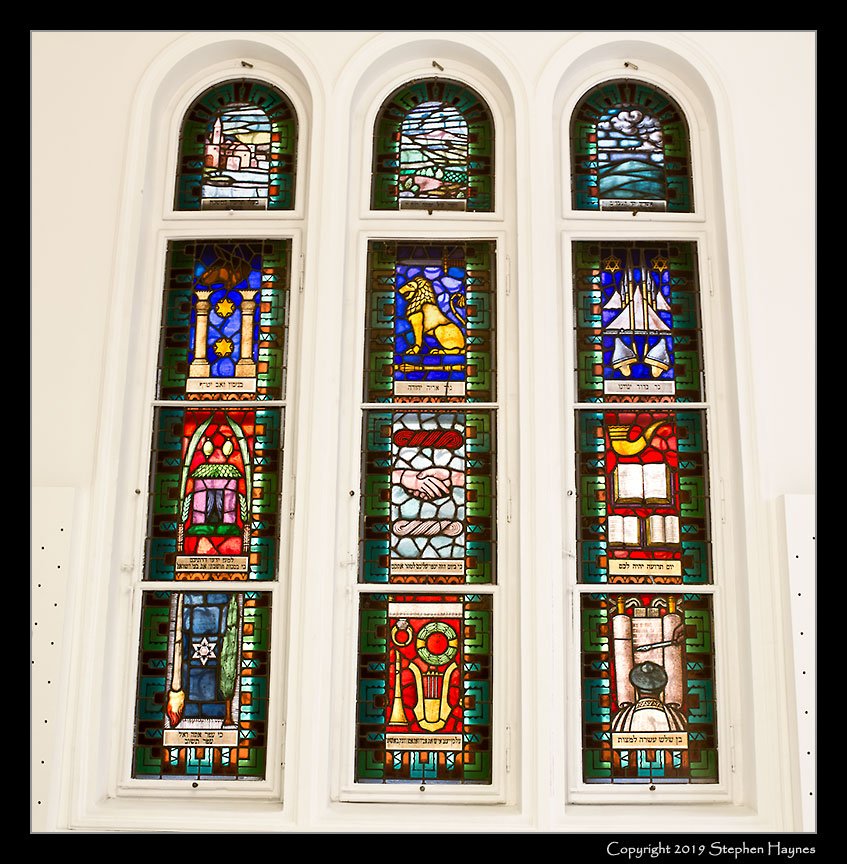
Dohány Street Synagogue Museum - Budapest -- A stained glass window on display in the synagogue museum, which is directly adjacent to the synagogue itself and well worth visiting for its many relics from pre-WWII Budapest Jewish life, plus some explanation of progress and impact of the Holocaust on Jewish life in the city.

Dohány Street Synagogue - Budapest -- Wikipedia: "In 1944, the Dohány Street Synagogue was part of the Jewish Ghetto for the city Jews and served as shelter for many hundreds. Over two thousand of those who died in the ghetto from hunger and cold during the winter 1944-1945 are buried in the courtyard of the synagogue. "It is not customary to have a cemetery next to a synagogue, and the establishment of the 3,000 square meter cemetery was only the result of historical circumstances. In 1944, as a part of the Eichmann-plan, 70,000 Jews were relocated to the Ghetto of Pest. Until 18 January 1945, when the Russians liberated the ghetto, around 8,000 to 10,000 people had died, although, one part of the deceased were transferred to the Kozma Street Cemetery, but 2,000 people were buried in the makeshift cemetery. In memory of those who had died, there is a memorial by the sculptor, Imre Varga, depicting a weeping willow with the names and tattoo numbers of the dead and disappeared just behind the Synagogue, in the Raoul Wallenberg Holocaust Memorial Park. "The Raoul Wallenberg Emlékpark (memory park) in the rear courtyard holds the Memorial of the Hungarian Jewish Martyrs — at least 400,000 Hungarian Jews were murdered by the Nazis. Made by Imre Varga, it resembles a weeping willow whose leaves bear inscriptions with the names of victims. There is also a memorial to Wallenberg and other Righteous Among the Nations, among them: Swiss Vice-consul Carl Lutz; Giorgio Perlasca, an Italian man who, with a strategic escamotage, declared himself the Spanish consul, releasing documents of protection and current passports to Jews in Budapest without distinction (he saved five thousand); Mons. Angelo Rotta, an Italian Prelate Bishop and Apostolic Nuncio of the State of Vatican City in Budapest, which issued protective sheets, misrepresentations of baptism (to save them from forced labor) and Vatican passports to Jews, without distinction of any kind present in Budapest (saving fifteen thousand), who saved, with his secretary Mons. Gennaro Verolino tens of thousands of Hungarian Jews during World War II. Carlos de Liz-Texeira Branquinho a Portuguese diplomat, serving as Portugal’s Chargé d'Affaires in Budapest in 1944, issued protective Passports to hundreds of Jewish families, altogether about 1,000 lives were saved due to his actions. Carlos Sampaio Garrido the Portuguese Ambassador who resisted the Hungarian political police when the police raided his home arresting his guests. The Ambassador physically resisted the police and was also arrested but managed to have his guests released by invoking the extraterritorial legal rights of diplomatic legations; five of the guests were members of the famous Gabor family."
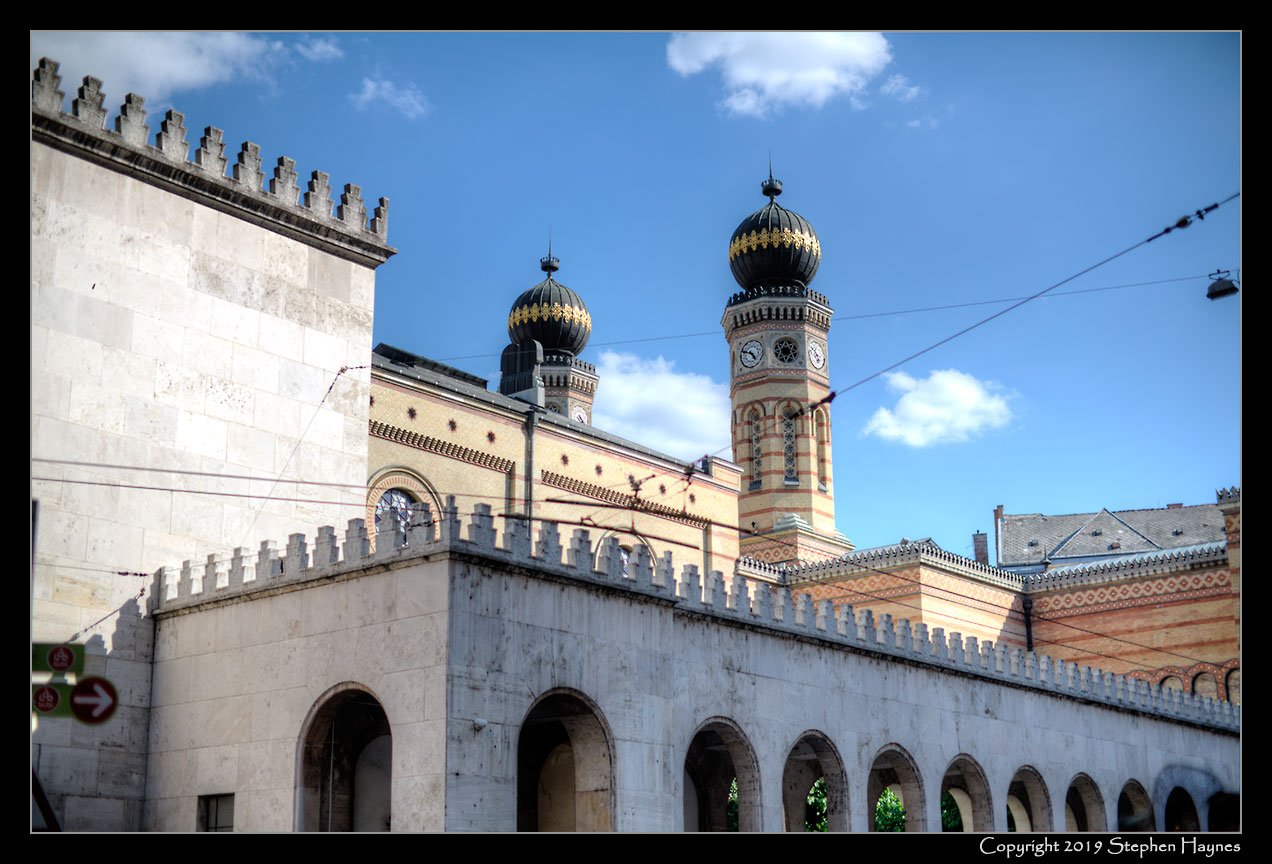
Dohány Street Synagogue - Budapest
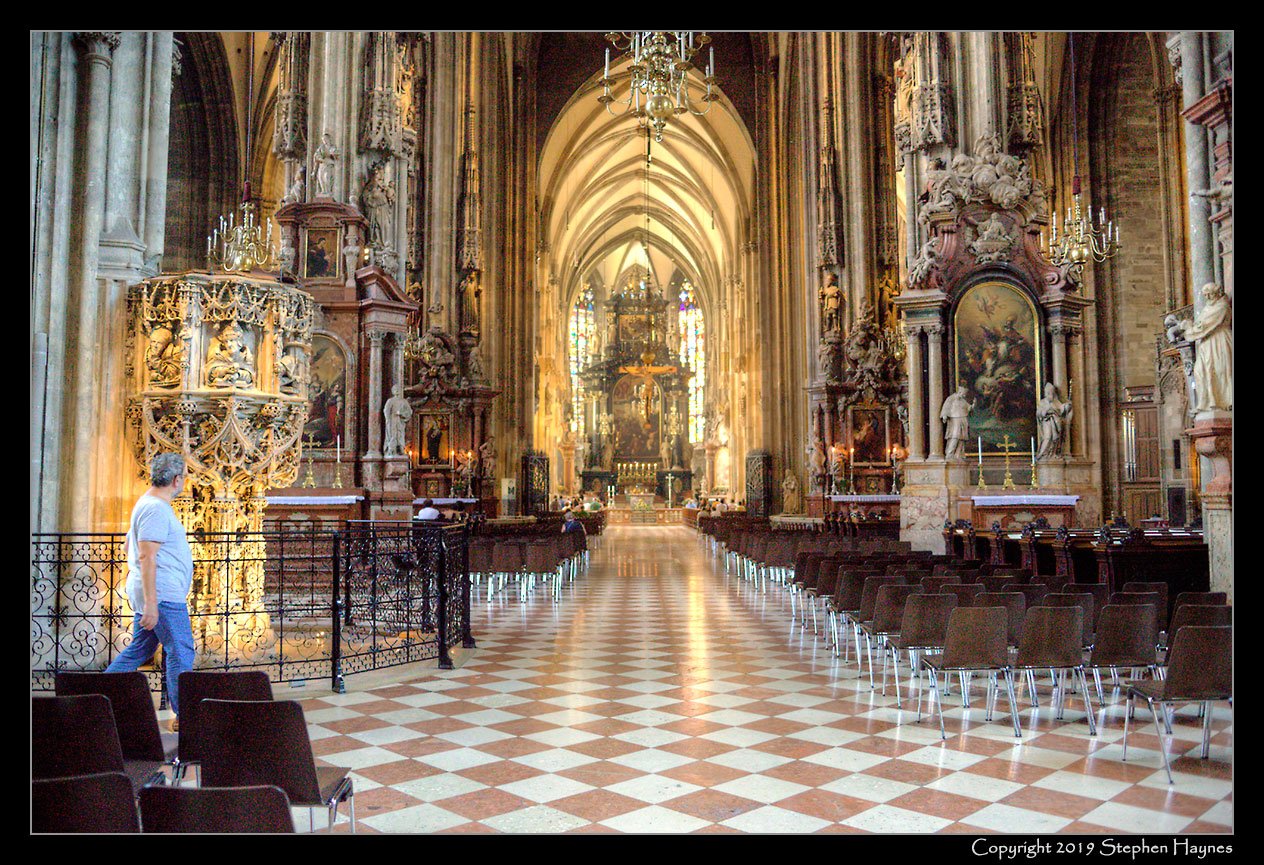
St. Stephen’s Church - Vienna -- It being Sunday, we were not permitted to explore the church beyond the entryway, from which this HDR photo was taken.
![Stift Dürnstein - Dürnstein --
Wikipedia (translated from the German): "Stift Dürnstein is a former monastery in Dürnstein in the Wachau [Valley] in Lower Austria. Today the buildings and the large property belong to the Augustinerchorherren-Stift H](https://images.squarespace-cdn.com/content/v1/619bd2877e4ad11ef537db29/93f2c993-ae57-4a87-9c8e-8f8d1d995582/Viking_Europe_Cruise_-_June-July_2019_253.jpg)
Stift Dürnstein - Dürnstein -- Wikipedia (translated from the German): "Stift Dürnstein is a former monastery in Dürnstein in the Wachau [Valley] in Lower Austria. Today the buildings and the large property belong to the Augustinerchorherren-Stift Herzogenburg, which also looks after the parish Dürnstein. The tower of the collegiate church with its blue-white coloring is considered the symbol of the Wachau. The collegiate church, which is also a parish church since 1745, has been consecrated as the 'Assumption of Mary in Heaven'."
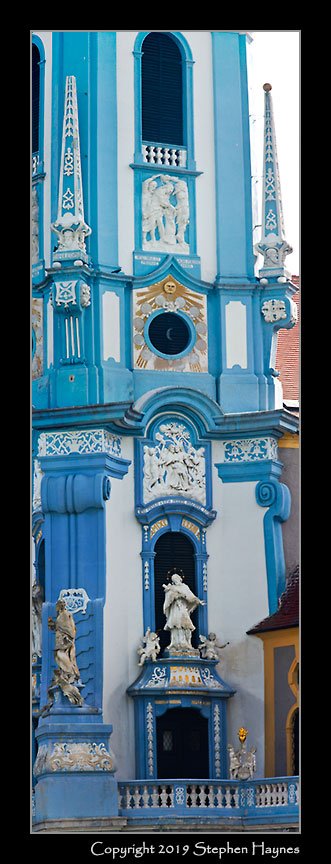
Stift Dürnstein - Dürnstein
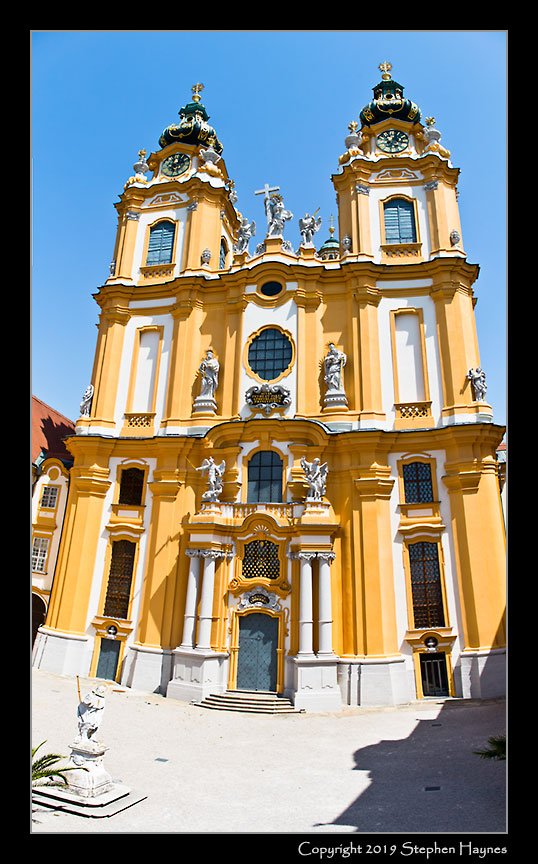
Melk Abbey - Melk -- Wikipedia: "Melk Abbey (German: 'Stift Melk') is a Benedictine abbey above the town of Melk, Lower Austria, Austria, on a rocky outcrop overlooking the Danube river, adjoining the Wachau valley. The abbey contains the tomb of Saint Coloman of Stockerau and the remains of several members of the House of Babenberg, Austria's first ruling dynasty. "The abbey was founded in 1089 when Leopold II, Margrave of Austria gave one of his castles to Benedictine monks from Lambach Abbey. A monastic school, the Stiftsgymnasium Melk, was founded in the twelfth century, and the monastic library soon became renowned for its extensive manuscript collection. The monastery's scriptorium was also a major site for the production of manuscripts. In the fifteenth century the abbey became the centre of the Melk Reform movement which reinvigorated the monastic life of Austria and Southern Germany. "Today's Baroque abbey was built between 1702 and 1736 to designs by Jakob Prandtauer. Particularly noteworthy are the abbey church with frescos by Johann Michael Rottmayr and the library with countless medieval manuscripts, including a famed collection of musical manuscripts and frescos by Paul Troger." We were told not to photograph within the Abbey, including the church, which had more gold leaf than any church I've ever been in. Photographs may be found in the Wikipedia article (https://en.wikipedia.org/wiki/Melk_Abbey).
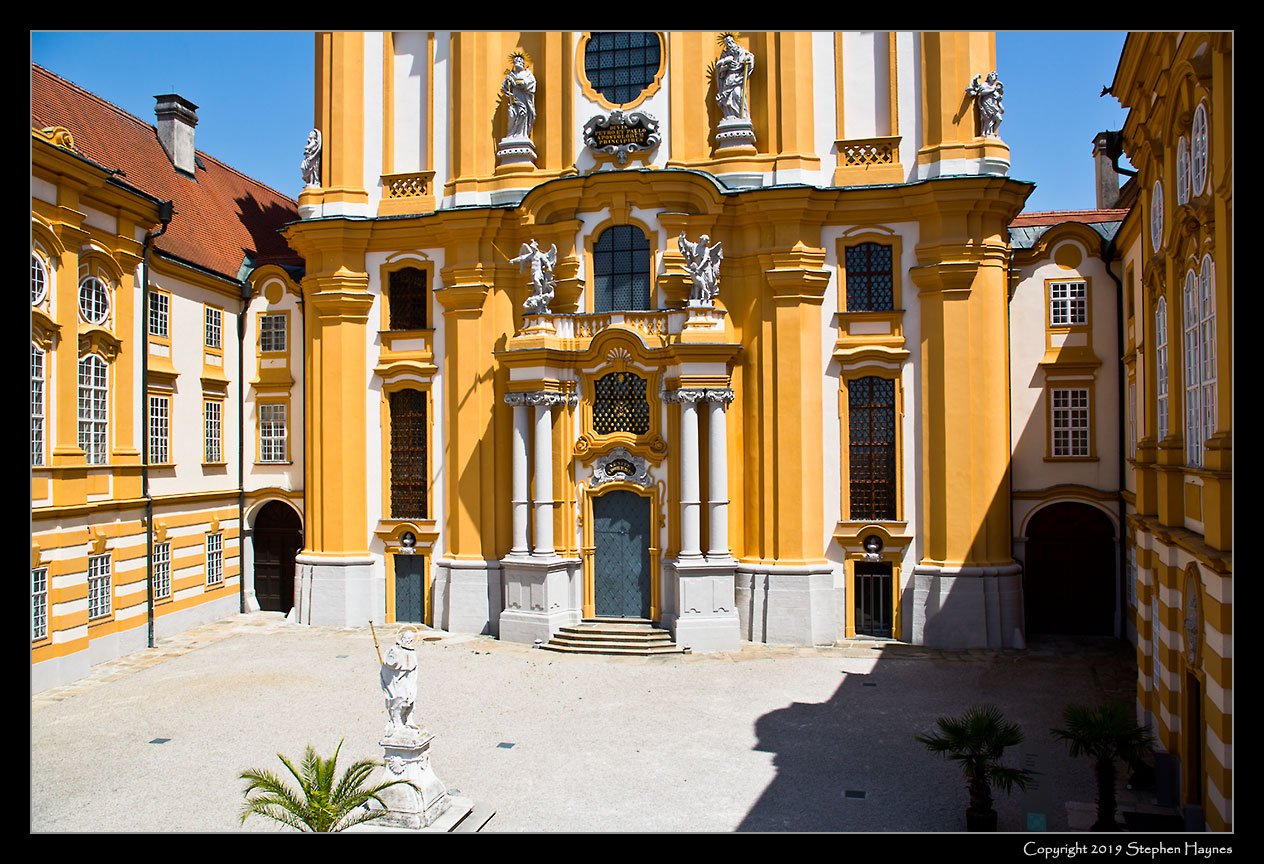
Melk Abbey - Melk
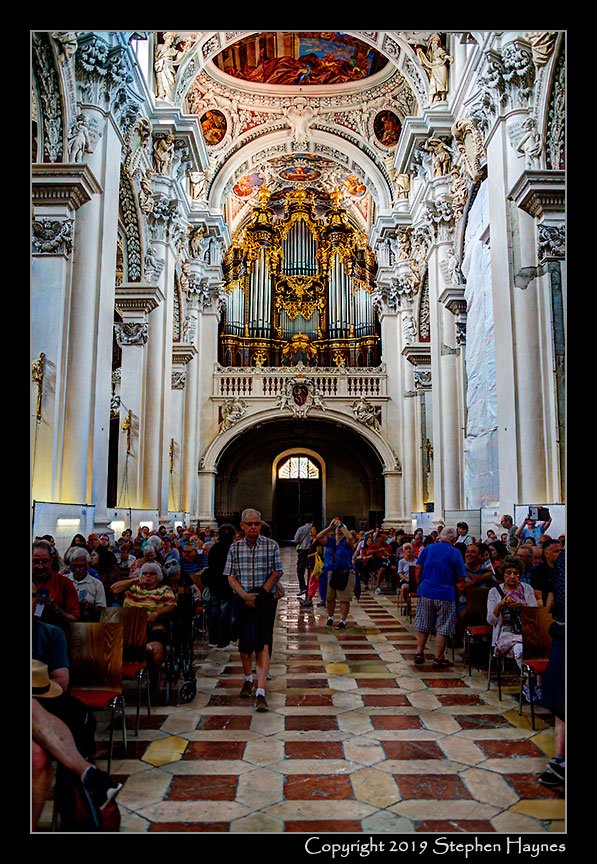
St. Stephen’s Cathedral - Passau -- A highlight of our trip was an organ concert at Passau's St. Stephen's Cathedral. Wikipedia: "St. Stephen's Cathedral is a baroque church from 1688 in Passau, Germany, dedicated to Saint Stephen. It is the seat of the Catholic Bishop of Passau and the main church of his diocese. "Since 730, there have been many churches built on the site of the current cathedral. The current church, a baroque building around 100 metres (328 ft) long, was built from 1668 to 1693 after a fire in 1662 destroyed its predecessor, of which only the late gothic eastern side remains. The cathedral's overall plan was made by Carlo Lurago, its interior decoration by Giovanni Battista Carlone, and its frescos by Carpoforo Tencalla. "Over time, Passau Cathedral has acquired the largest organ outside of the United States. It is also the largest cathedral organ in the world. The organ currently has 17,774 pipes and 233 registers, all of which can be played with the five-manual general console in the gallery. Portions of the organ have their own mechanical-action or electric-action consoles, for a total of six consoles."
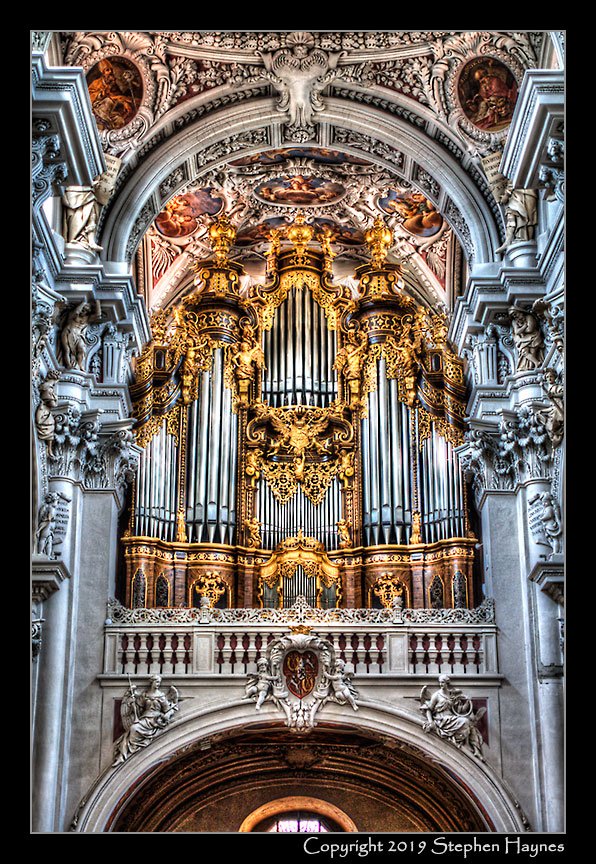
St. Stephen’s Cathedral - Passau -- Detail of part of the organ's pipes.

St. Stephen’s Cathedral - Passau -- The sculpture in the Choir, above the altar, was very modern and a bit discordant. For example, I think the figure at right was a wizard.
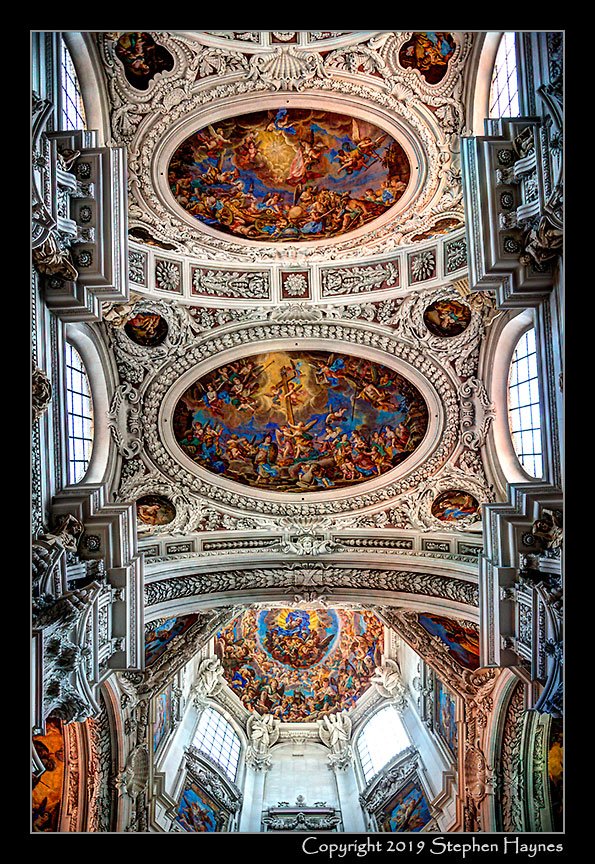
St. Stephen’s Cathedral - Passau -- The cathedral's ceiling was extraordinary. Seen here and in detail images that follow are HDR images showing the panels. You will notice considerable color noise in the detail closeups, since a high ISO was necessary to capture the best images of the ceiling.

St. Stephen’s Cathedral - Passau
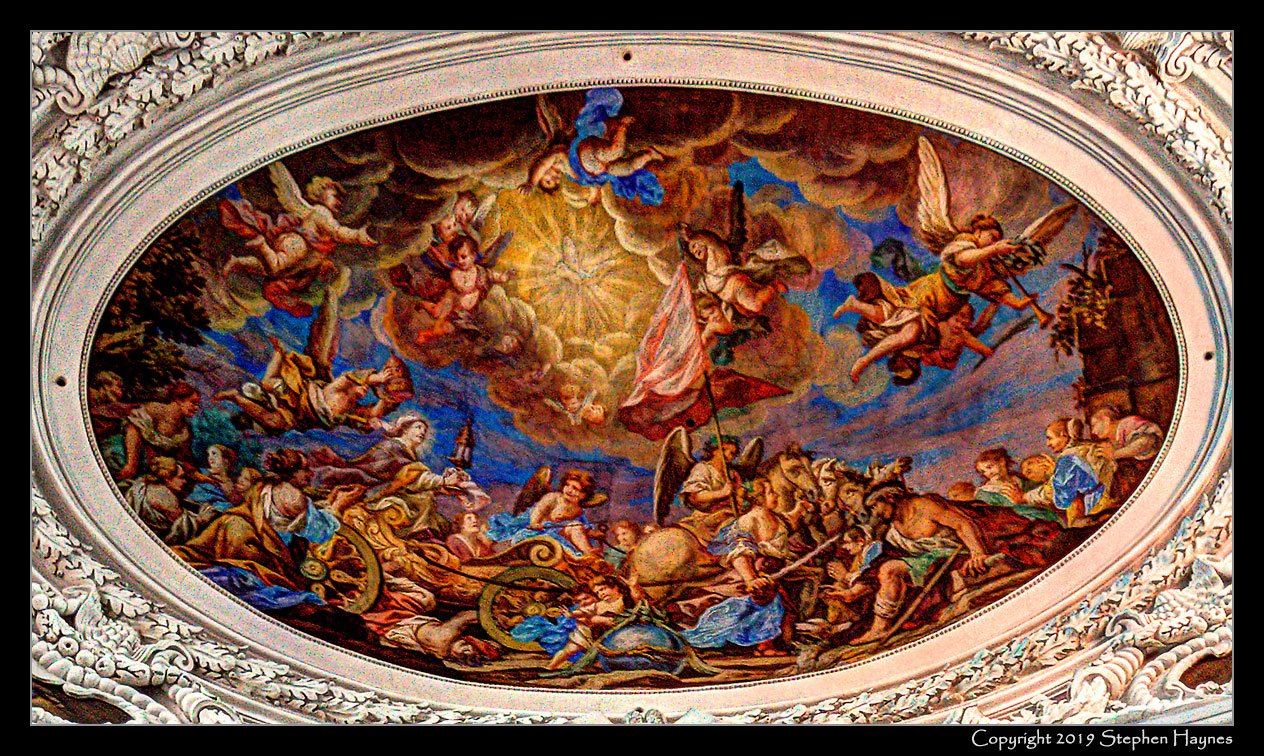
St. Stephen’s Cathedral - Passau

St. Stephen’s Cathedral - Passau

St. Stephen’s Cathedral - Passau

St. Stephen’s Cathedral - Passau -- The cathedral's gilded pulpit.

Site of the Medieval Synagogue - Regensburg -- From an explanatory panel at the site: "This place of encounter was erected by the Israeli sculptor Dani Karavan (b. 1930) on the foundations of the medieval synagogue. It is a reminder of Christians and Jews living together, which had been a prominent feature of Regensburg civic life since 981 [CE]. The Jewish quarter was razed to the ground in 1519 with the approval of [the] City Council. In 1995 traces of the pogrom resurfaced in the course of restructuring works on the Neupfarrplatz [New Parish Plaza] "Dani Karavan has reproduced the layout of the synagoge in an artistic manner and thus brings home an important chapter in Regensburg's history "Today people of all religions come together here. Regensburg residents have accepted this place full of gratitude and respect. It is meant to be a sign and food for thought for their children and children's children "Hebrew characters in the area of the former torah shrine of the synagogue spell out the word 'Misrach,' [meaning] 'place of lighting up' or 'East'."

Site of the Medieval Synagogue - Regensburg
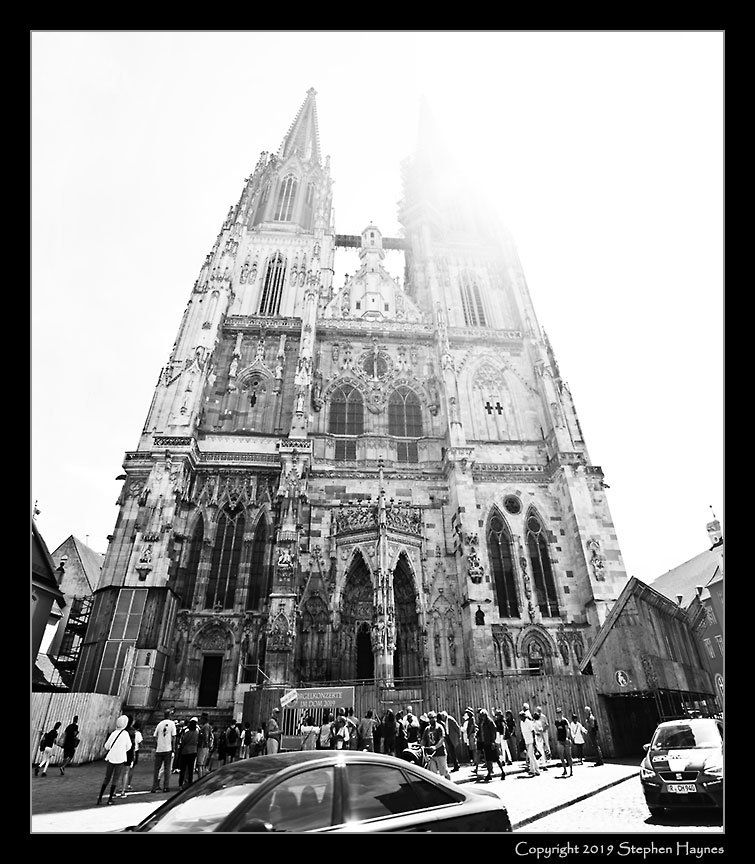
St. Peter’s Cathedral - Regensburg -- Wikipedia: "Regensburg Cathedral, also known as St. Peter's Cathedral, is an example of important Gothic architecture within the German state of Bavaria. It is a landmark for the city of Regensburg, Germany, and the seat of the Catholic Diocese of Regensburg. "The original church called Niedermünster, which was built west of where the current cathedral stands, was built around the year 700. Where it was positioned was some distance away from the Porta Praetoria which was a northern gate of Regensburg's old legionary fortress called Castra Regina. Although it was a tomb for Erhard of Regensburg, it was at first a chapel for a royal family (more specifically a ducal family). Niedermünster burned down in 1273, and because of the good economic status of Regensburg at the time a new cathedral was able to be constructed." For more, see https://en.wikipedia.org/wiki/Regensburg_Cathedral Inside St. Peter’s Cathedral I took a number of HDR photos (following images) before the noon prayers, meditation and organ music, which we attended.
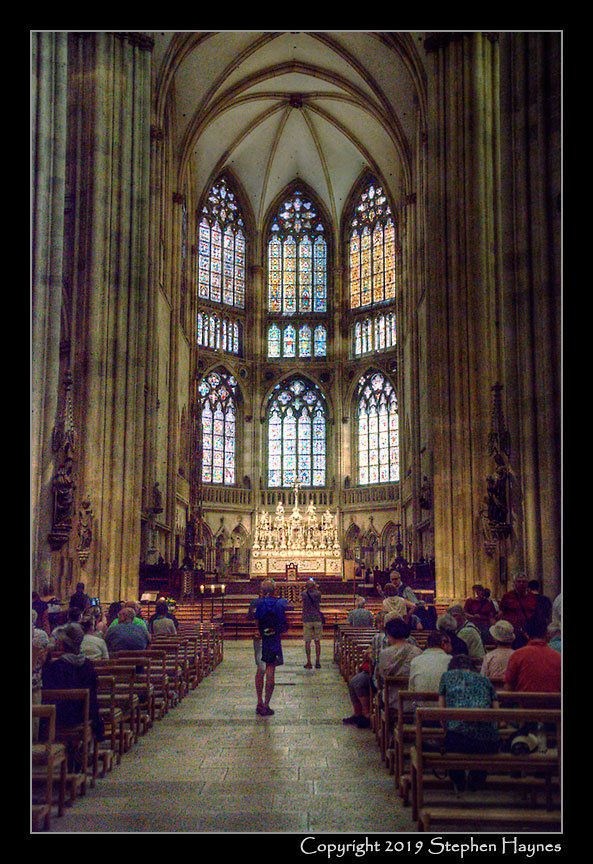
St. Peter’s Cathedral - Regensburg

St. Peter’s Cathedral - Regensburg
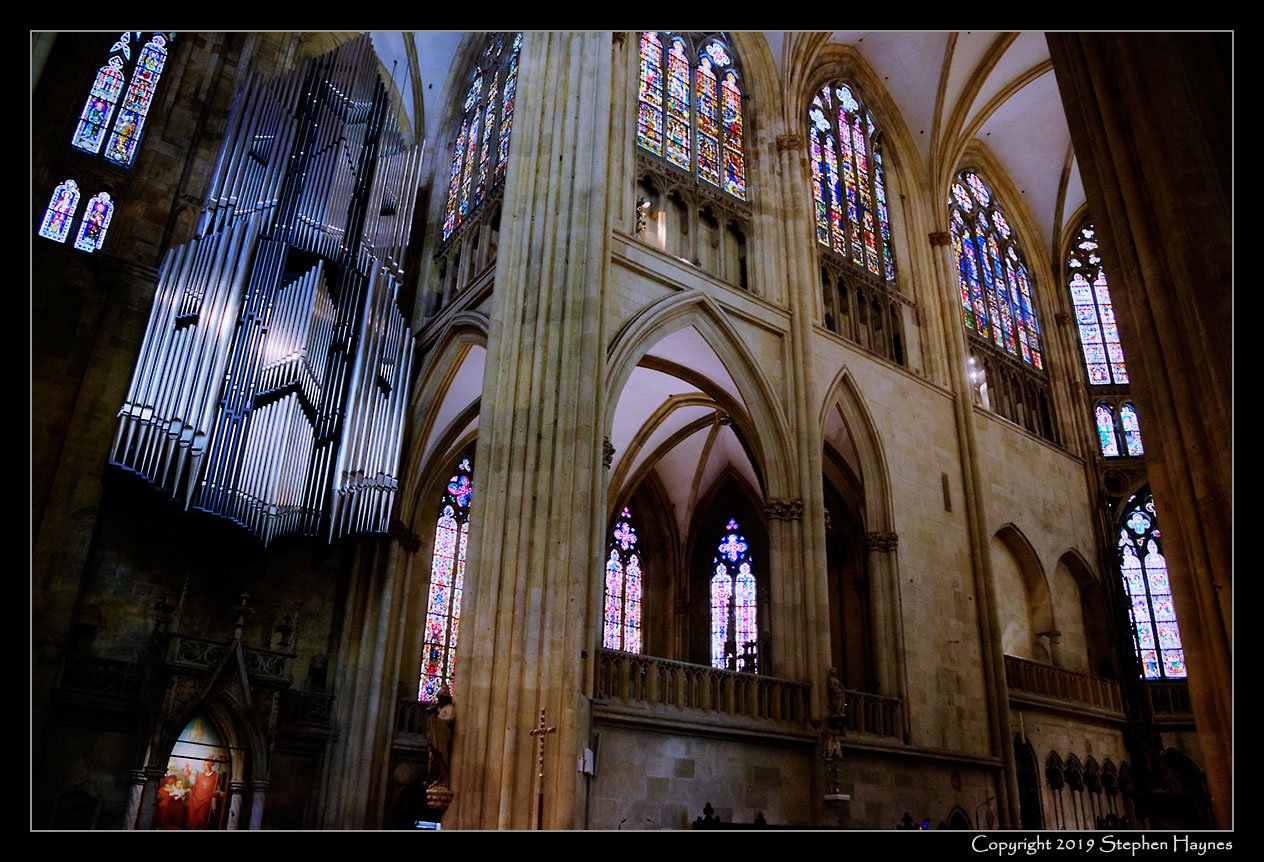
St. Peter’s Cathedral - Regensburg

St. Peter’s Cathedral - Regensburg
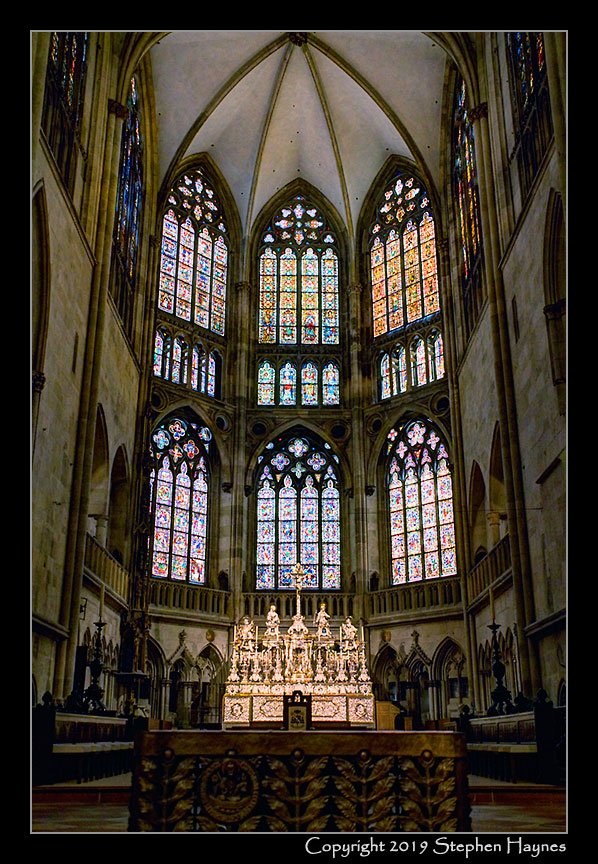
St. Peter’s Cathedral - Regensburg
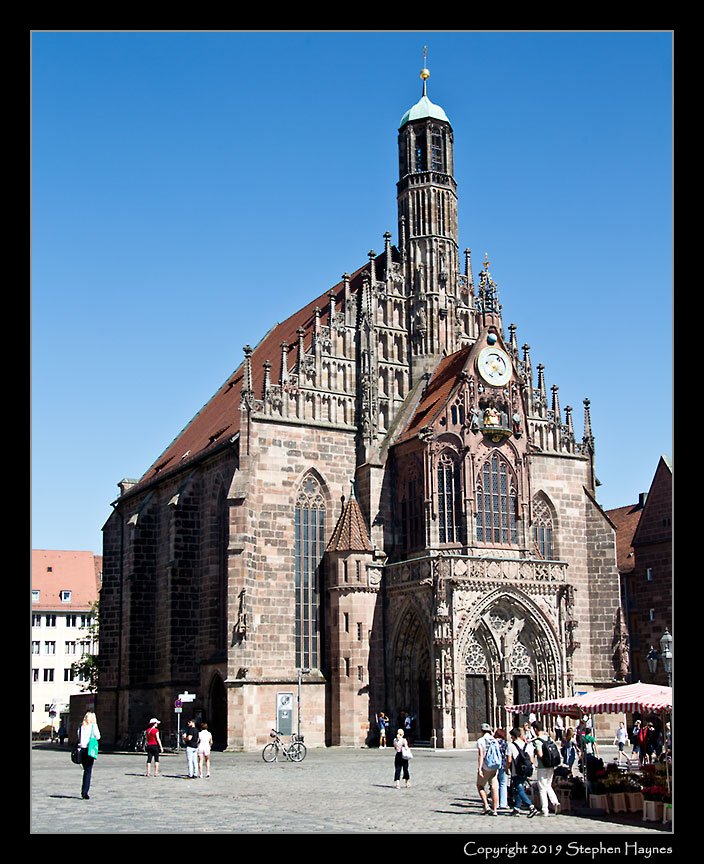
Frauenkirche ("Church of Our Lady") - Nuremberg -- Wikipedia: “The Frauenkirche ("Church of Our Lady") is a church in Nuremberg, Germany. It stands on the eastern side of the main market. An example of brick Gothic architecture, it was built on the initiative of Charles IV, Holy Roman Emperor between 1352 and 1362. The church contains many sculptures, some of them heavily restored. Numerous works of art from the Middle Ages are kept in the church, such as the so-called Tucher Altar (c. 1440, originally the high altar of the Augustinian church of St. Vitus), and two monuments by Adam Kraft (c. 1498).” I did not go in.
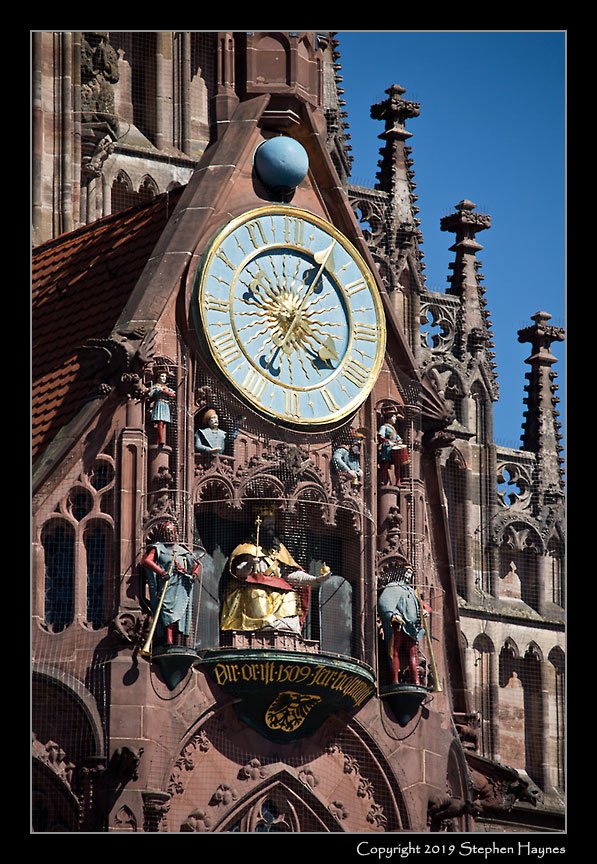
Frauenkirche ("Church of Our Lady") - Nuremberg
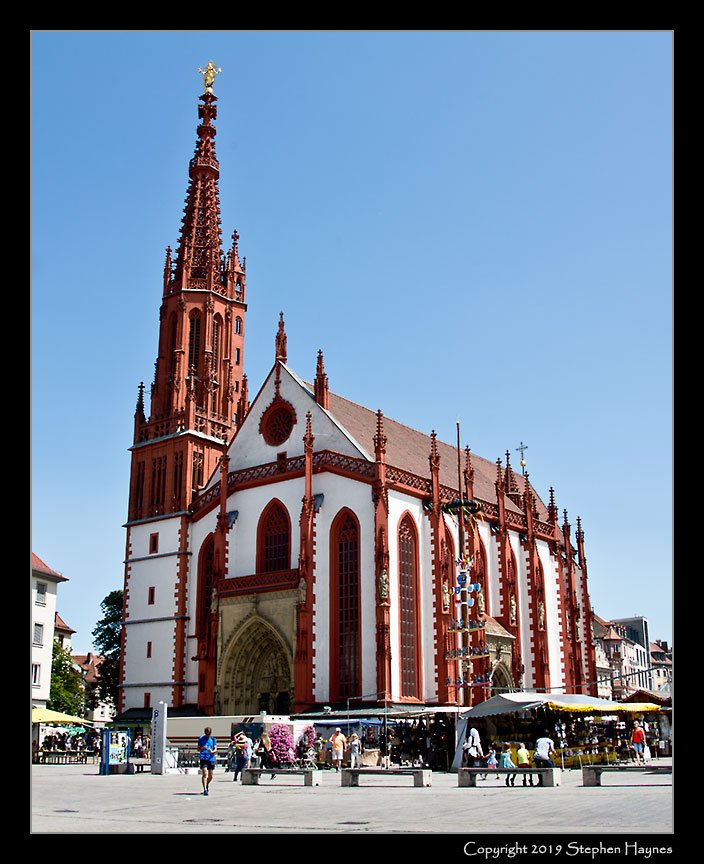
Marienkapelle - Würzburg -- Wikipedia: “The Marienkapelle is a Roman Catholic church located at the Unterer Markt (market square) of the town of Würzburg, Bavaria. It was built in the Gothic style in the 14th century. Despite its large size, it is a chapel by status, as it does not have a parish. Today it is administered by the united parishes of the Würzburg Cathedral and the Kollegiatstift Neumünster. "The chapel was heavily damaged by the Bombing of Würzburg in World War II and its interior was destroyed by flames. It was rebuilt in the 1950s and re-consecrated in 1962. .... "On 21 April 1349 the synagogue located at this site was destroyed in the course of a pogrom. There are conflicting reports about any (wooden) structures that were erected immediately after that and whether a pilgrimage was established at the site. It is also not known whether building a chapel dedicated to Mary there was intended as atonement for the murder of the local Jews or as atonement for having earlier tolerated the presence of Christ-killers. Construction of the current church started under Bishop Gerhard von Schwarzburg in 1377." We did not enter the church, fortuitously since we were then able to arrive at the parade route just in time for the Kiliani Parade, photos from which are found in the "Best" collection.

Cologne Cathedral - Cologne -- Wikipedia: “Cologne Cathedral, officially Hohe Domkirche Sankt Petrus (English: Cathedral Church of Saint Peter), is a Catholic cathedral in Cologne, North Rhine-Westphalia, Germany. It is the seat of the Archbishop of Cologne and of the administration of the Archdiocese of Cologne. It is a renowned monument of German Catholicism and Gothic architecture and was declared a World Heritage Site in 1996. It is Germany's most visited landmark, attracting an average of 20,000 people a day, and currently the tallest twin-spired church at 157 m (515 ft) tall, second in Europe after the Ulm Cathedral and third in the world. "Construction of Cologne Cathedral began in 1248 but was halted in 1473, unfinished. Work did not restart until the 1840s, and the edifice was completed to its original Medieval plan in 1880. The cathedral is the largest Gothic church in Northern Europe and has the second-tallest spires. The towers for its two huge spires give the cathedral the largest façade of any church in the world. The choir has the largest height to width ratio, 3.6:1, of any medieval church. "Cologne's medieval builders had planned a grand structure to house the reliquary of the Three Kings and fit its role as a place of worship for the Holy Roman Emperor. Despite having been left incomplete during the medieval period, Cologne Cathedral eventually became unified as 'a masterpiece of exceptional intrinsic value' and 'a powerful testimony to the strength and persistence of Christian belief in medieval and modern Europe'. .... "The cathedral suffered fourteen hits by aerial bombs during World War II. Badly damaged, it nevertheless remained standing in an otherwise completely flattened city. The twin spires were an easily recognizable navigational landmark for Allied aircraft bombing. "On March 6, 1945, an area west of the cathedral (Marzellenstrasse/Trankgasse) was the site of intense combat between American tanks of the 3rd Armored Division and a Panther [Panzer] Ausf. A of Panzer brigade 106 Feldherrnhalle. The Panther successfully knocked out a Sherman, killing three men, before it was destroyed by a T26E3 Pershing hours later. Footage of that battle survives. The destroyed Panther was later put on display at the base of the cathedral for the remainder of the war in Europe. "Repairs were completed in 1956. An emergency repair to the base of the north-west tower, carried out in 1944 using poor-quality brick taken from a nearby ruined building, remained visible as a reminder of the war until 2005, when it was decided to restore the section to its original appearance. The brick-filling can be seen in the photograph on the right." Following are HDR photos taken of the interior.
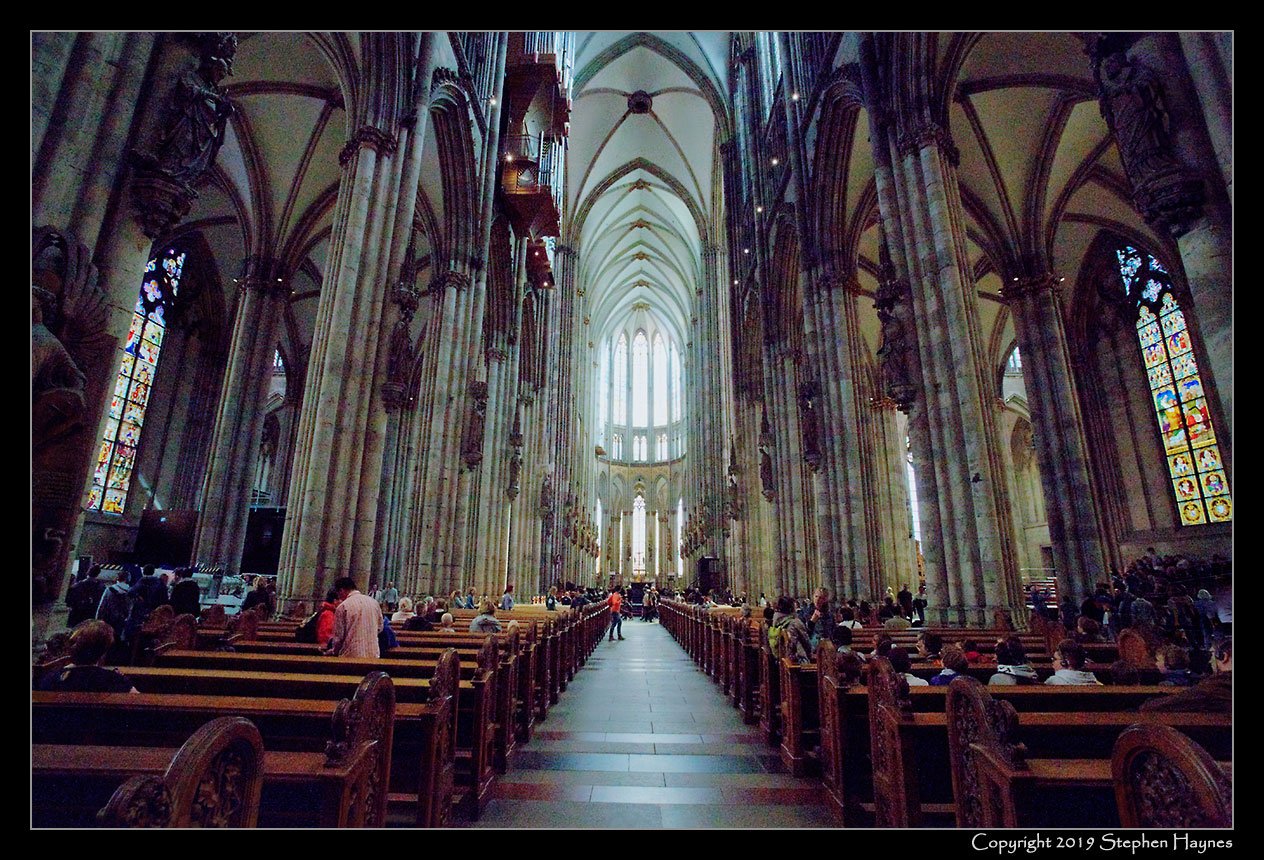
Cologne Cathedral - Cologne

Cologne Cathedral - Cologne
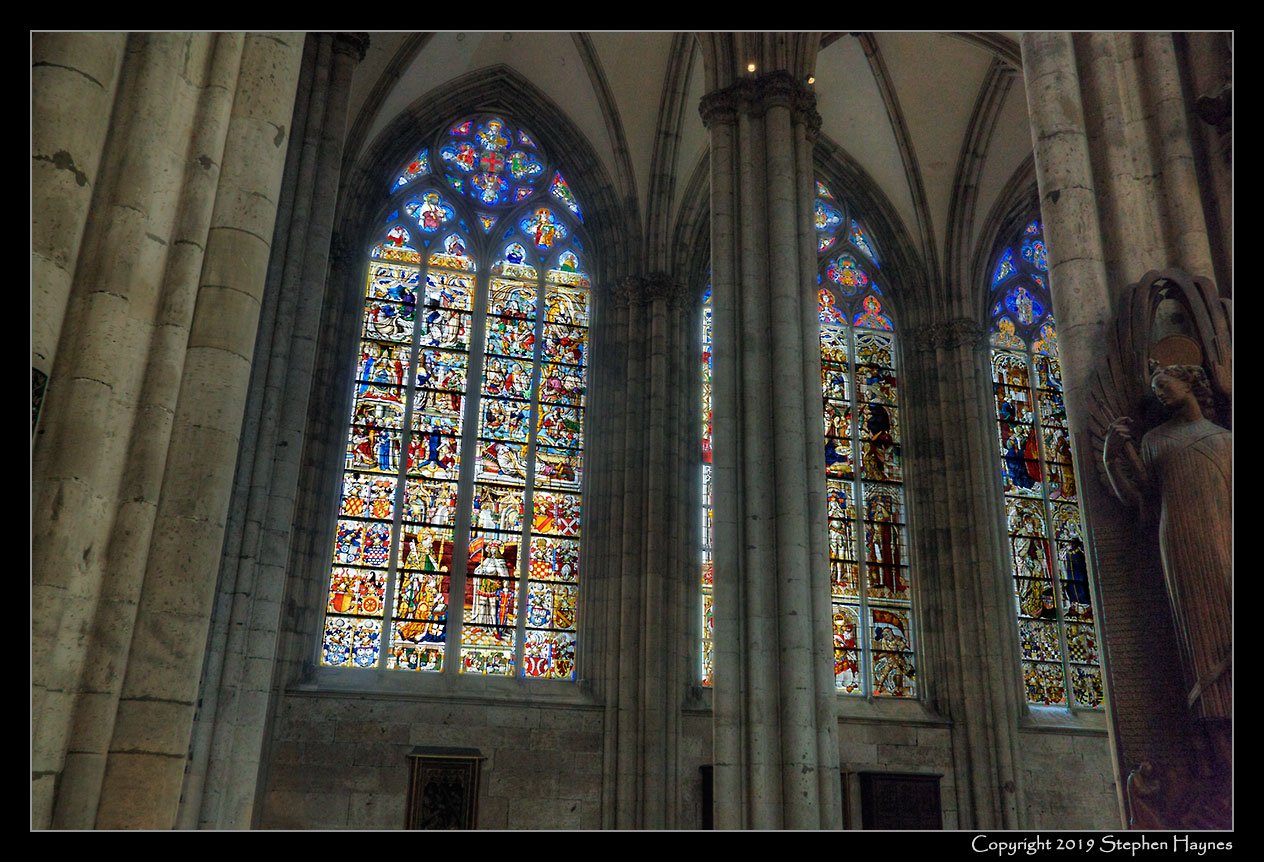
Cologne Cathedral - Cologne
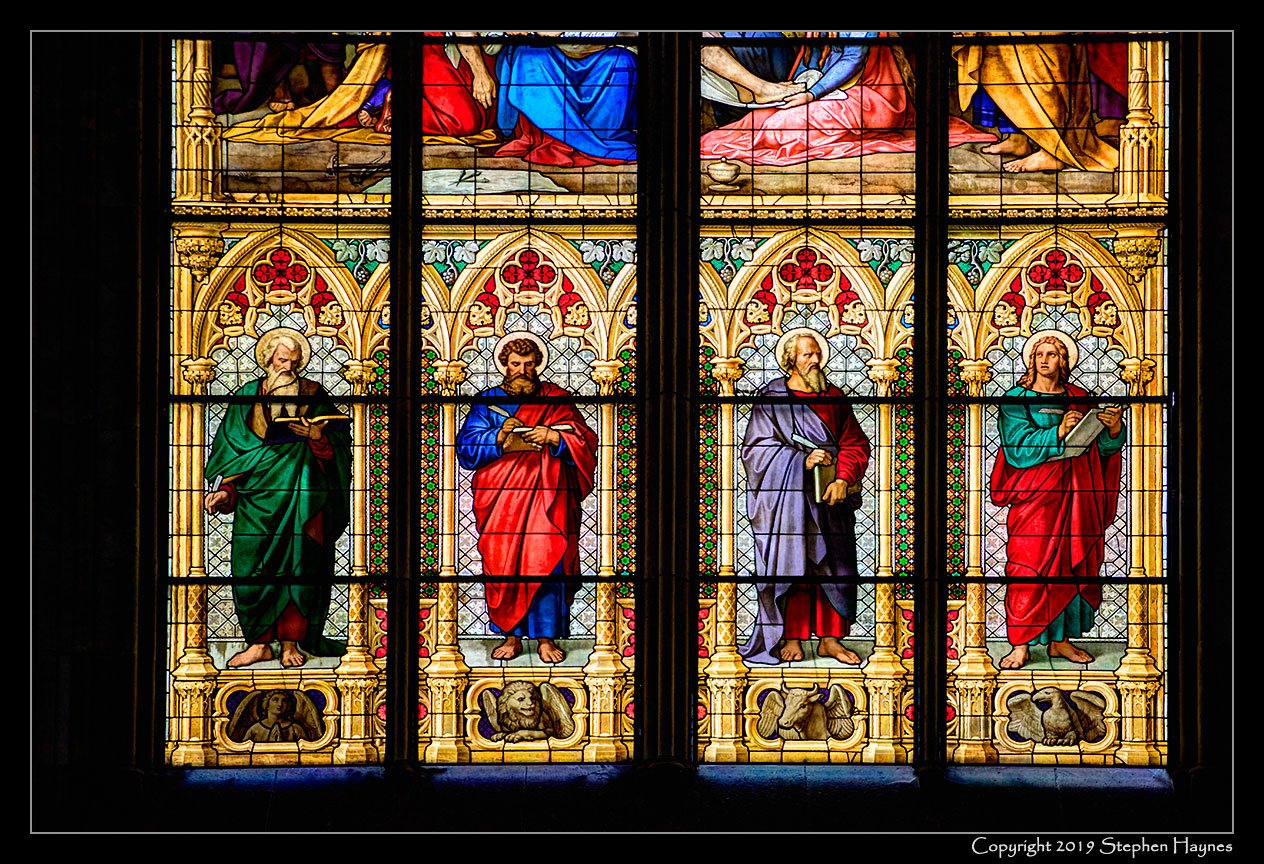
Cologne Cathedral - Cologne

Cologne Cathedral - Cologne

Cologne Cathedral - Cologne
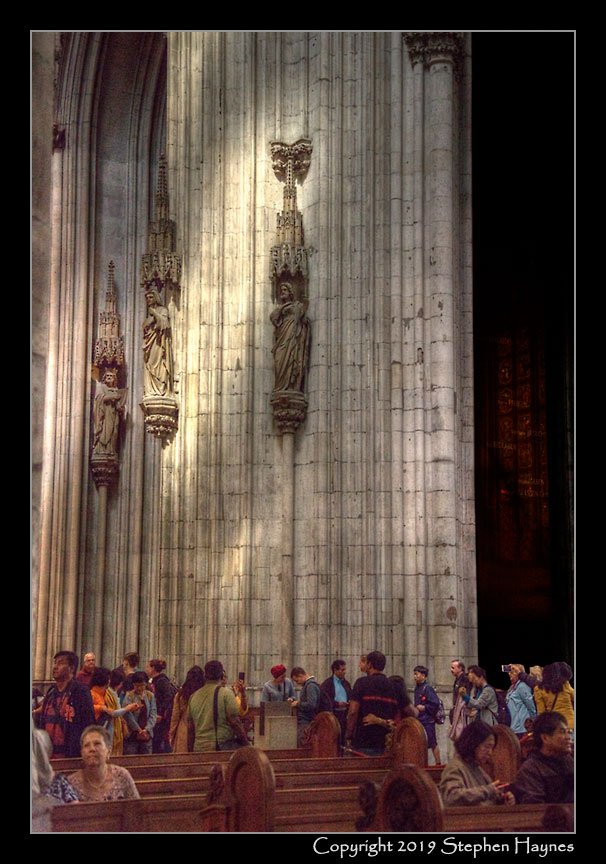
Cologne Cathedral - Cologne

Cologne Cathedral - Cologne
Villages and Vineyards.
We passed villages and their associated vineyards, all along each of the three rivers we sailed from Budapest to Amsterdam. Wines ranged from Hungarian and Austrian whites (some made from the pinot blanc grape) to the great rieslings found along the Rhine in Germany. (Not especially germane to the photos shown here, I'll note that Viking served wine gratis for both lunch and dinner throughout the cruise.)
The last two photos below are of Winningen, to which we took an excursion, a small vineyard-surrounded village on the Moselle close to Koblenz, Germany, tasting one small family-owned winery's rieslings. The winery's wines were well made although not outstanding, except for a bottle I purchased to drink aboard the ship: a 2012 Domgarten Eiswein from Weingut Freiherr von Heddesdorff, for an amazing price of 33 Euros -- very sweet, slightly botrytised, but with ample acidity that brought a sprightly balance to the wine.
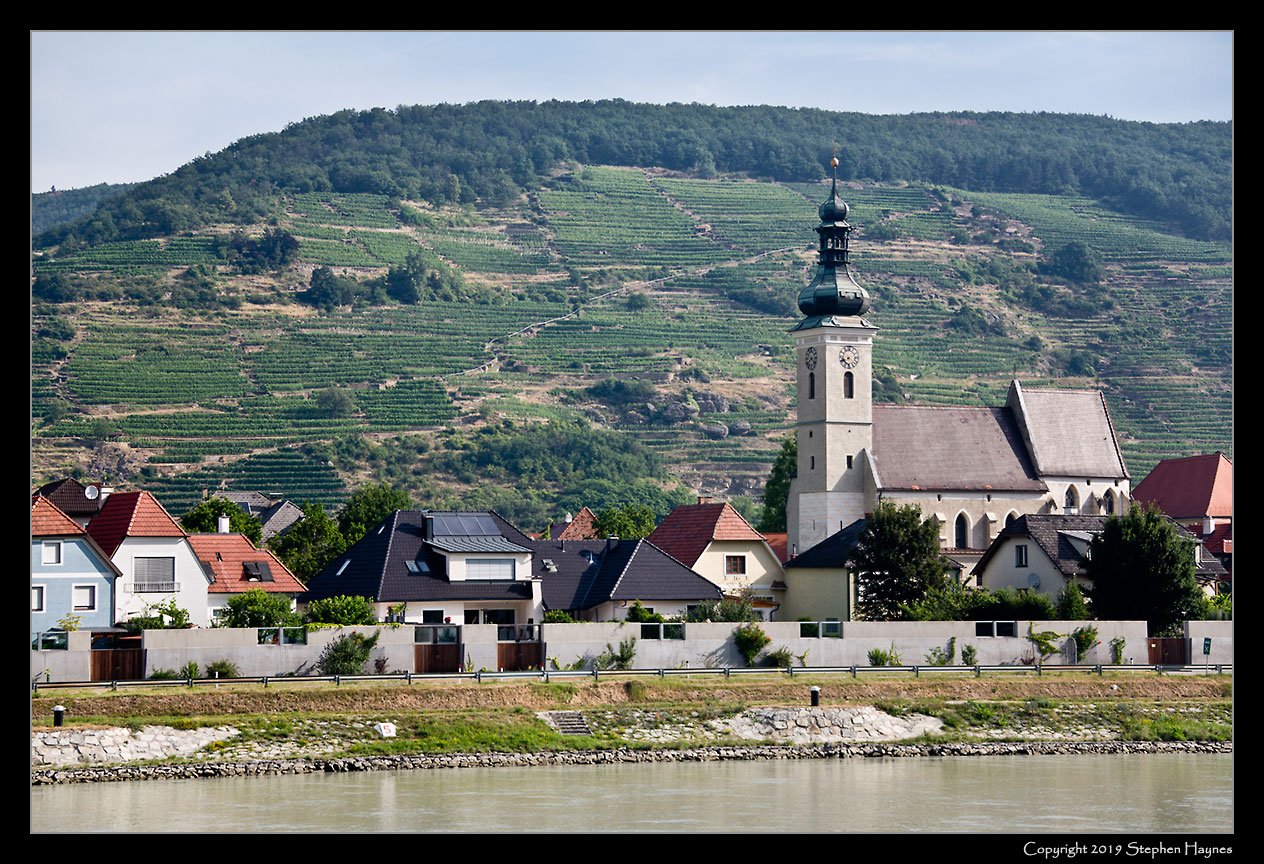
Krems an der Donau (Austria)
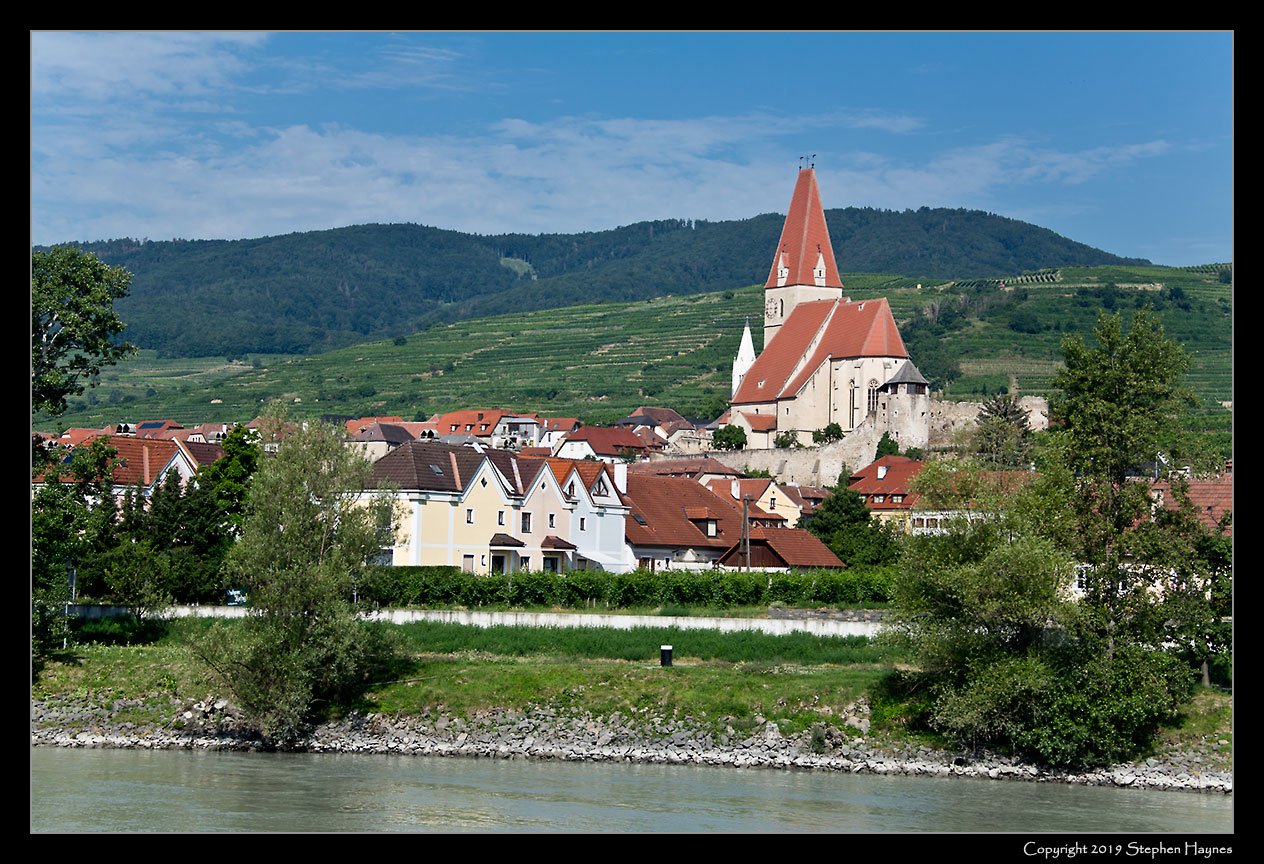
Weißenkirchen (Austria)
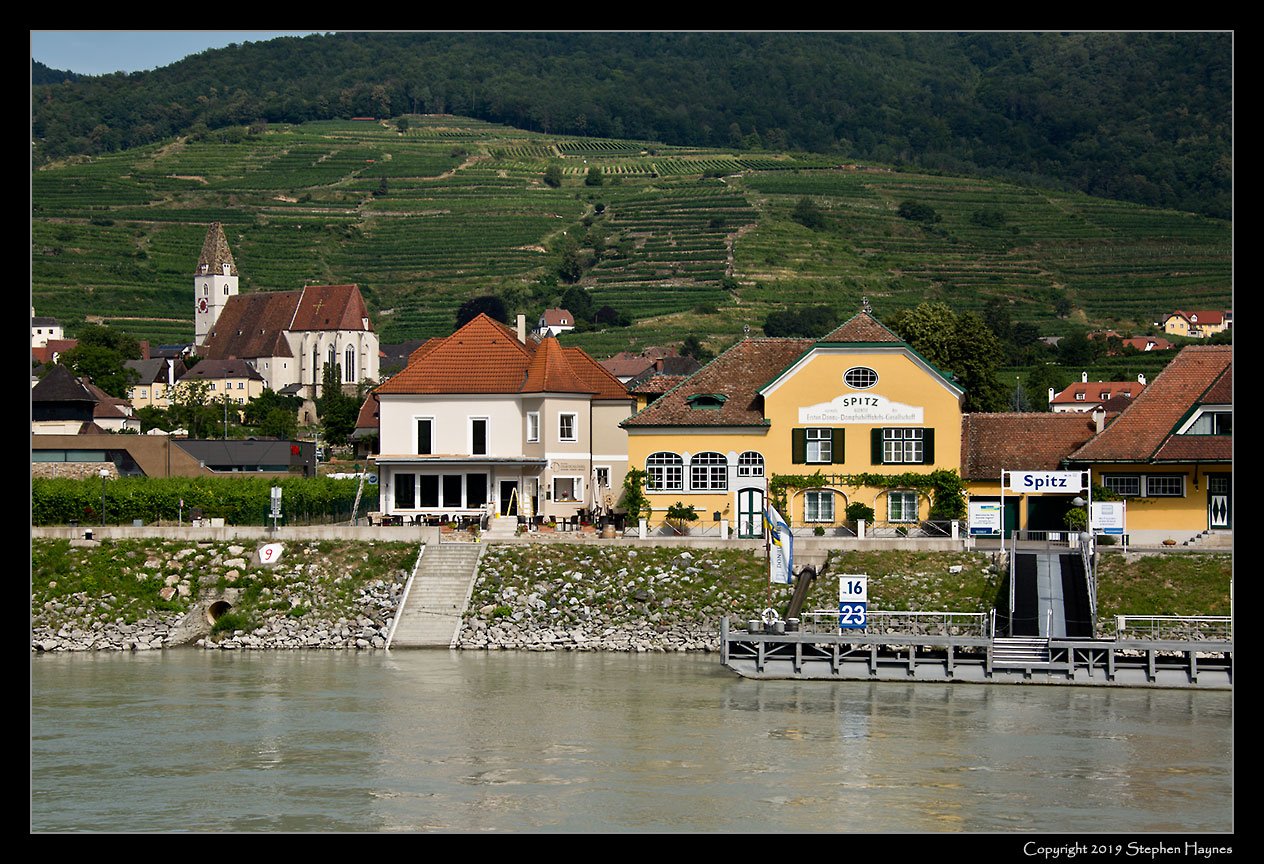
Spitz (Austria)
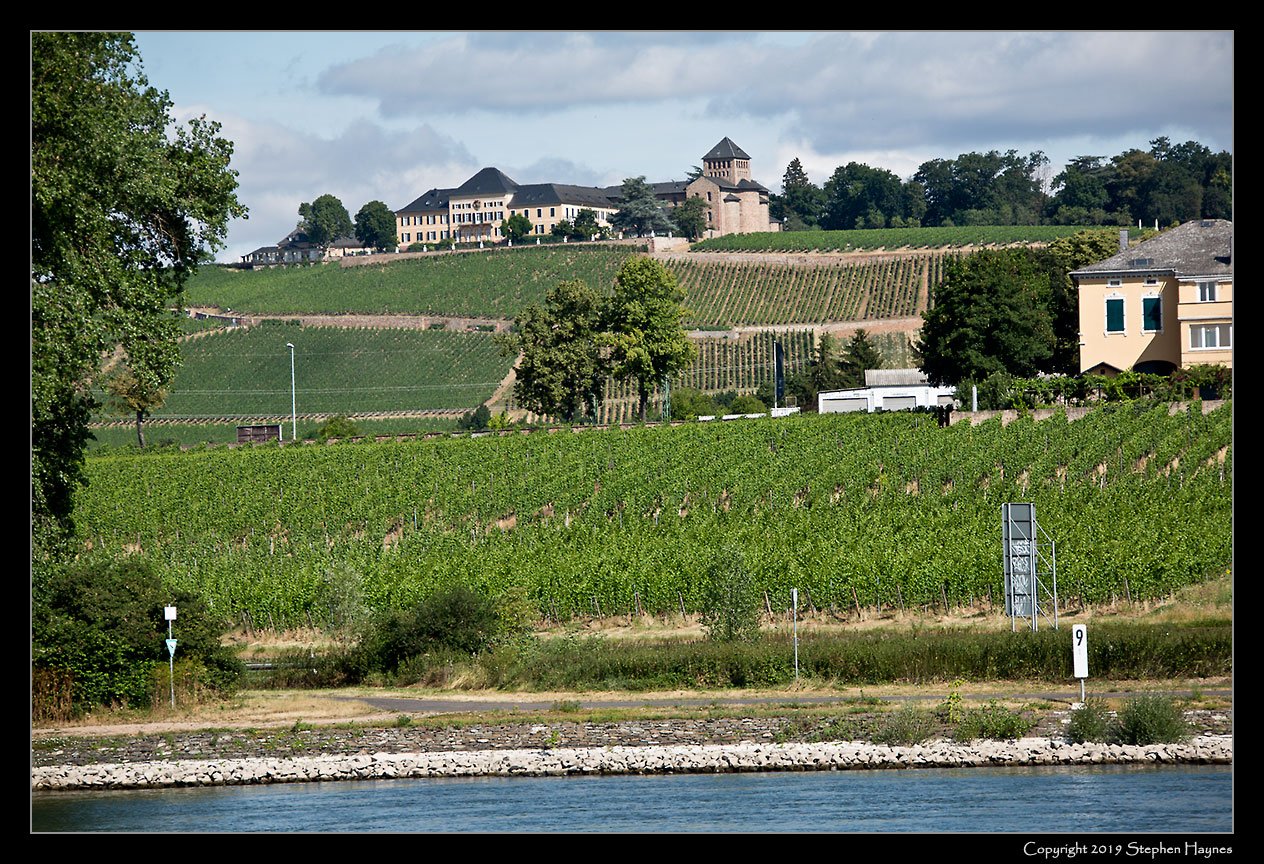
Schloss Johannisberg (German) -- Schloss Johannisberg produces some of the greatest riesling wines, or, for that matter, some of the greatest wines, period, made anywhere in the world. So frustating to be sailing by without stopping.

Niederwald Monument (Germany) -- Wikipedia: "The Niederwalddenkmal is a monument located in the Niederwald, near Rüdesheim am Rhein in Hesse, Germany. It overlooks the valley of the Rhine and was built in the 1870/80s to commemorate the Unification of Germany. "The monument was constructed to commemorate the founding of the German Empire in 1871 after the end of the Franco-Prussian War. The first stone was laid on 16 September 1871, by Kaiser Wilhelm I (William I). The sculptor was Johannes Schilling, and the architect was Karl Weißbach. The total cost of the work is estimated at one million gold marks. The monument was inaugurated on 28 September 1883. The 38 metres (125 ft) tall monument represents the union of all Germans."
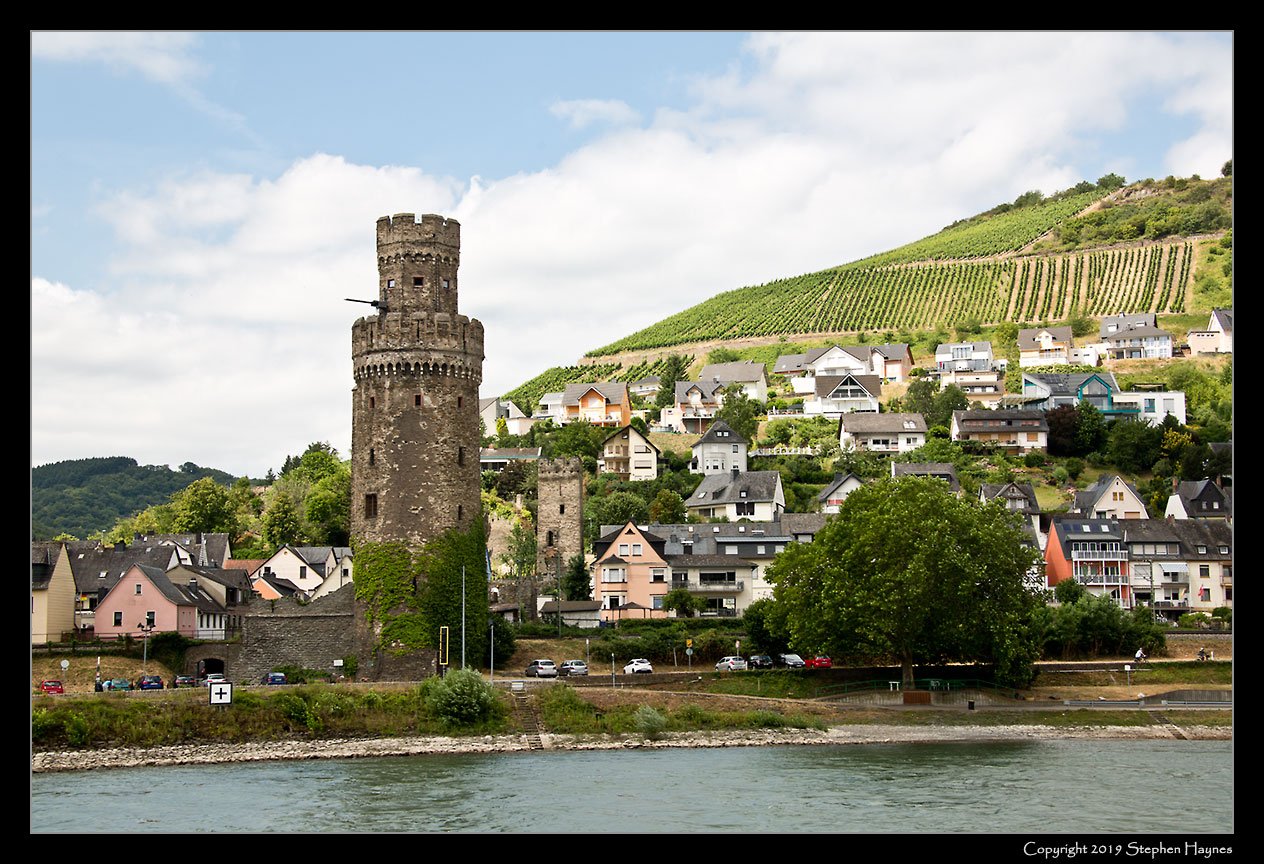
Oberwesel (Germany)
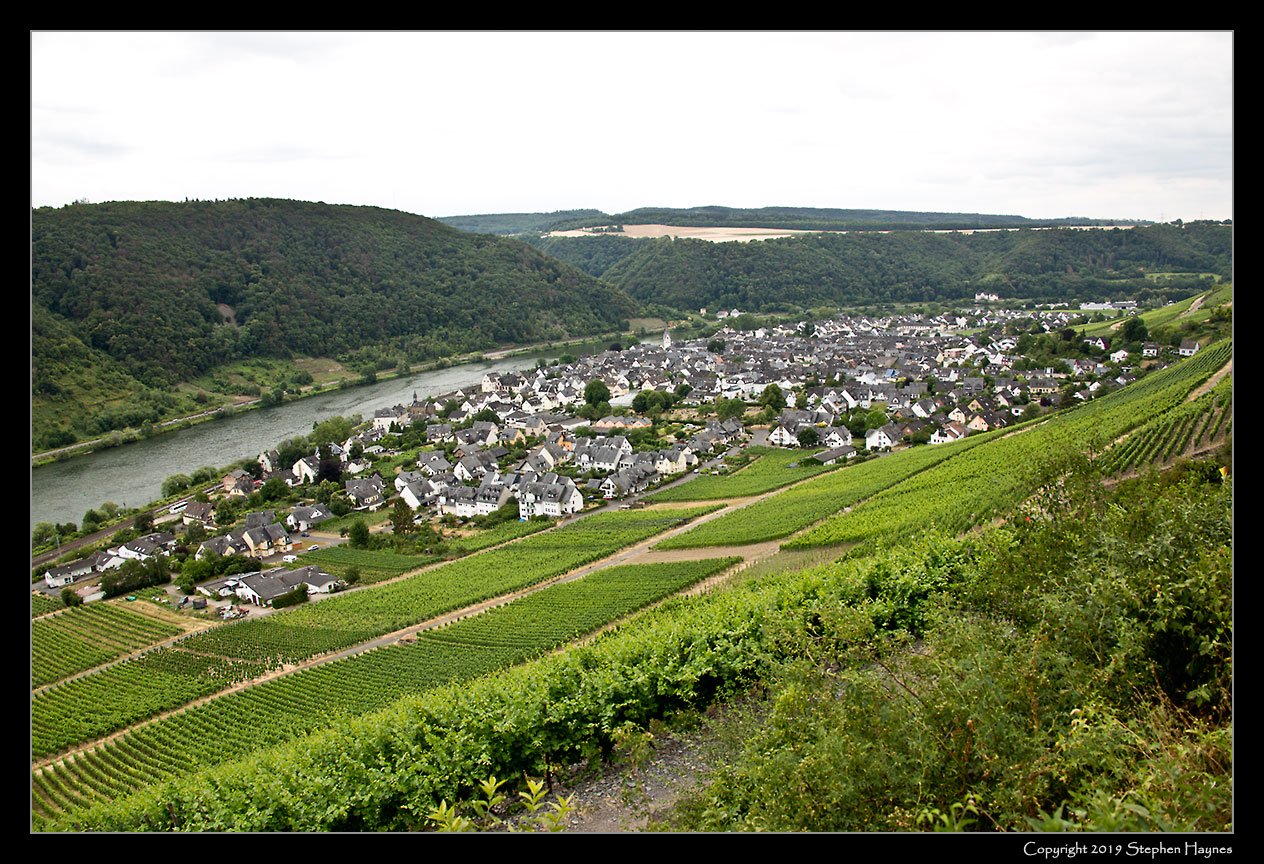
Winningen (Germany)
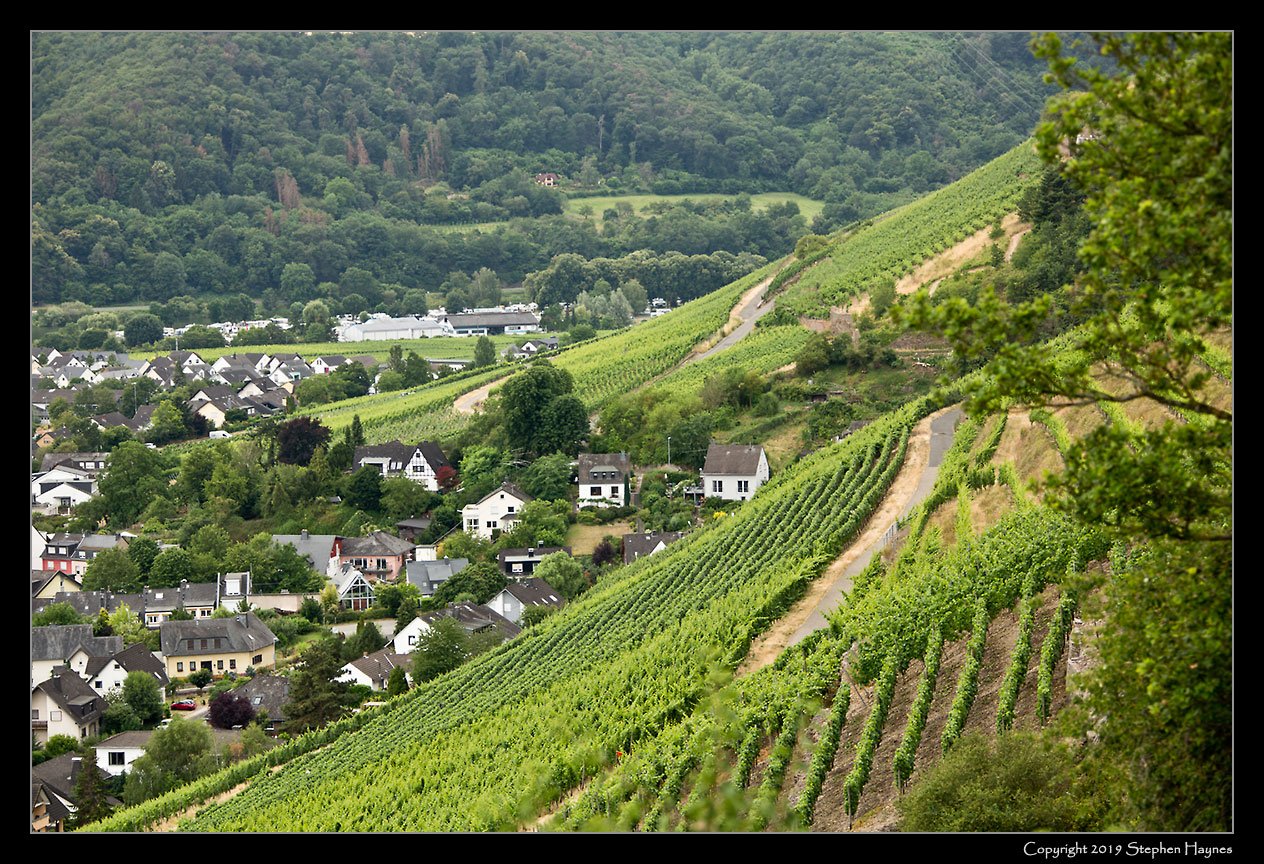
Winningen (Germany)
